
And Dana and Tom toasting on Delta Airlines!

Off to Amsterdam!
We set off (again) to tour the Rhine River and the French Riviera! \240We will start in Amsterdam and our friends Joe and Linda, Mary Ann and Willis, and Harriet will be joining us!
Here’s Joe and Linda toasting on American Airlines.

And Dana and Tom toasting on Delta Airlines!

We arrived in Amsterdam on the morning of October 5th to find a rare sunny, blue sky. \240We stowed our bags at the Renaissance Hotel and set off to explore the city. \240We’ve been to Amsterdam twice before, but never with the backdrop of this beautiful sky!

The canals reflected the blue sky and were a perfect backdrop for all the canal barge homes. Houseboats in Amsterdam are generally not motorized but moored to a fixed spot in the city. There are two kinds: a house built on a floating pontoon made of concrete. This is often called a modern “ark” (woo ark). The second kind is the old metal cargo ships that have been transformed into a houseboat. Some are still capable of sailing. These are often called a “livingship” (woonschip).

Bicycles are everywhere in the city. In fact, there are an estimated 881,000 bicycles - about 30,000 more than there are inhabitants in the city! Bikes are the primary method of getting around, and bikes have the right of way over pedestrians and motorists and there are bike lanes along the streets and canals. Pay attention when walking around Amsterdam … they will run your down if you step out in front of them!


Bike come in all sizes and all functions. \240This one was ridden by the mother of these two children who are in the front carrier. \240She had just jumped off the run into a market to grab dinner fixings!

Many of the canal house barges are more than 100 years old and retain original features alongside modern amenities, such as electricity, heating and running water. In the 1960s and 1970s, an influx of more modern houseboats appeared as a solution to increasing demand for housing. Today, luxuriously furnished houseboats, sometimes built over multiple floors and complete with adjoined terraces and gardens, can be seen all around Amsterdam’s most picturesque canals.


As the sun was setting, we wandered upon one old locks! In the twelfth century the local fishermen built a dam on the river Amstel. They named the settlement around it Amstelredamme, which means "dam in the river Amstel". The oldest known official record of that name dates to 1275 therefore it is seen as the founding date of Amsterdam.The first canals were dug as defence moats around the settlements on both sides of the river. As the city grew, new defence canals were dug in wider circles. Today, Amsterdam is surrounded by 4 concentric canals. In the golden age of the 16th - 18th centuries, canals saw heavy use for goods transportation which helped enormously with city commerce. But these days, they are mainly a curiosity and a tourist attraction.

Our friends from 30A, Joe and Linda, joined us in Amsterdam for the first part of our adventure, and we headed out for an early dinner at “Mr. Meat”.

They definitely had the inventory for us! We had a great meal and headed back to catch up on sleep!


The Rijksmuseum
Joe, Tom and I toured the Rijksmusem this morning.The Rijksmuseum is the national museum of the Netherlands dedicated to Dutch arts and history.

The Rijksmuseum was founded in The Hague on November 19, 1798 and moved to Amsterdam in 1808, where it was first located in the Royal Palace and later in the Trippenhuis (neither of which we saw on this trip!) The current main building was designed by Pierre Cuypers and first opened in 1885 and it is the largest museum in the Netherlands.
One of the first pieces we saw is the Tree of Jesse by Geertgen tot Sint Jans, in 1500. This tree is a depiction or the ancestors of Jesus Christ and is the original use of the family tree as a representation of genealogy.

We did a 2 hour tour with our guide, Merle, who wove us through most of the art galleries, showing us some of the more famous pieces. But this double panel painting, while not a masterpiece, was one of her favorites because it depicts the time when one of the dykes failed and the city of Amsterdam was flooded.

Here stands a room-sized replica of the tall ships that used to sail here. Thousands were manufacturered in Amsterdam and many others sailed here … one of the largest trading ports in all the world!

The museum has on display 8,000 objects of art and history, from their total collection of 1 million objects from the years 1200–2000, among which are some masterpieces by Rembrandt, Frans Hals, and Johannes Vermeer. \240Here is Rembrandt’s “The Militia Company of District VIII under the Command of Captain Roelof Bicker”

And Rembrandt’s 1662 “Syndics of the Draper’s Guild” looking just like we’ve opened the door into their secret discussions!

Realistic painting styles were the rage in the 1600s and this painting by Willem Claesz Heda, “Still Life with a Gilt Cup” (circa 1635) is certainly a classic. \240Heda is considered the “master of the lemon” as evidence by the details in the lemon peel. Notice the fingerprints on the water glass. The 17th century was a time of great wealth in Amsterdam which started the first stock market! Notice the stock note on the tray in the front right of the painting.

“The Windmill at Wijk bin Duurstede” by Jacob Van Ruisdael (ca. 1668) is another example classic Dutch painting in the Golden Age. Ruisdael is know for his clouds which seem about to tumble out of his paintings!

Frans Hans “The Merry Drinker” (Ca. 1628 - 1630)

Here is Vermeer’s “The Milkmaid”

Here is the only Van Gogh in the museum, a self portrait. Van Gogh was Dutch and tried repeatedly to get into the art school at The Hague. But the masters felt he was not talented and he was never accepted. \240He moved to Paris to live with his brother who ran an art store where some of this paintings were sold. Later he moved to Arles, France where he painted most of his works.

Another masterpiece that stands at the harbor is the Amsterdam Central train station! This was our beacon as we traveled around town. Our riverboat is docked just behind! From here, you can get to pretty much anywhere in Europe!

Jewel Dinner Cruise of Amsterdam Canals
We took a dinner cruise on an old canal boat. We’ve taken this trip twice before and its a wonderful way to see the canals. Originally built in Germany in 1898 as a ferry, this small “jewel” did not disappoint!



The Market, The Windmills and The Wooden Shoes
Whatever you want … vegetables, bread, cheese, sausage, octopus, squid, fish, shoes, linens, clothes, flowers … you can find it at the market!







Out in the Countryside
Just a short distance from Amsterdam you are in the Dutch countryside! \240These windmills are still operational and the clouds look just like a Rijksmuseum masterpiece!


Wooden shoes are a Dutch invention and quite necessary for working in the marshy ground! \240These shoes are particularly decorative, but the working man’s shoes are plain and functional!

Although it’s useful to find your correct size!
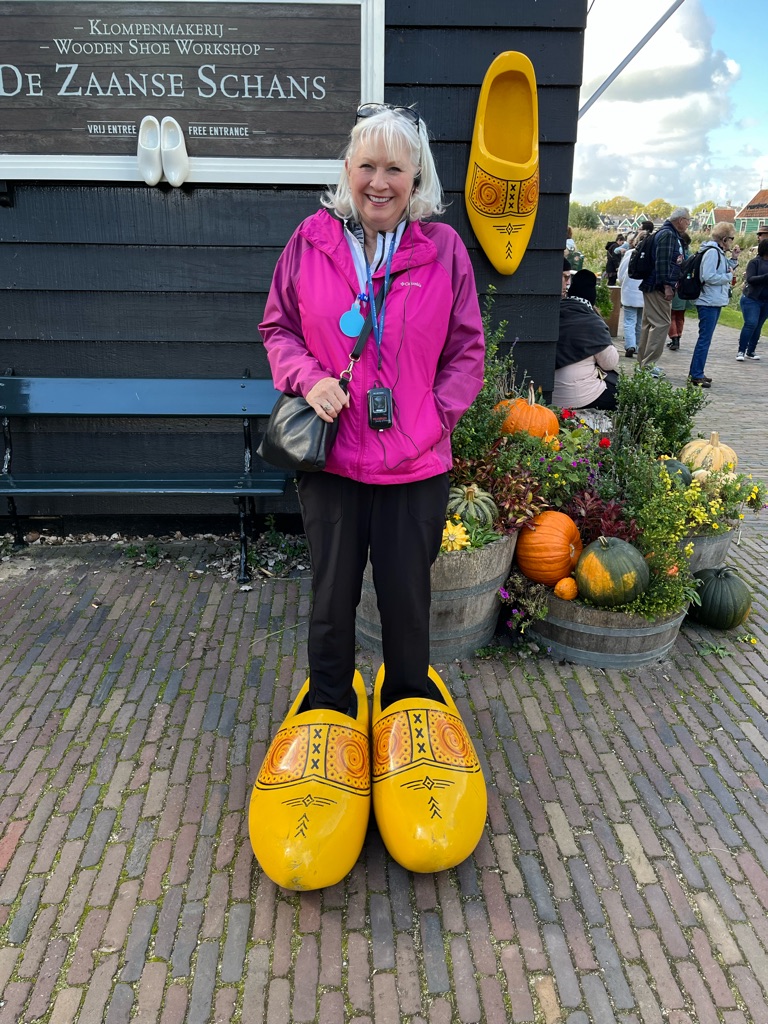
Here a Joe plays the part of the landowner, overseeing his windmills!

Sailing Away
Tom and Willis getting ready to board!
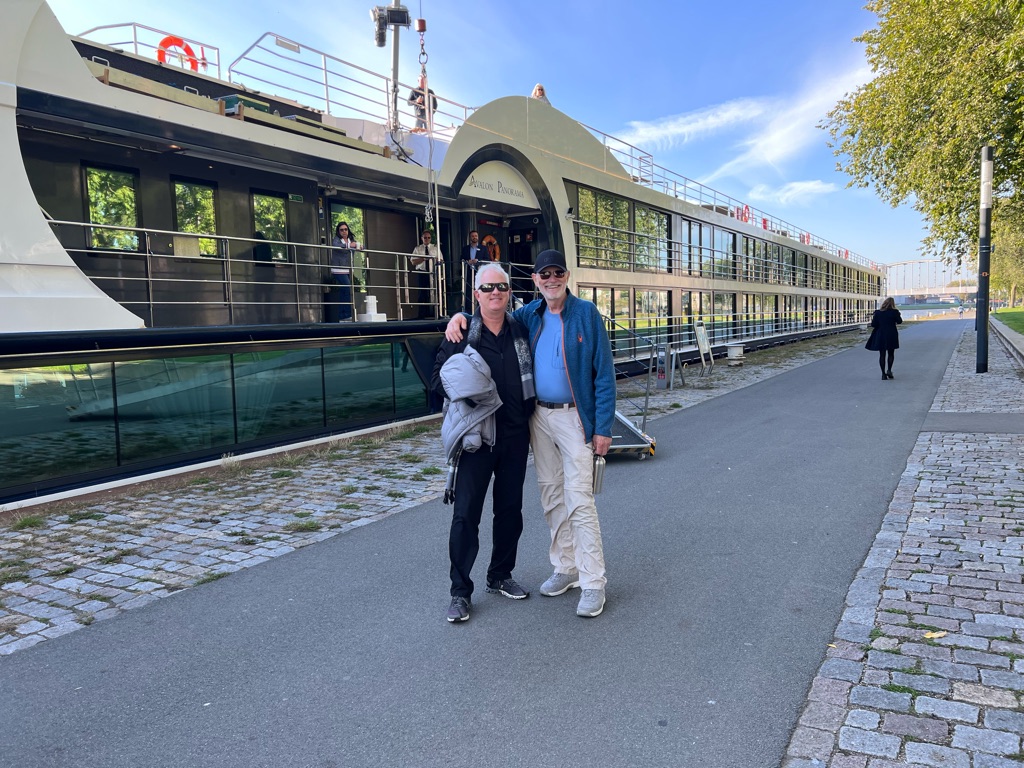
Heading into our first lock.
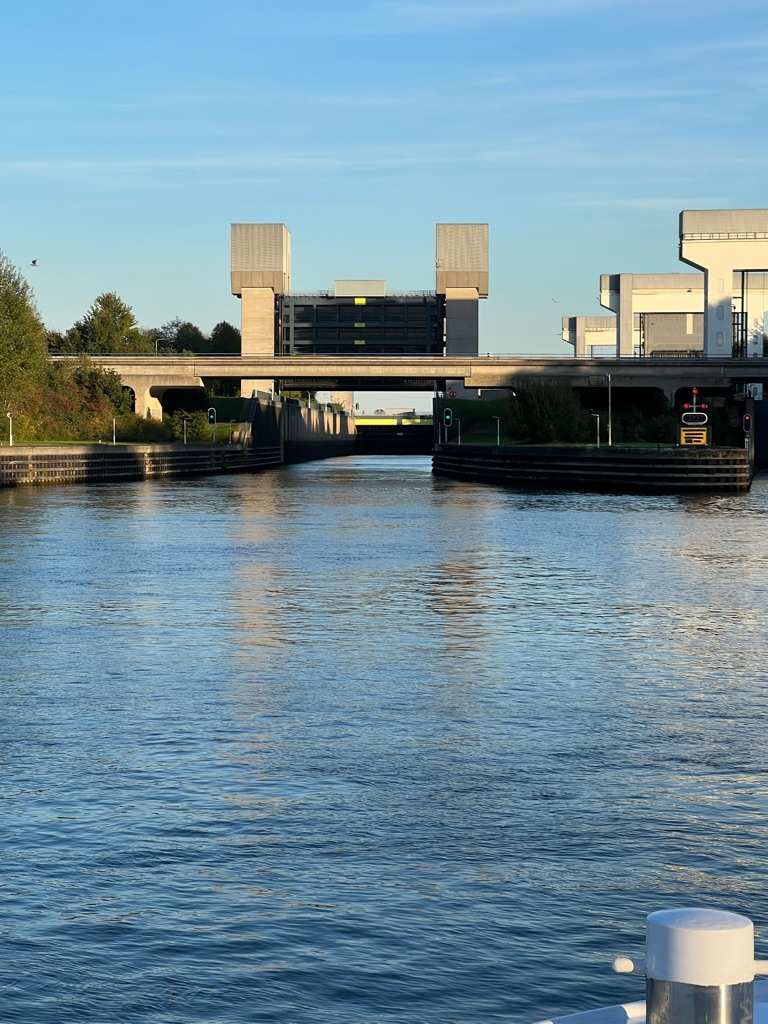
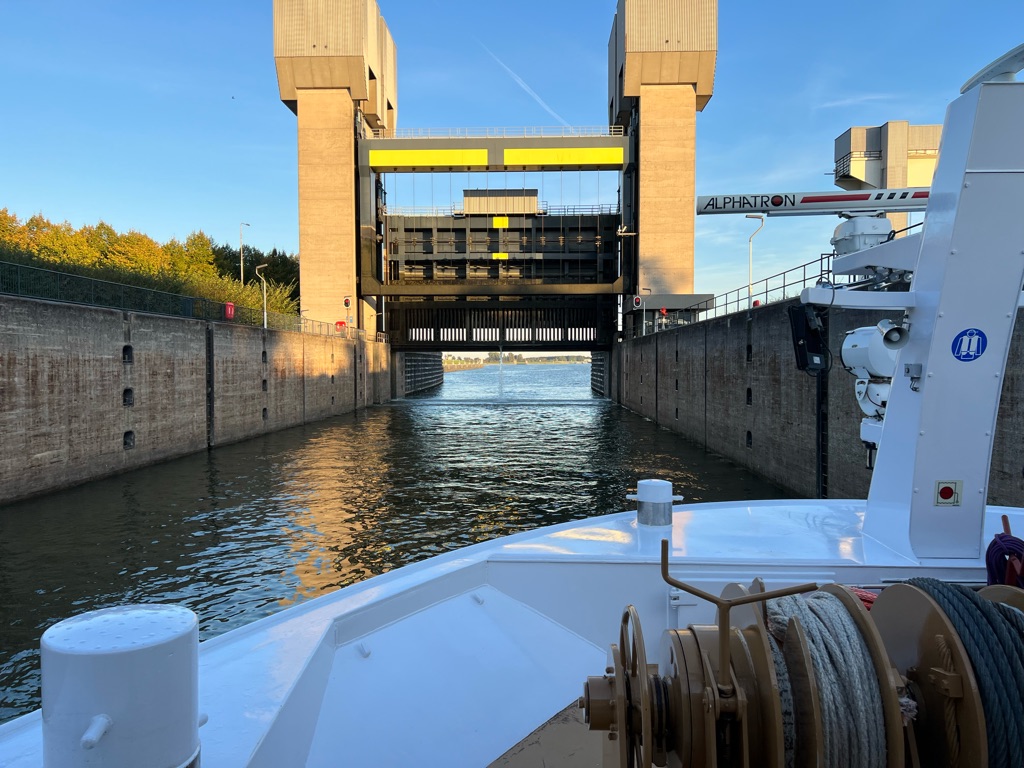
Watch closely to see how fast we rise!

And later, while as are underway, we were treated to a gorgeous full moon lighting our way up the river.

Canals and a Castle
For our last day in Amsterdam, we took a canal cruise, a walking tour, and traveled to a medieval castle. It was a very full day! Here we are getting on our canal cruise in the heart of the port, just down from our ship.

Look closely and you can see 7 bridges all lined up!

Amsterdam is built on wooden pilings hammered into the swampy clay. \240It’s held up pretty good seeing as most of the old city is 400 years old! But before the salt water bay (Zuiderzee) was closed off to become a lake, the town sometimes flooded and other times shrank, exposing the wooden pilings. When the pilings were exposed to oxygen, they would begin to decompose, causing the buildings to list. Today, damaged pilings are replaced with ones made of cement, but the process is less problematic since a dyke was built in the 1800s to close off the lake from the sea.

An enterprising student came up with the idea of “leasing” bicycles. For 20 Euros a month, if it is damaged or stolen, you get a new one delivered - no hassle! The “leased” bikes all have a blue font tire, and we saw them everywhere!

Canal houseboats come in all sizes and shapes!

Willis, Mary Ann, Tom and Dana heading into the Muiderslot Castle. Built by Count Floris V in 1280 at the mouth of the Vecht river which was the trade route to Utrecht, one of the most important trading towns of that age.

The castle was destroyed and rebuilt in the 1300s using the same design. It was owned by P.C. Hooft in the 1500s and then lay derilect for nearly 100 years. Today, it is a national museum restored and housing furniture from the 1700s along with a collection of arms and armor.

Interestingly, this small canopy bed is the “family” bed. \240Back in the 1600s, people slept sitting upright and the entire family, parents and children, slept sitting up in the bed together. The heavy canopies would keep the occupants warm at night, and if it got to hot, you could pull a cord and vent the top. Our guide said that apparently people thought that if you slept laying down, too much blood would rush to your head and cause you to go insane. But babies could sleep laying down safely, so they got their own cradle.

The kitchen in the fancy eating room!

Here is the “Knight’s Room” where affairs of the owner were managed. Note the paintings from the 1600s.

Cologne, Germany
We traveled up the Rhine river overnight and into the day to reach Cologne - our first stop in Germany.
Here is Tom, ready for our tour!

Here is our riverboat at rest in Cologne, which the Germans call Köln.
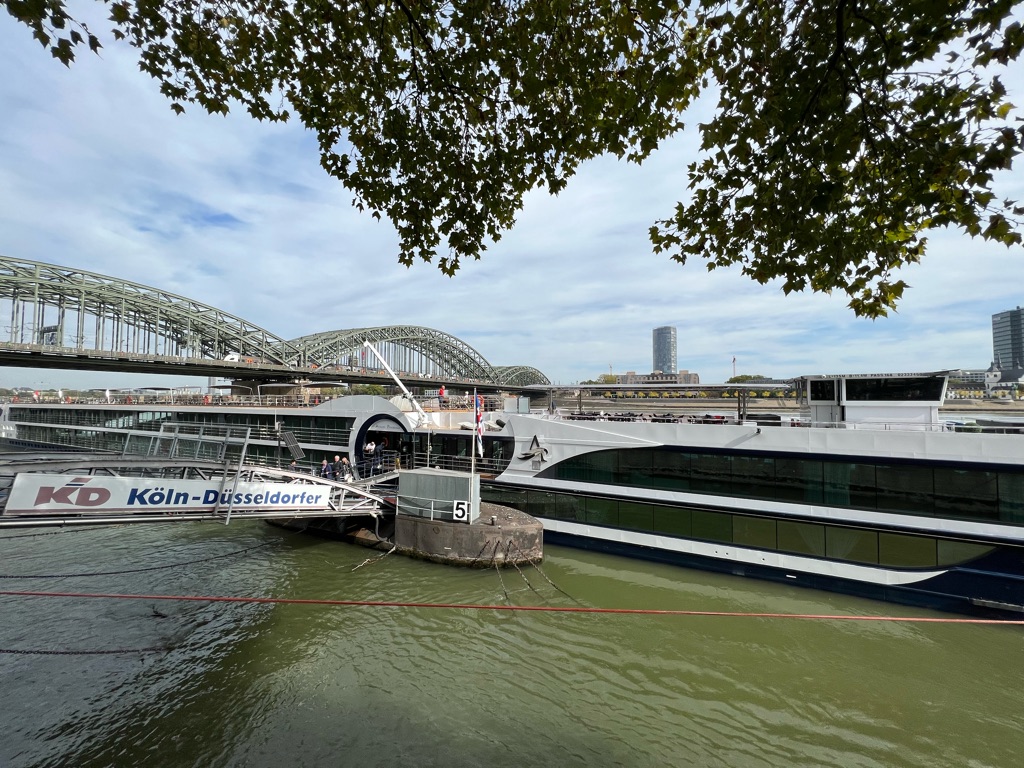
The Great St Martin Church in Cologne towers above the houses along the river in a fairy tale fashion! The houses are designed similarly to those in Amsterdam although they were built after WWII when much of the city last in ruins.

Willis has found the two local inhabitants of Cologne’s Old Town. , These two bronze statues, Tünnes and Schäl, are legendary figures from the Hännes Dolls’ Theatre. The noses of Tünnes and Schäl have been rubbed until they are shinny \240gold as that is supposed to bring you good luck.
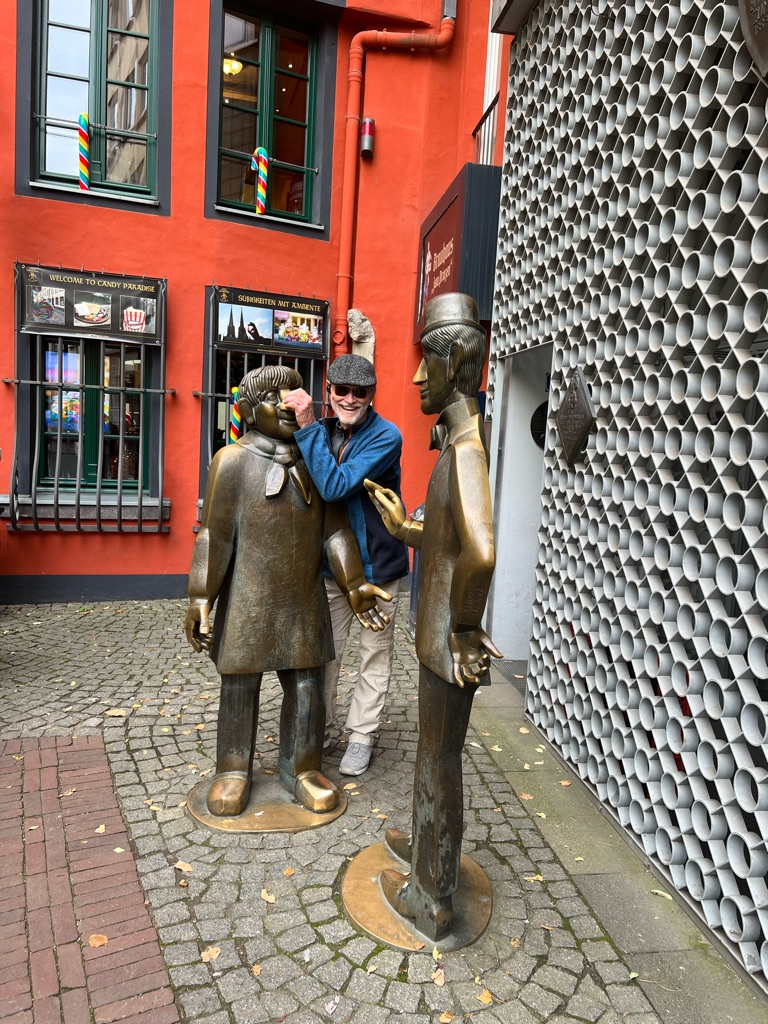
This statute, called Kallendresser, \240is located at the top of a 5 story building on the old market square. It depicts a rather naughty boy with his pants down …. Either mooning the cries of perhaps taking a poo! The rumors abound! The original statue was carved in wood hundreds of years ago but was later destroyed. This version cast in bronze was carved by Edward Mantare in 1956.

We came across this figure in a small square close to the cathedral. It is Statue of the Schneidersfrau (woman of the tailor) on top of the Heinzelmaennchen fountain. The Heinzelmännchen is an old German tale about little gnomes that did the work of the citizens of Cologne Germany during the night so the citizens could be lazy during the day. Eventually the tailor's wife (Schneidersfrau) scattered peas onto the floor to make the gnomes slip and fall. The gnomes disappeared and never returned. You may have heard of a similar story in the Grimm’s Fairytale \240Elves and the Shoemaker.
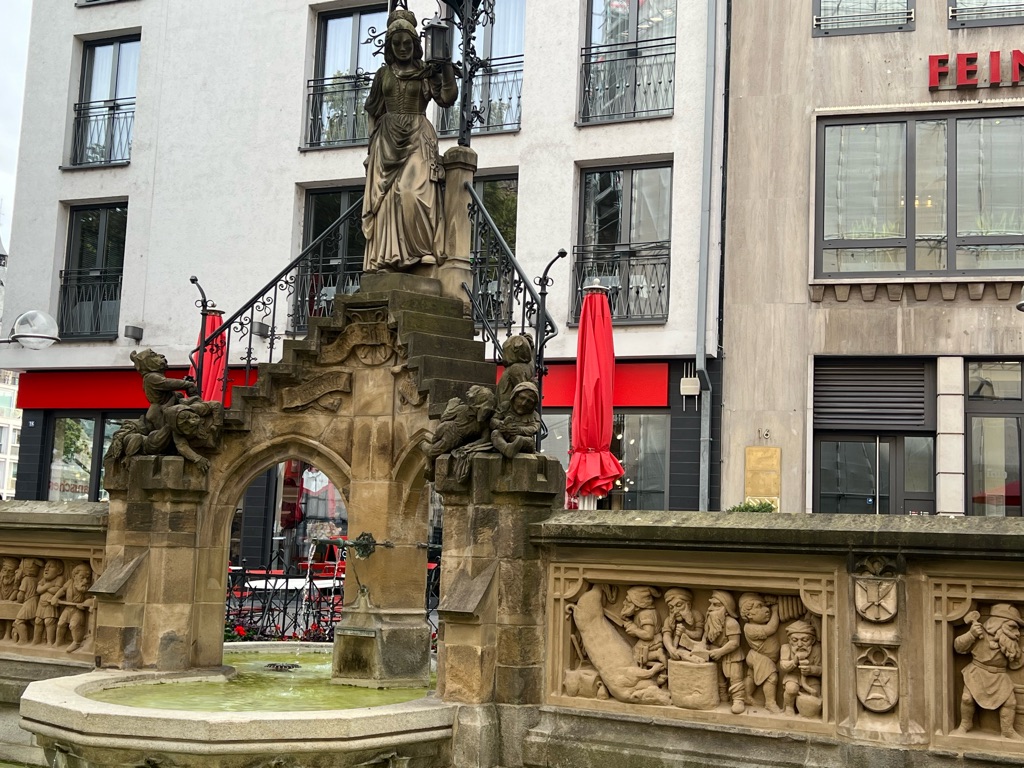
The Cathedral is a renowned monument of German Catholicism and Gothic architecture and was declared a World Heritage Site in 1996 It is Germany's most visited landmark, attracting an average of 20,000 people a day. At 515 ft tall, the cathedral is the tallest twin-spired church in the world, the second tallest church in Europe \240and the third tallest church of any kind - at least until La Famiglia in Barcelona is completed!



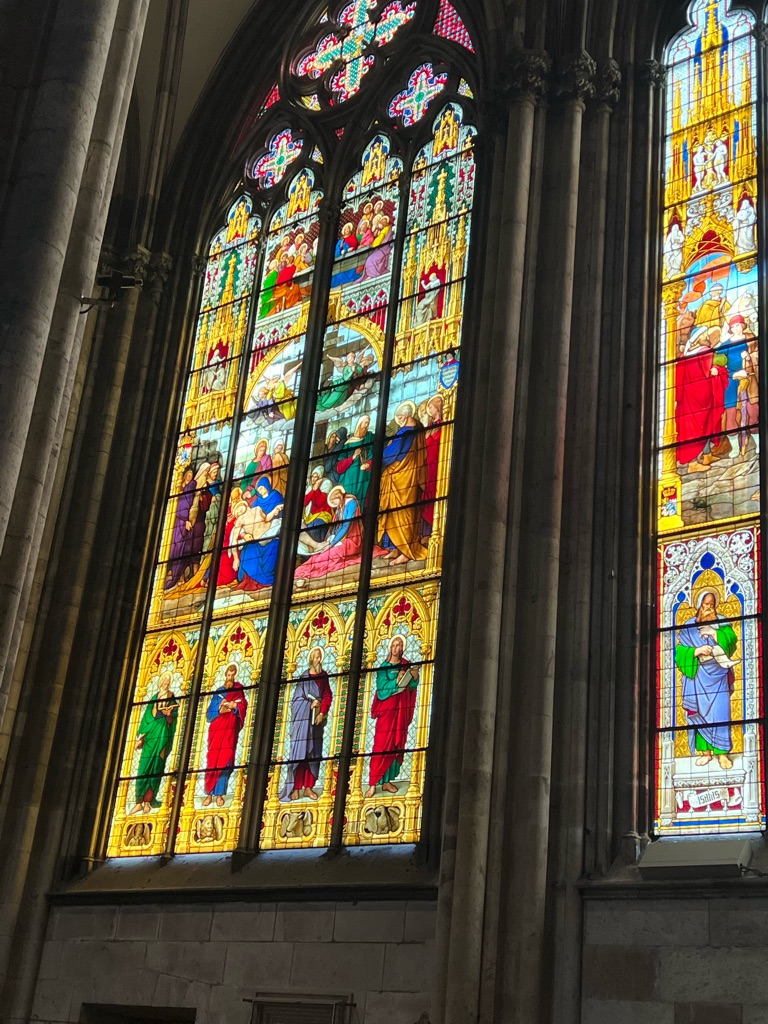

Outside the cathedral we saw several street artists who drew the flags of different countries in a circle on the ground. People would toss coins on the flag of their home country. However, \240in these times, Ukraine was getting the most coins. I’m sure the street artists took home the coins at the end of the day. It’s a good gig!
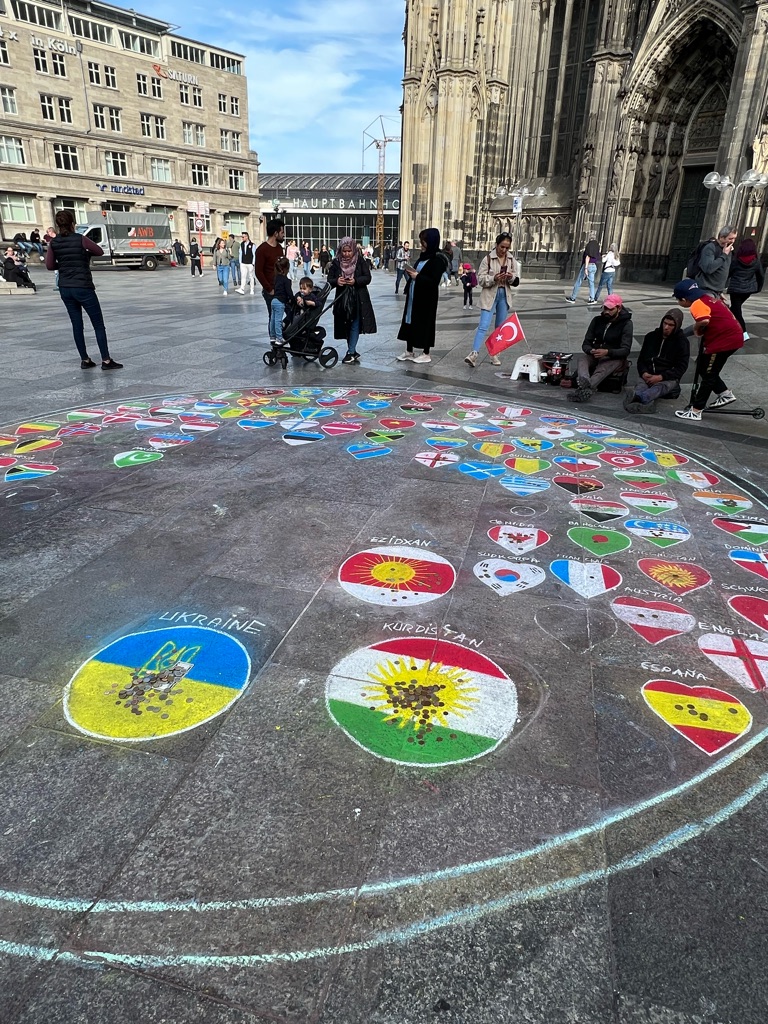
We haven’t taken too many pictures of our travel group, so here we are: Willis, Mary Ann, Dana, Tom, Harriet, Linda and Joe!!
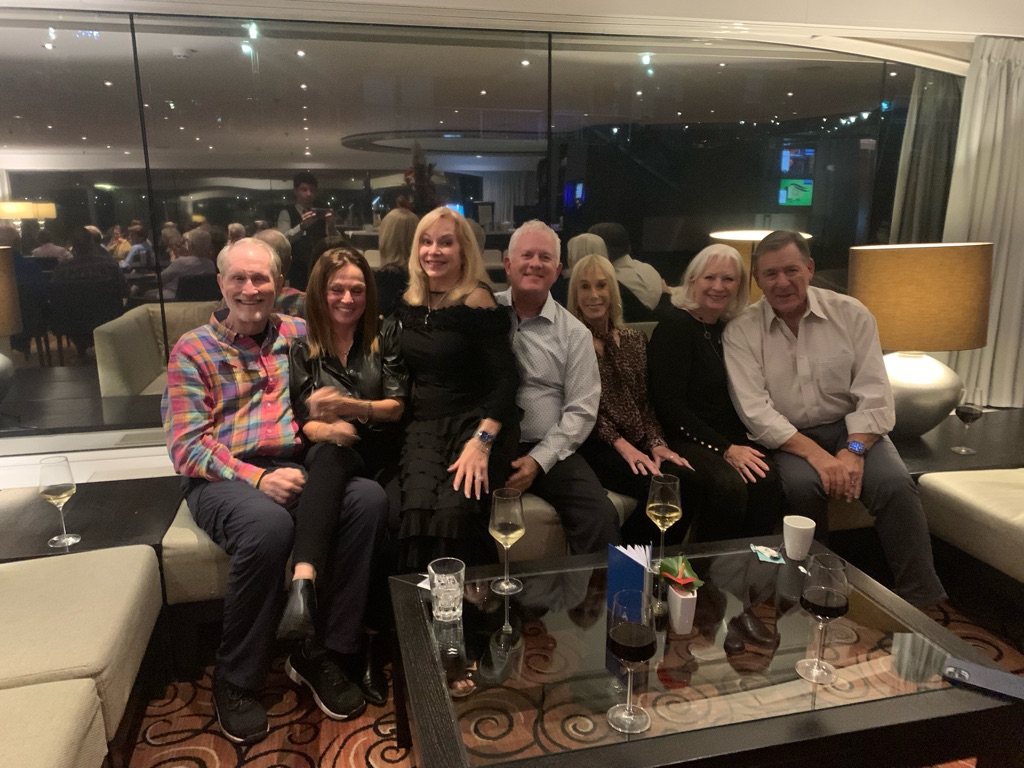
Castles of the Rhine
We started our trip up this section of the Rhine on a cool, foggy morning. Most of the castles were built between the 13th century and existed to extract tolls from the ships transporting goods up or down the Rhine river. Today, they are surrounded by small villages and vineyards and are one of the most beautiful sites in any river cruise.

Our first castle headed upstream was the Maus Castle.

Rheinfels Castle (German: Burg Rheinfels) is a castle ruin located above the left (west) bank of the Rhine in Sankt Goar, Germany. It was started in 1245 by Count Diether V of Katzenelnbogen. After expansions, it was the largest fortress in the Middle Rhein Valley between Koblenz and Mainz. It was slighted by French Revolutionary Army troops in 1797. It is the largest castle overlooking the Rhine.
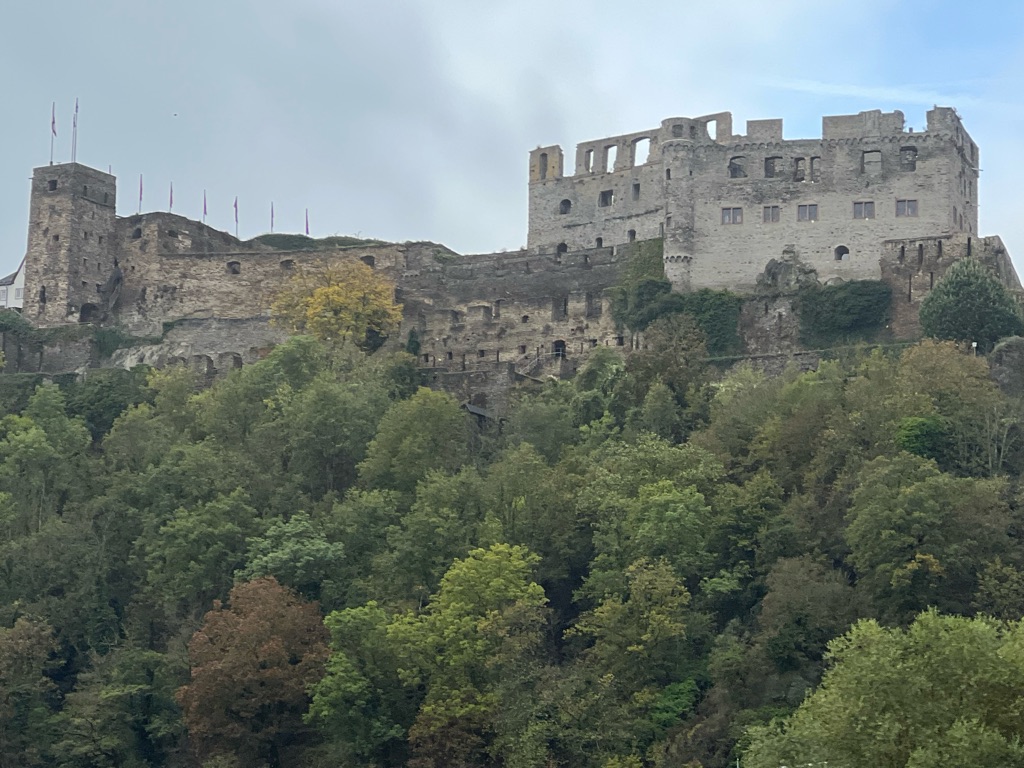
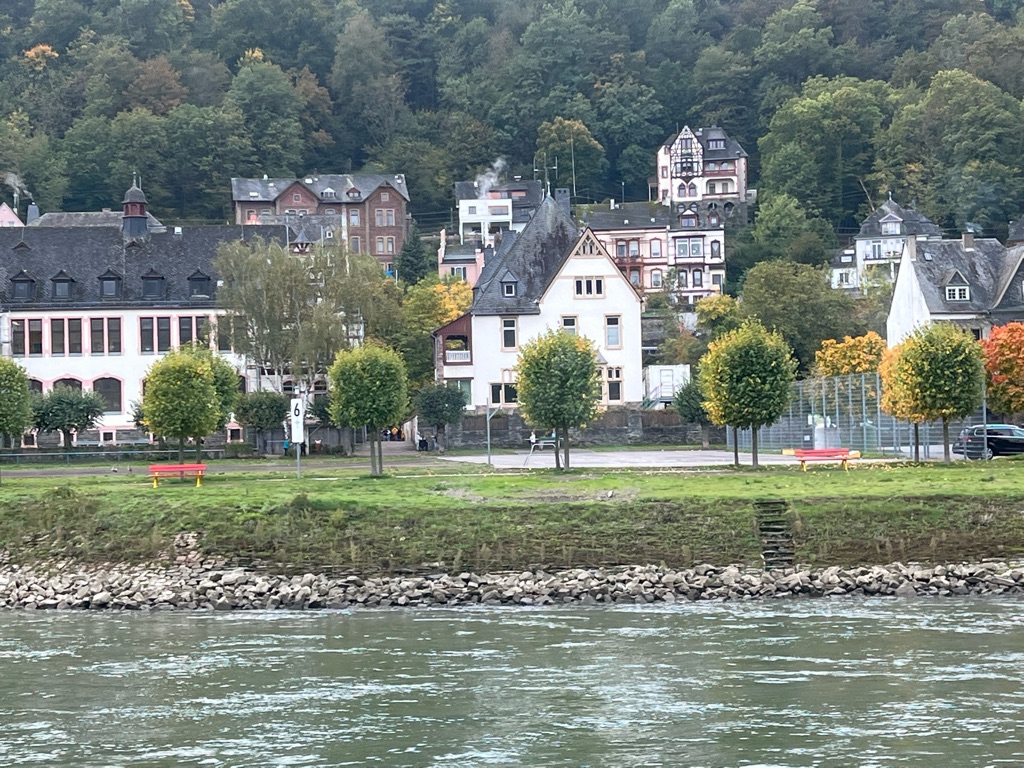
Katz Castle (German: Burg Katz) is a castle above the German town of St. Goarshausenin Rhineland-Palatinate. The castle stands on a ledge looking downstream from the riverside at St. Goar. It was first built around 1371 by Count William II of Katzenelnbogen. The castle was bombarded in 1806 by Napoleon and rebuilt in the late 19th century, in 1896–98. It is now privately owned, and not open for visitors.
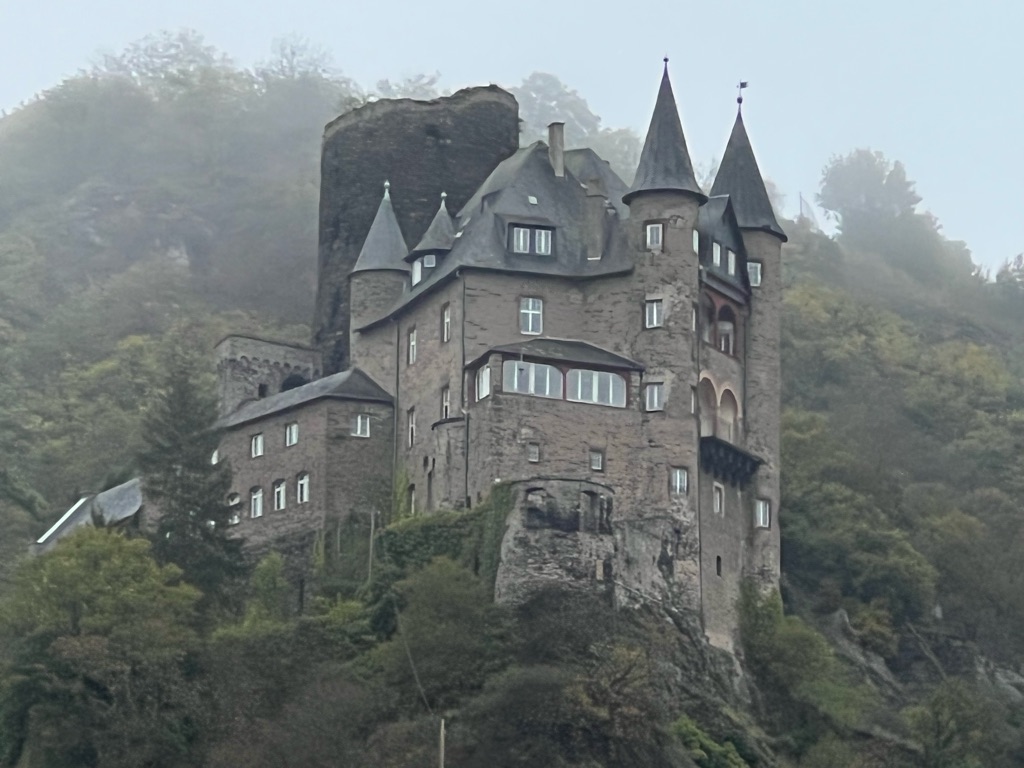

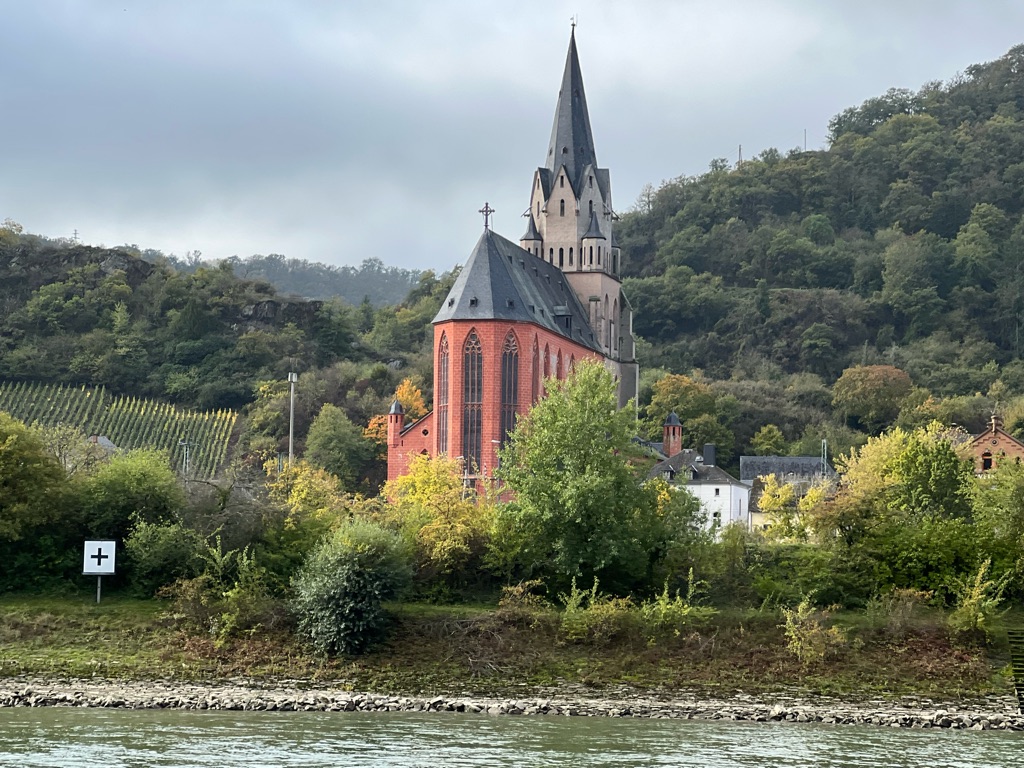
The Schoenberg Castle our Oberwesel Castle, a middle-ages Castle renovated by a German-American, Mr. Rhineland, I’d note a highly rated hotel and conference center.

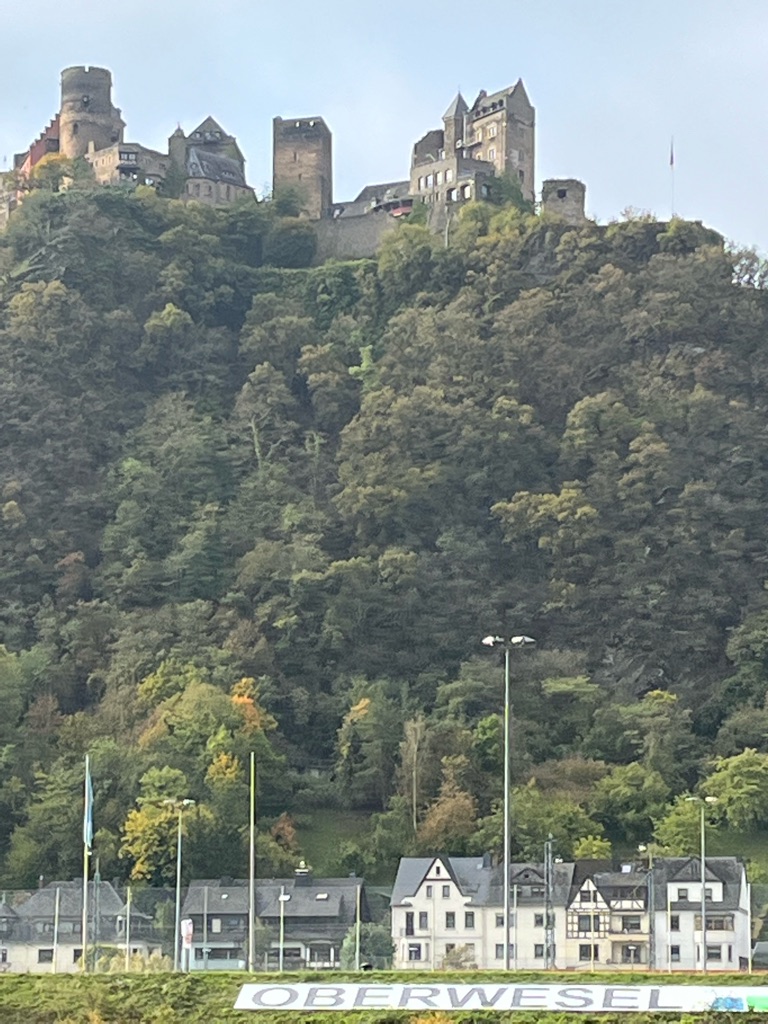
Workers harvesting the grapes on a 45 degree grade!
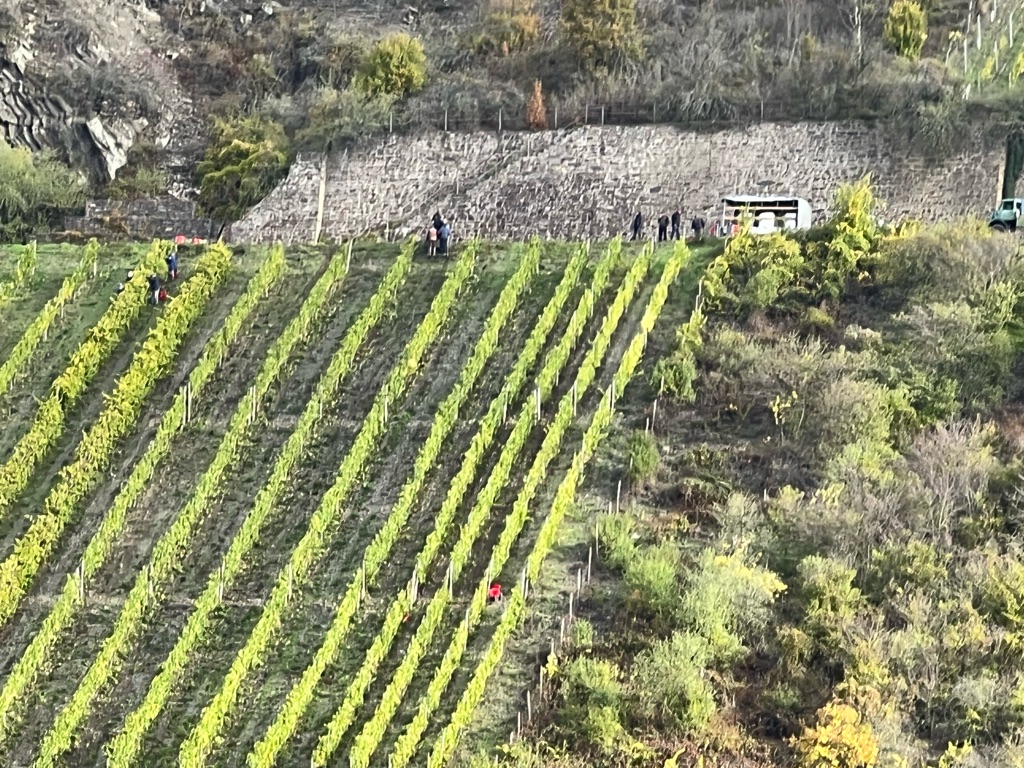

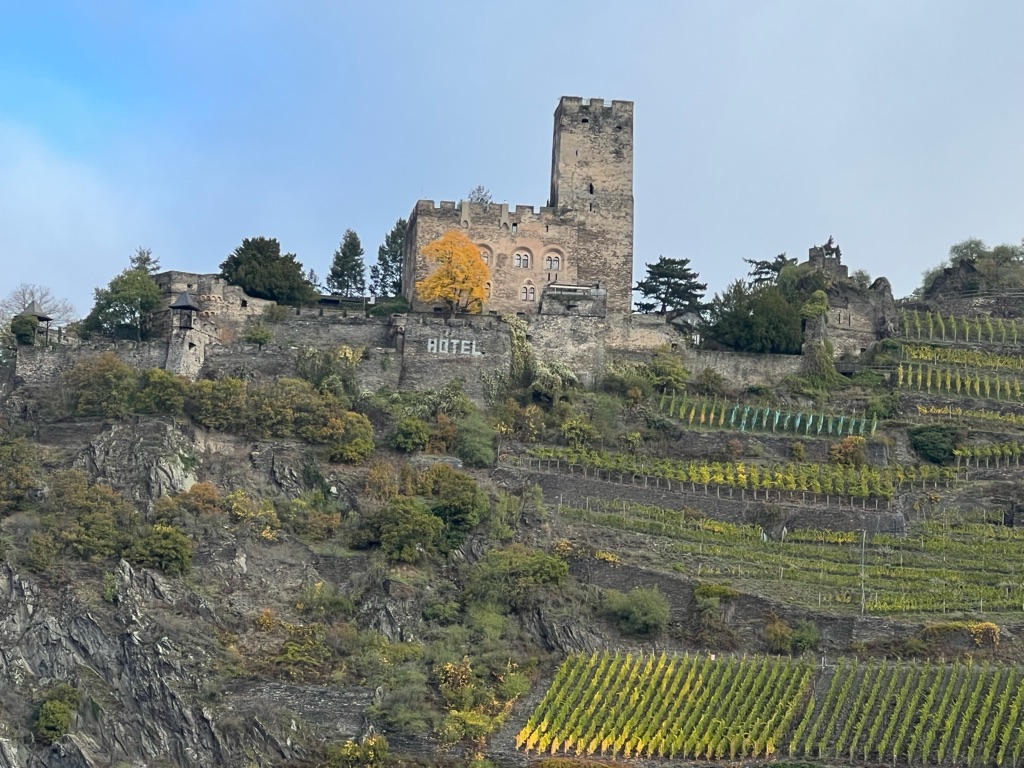
The Pfalzgrafenstein Castle(German: Burg Pfalzgrafenstein) is a toll castle on the Falkenau island, otherwise known as Pfalz Island in the River Rhine near Kaub, Germany.

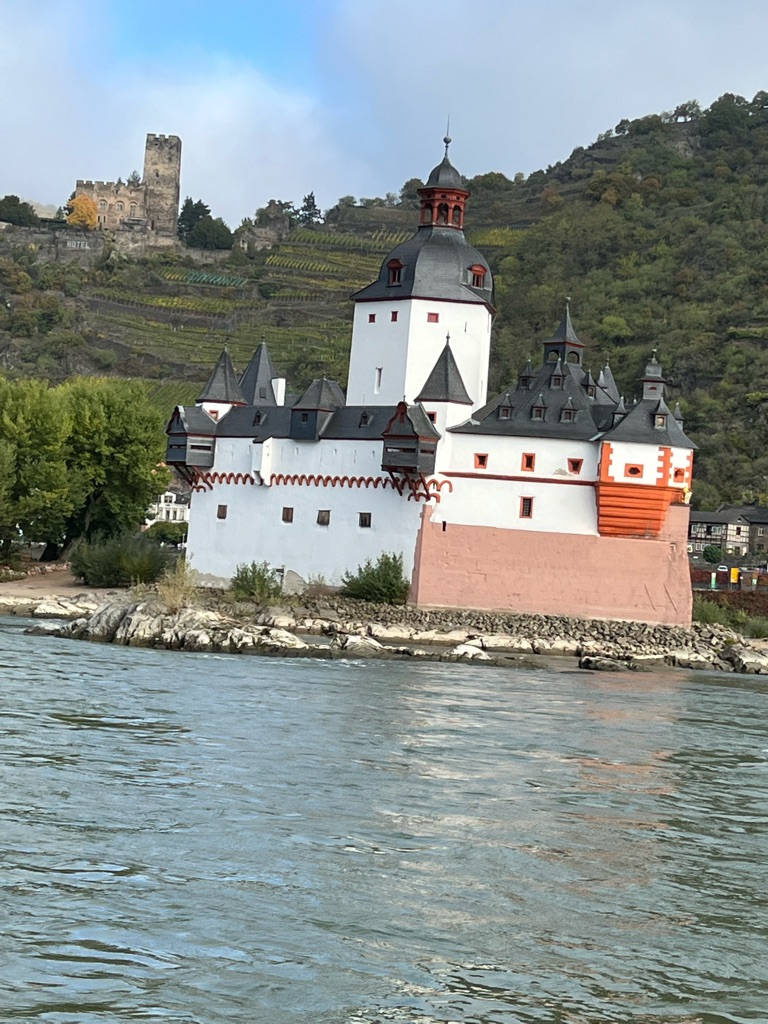
Here are our brave photographers!



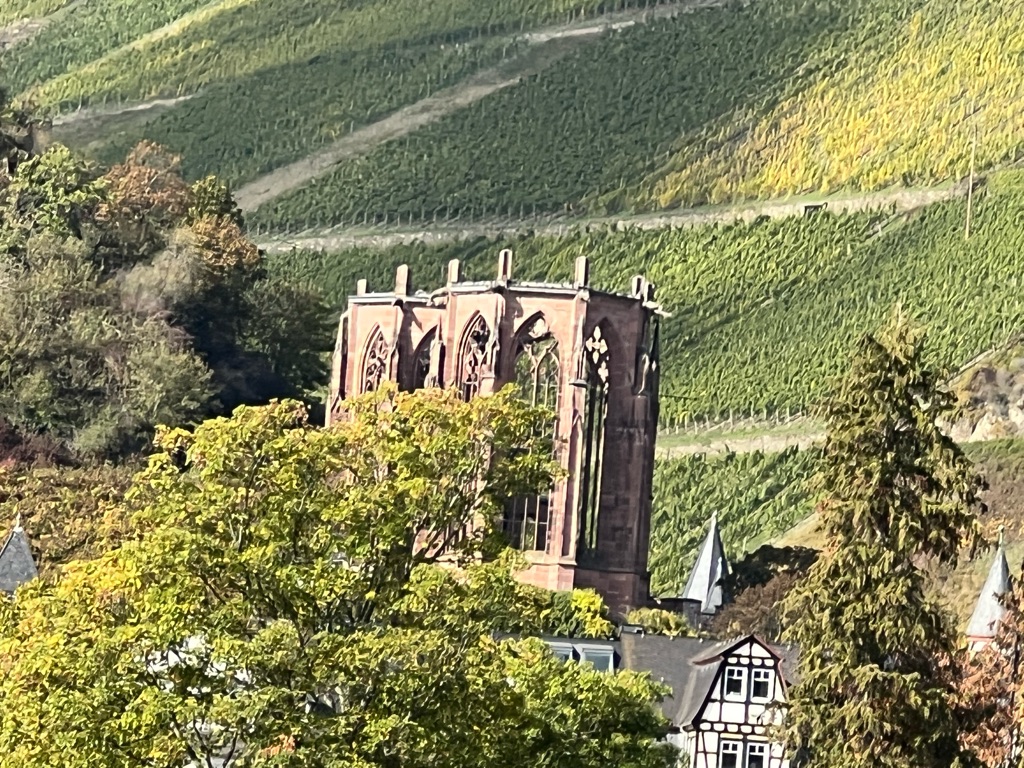
The Bacharach Fortress, also known as Stahleck Castle (German: Burg Stahleck) is a 12th-century fortified castle in the Upper Middle Rhine Valley at Bacharachin Rhineland-Palatinate, Germany. It stands on a crag approximately 160 metres (520 ft) above sea level[1] on the left bank of the river at the mouth of the Steeg valley, approximately 50 kilometres (31 mi) south of Koblenz, and offers a commanding view of the Loreleivalley. Its name means "impregnable castle on a crag",

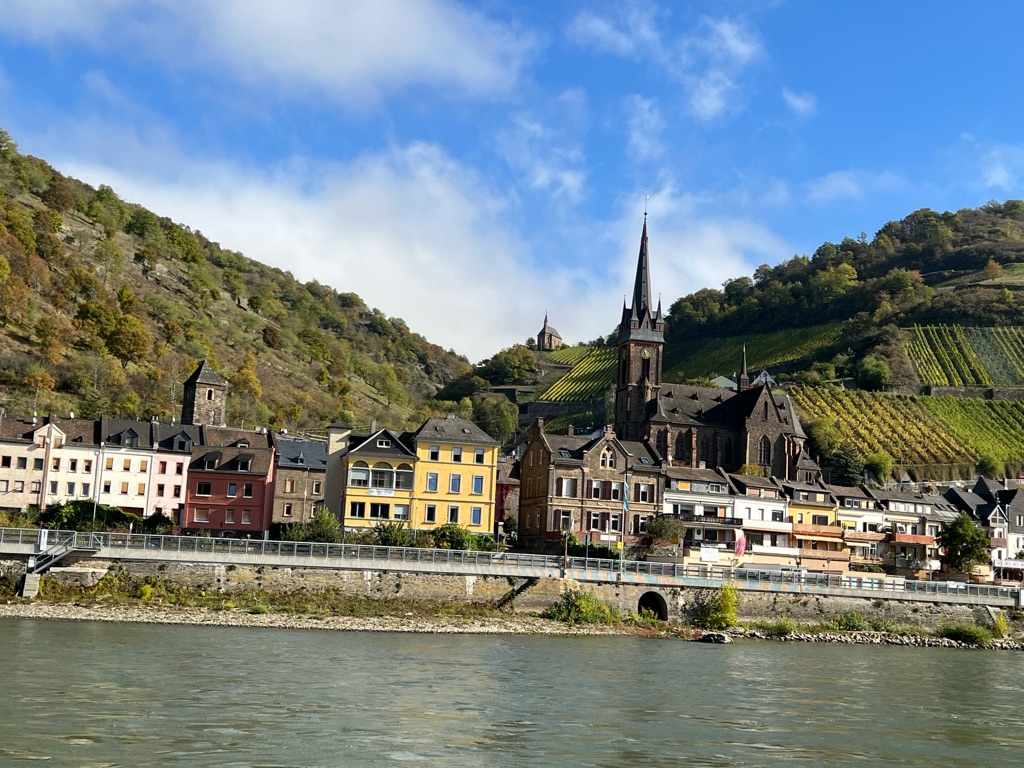
More harvesting! The grapes cover all of the steep hills along the gorge and make for a very picturesque trip up the gorge!

The Fürstenberg is a castle in the municipality of Oberdiebach in Rhineland-Palatinate, Germany. When the castle was built, in 1219, this part of the small (2000 acres) Oberdiebach was the village of Rheindiebach. Today, it is a ruin. But it’s for sale for several tens of millions of Euros if your looking for an investment!
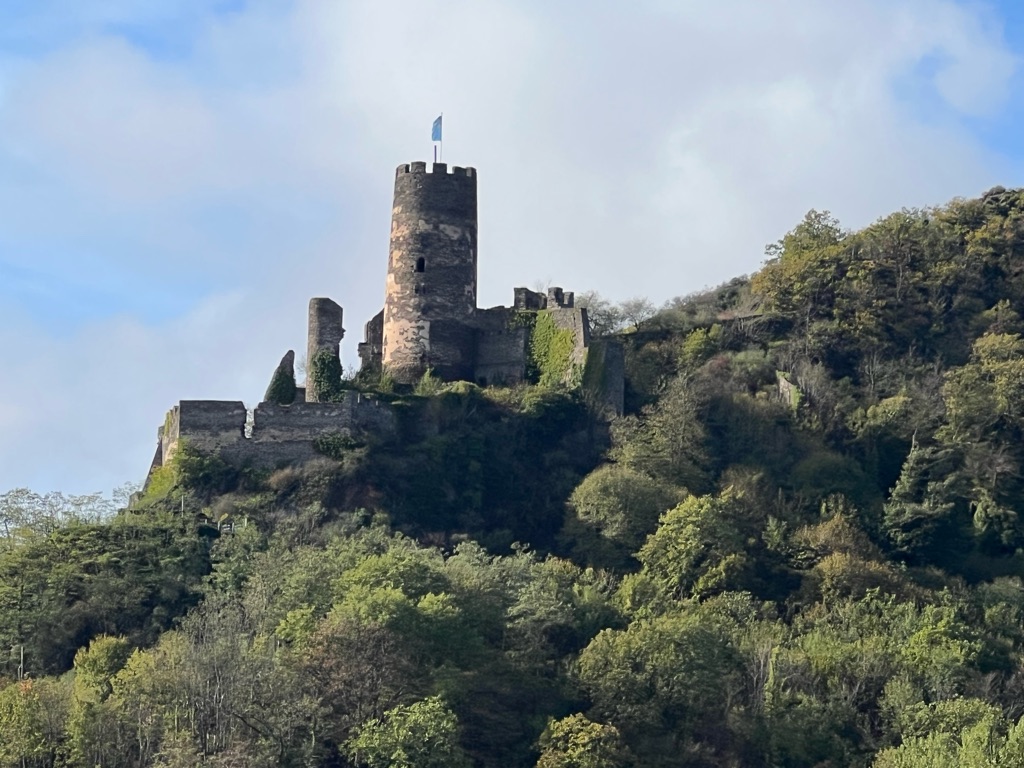
Sooneck Castle previously also known as Schloss Sonneck) is a castle built in the early 1200s in the upper middle valley of the Rhine, in the Mainz-Bingen district of Rhineland-Palatinate, Germany. It is located near the village of Niederheimbach between Bingen and Bacharach. As with many of the Rhine castles, it was owned by numerous people and fought over in many wars. It became derelict, was rebuilt, was destroyed again, and then renovated once more. Today it, along with many of the castles on the Rhine, are owned by the State Ministry of Castles.
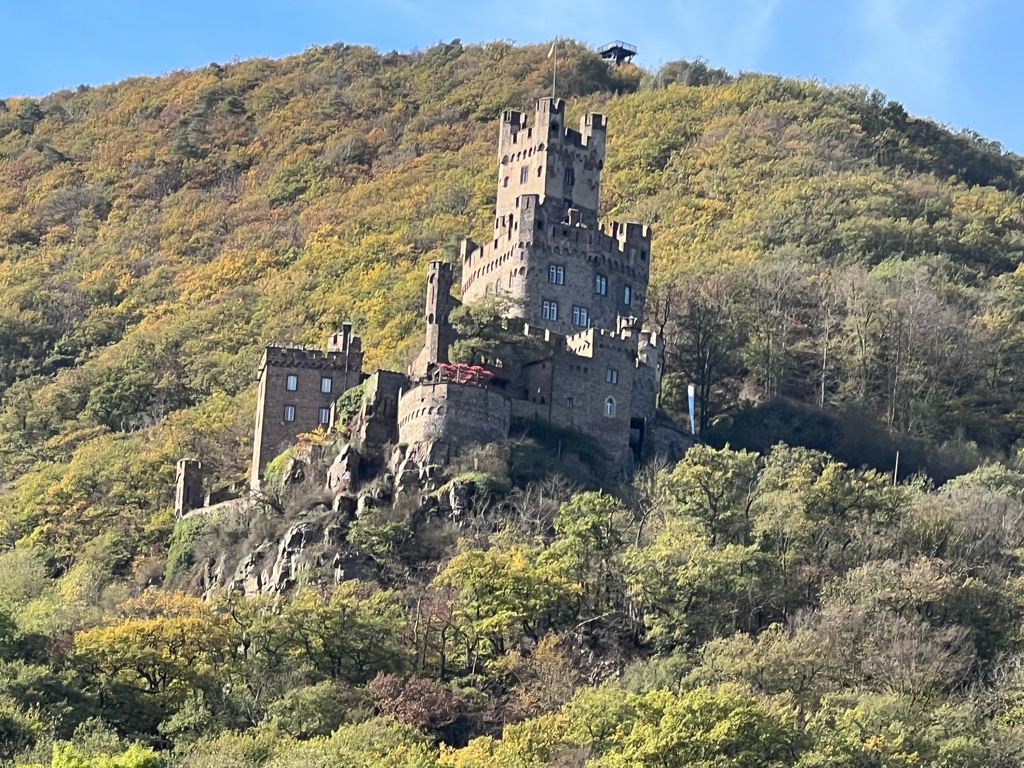
Reichenstein Castle also known as Falkenburg is a castle in the UNESCO World Heritage Site of the Upper Middle Rhine Valley. It stands on a mountain spur on the eastern slope of the Bingen Forest, above the Rhineland-Palatinate municipality of Trechtingshausen in the Mainz-Bingen district in Germany.

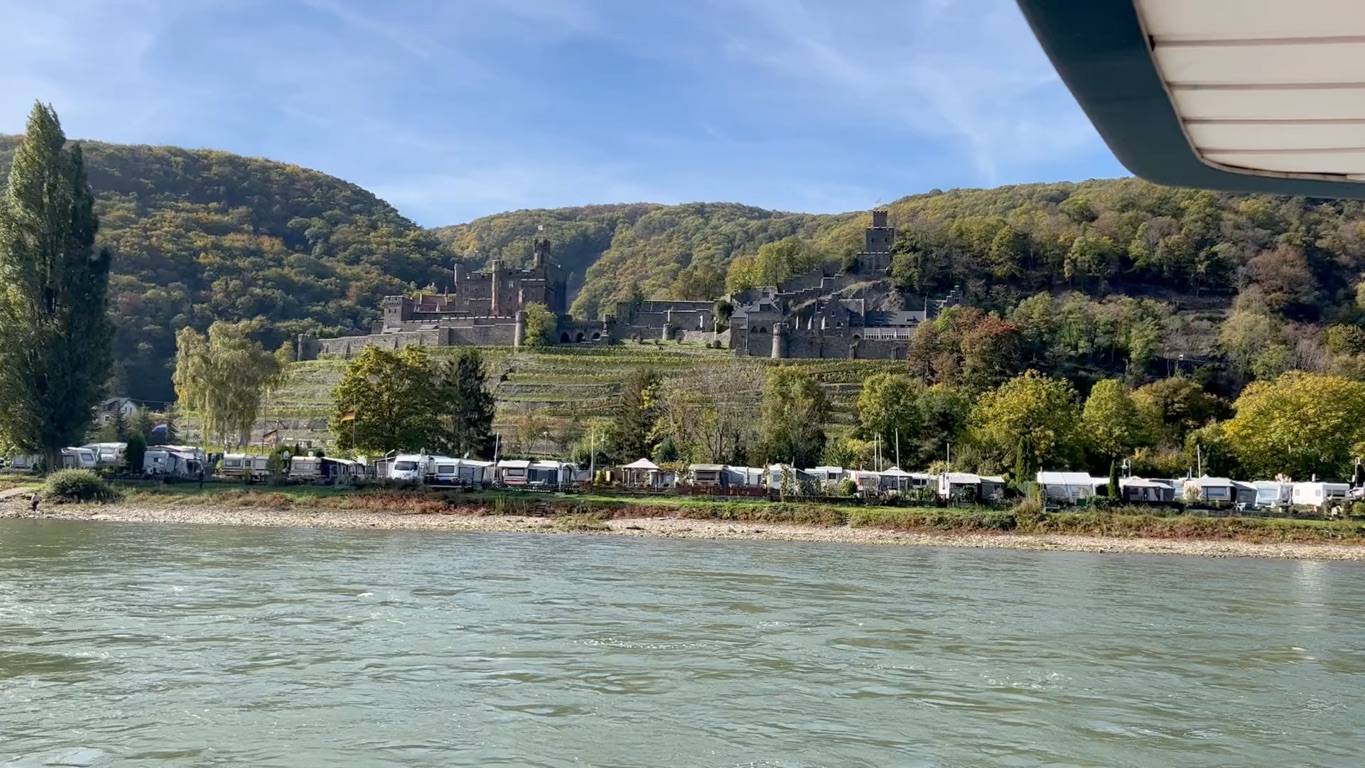
Walls protect the terraces that launch the vineyards down to the Rhine!
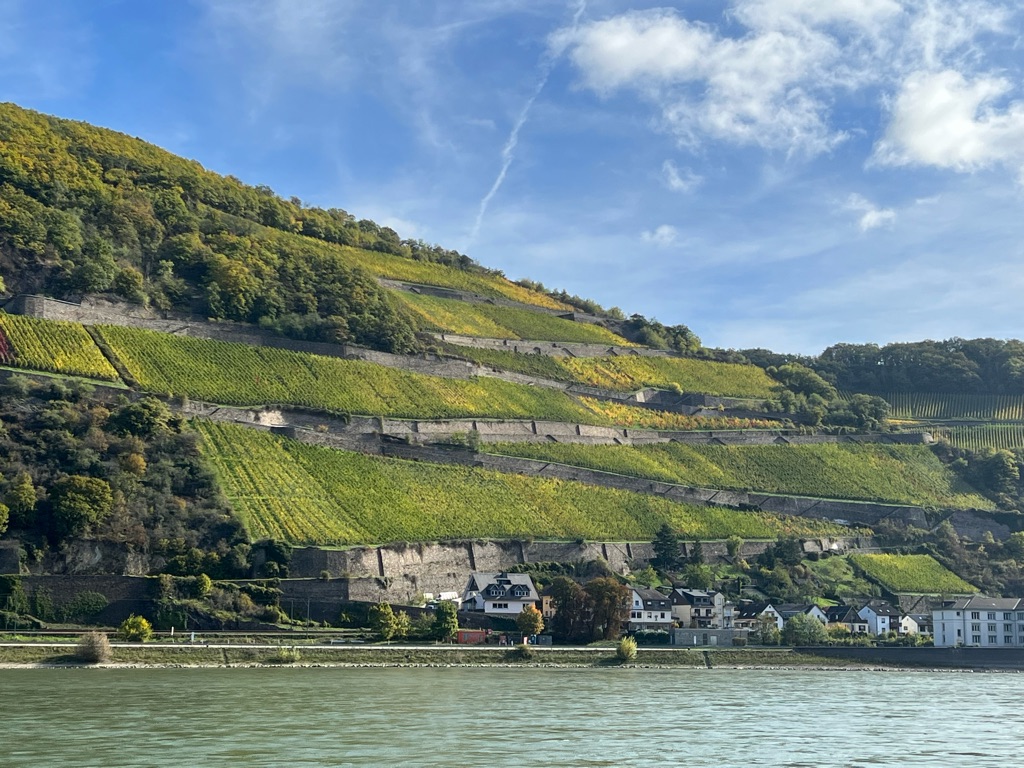
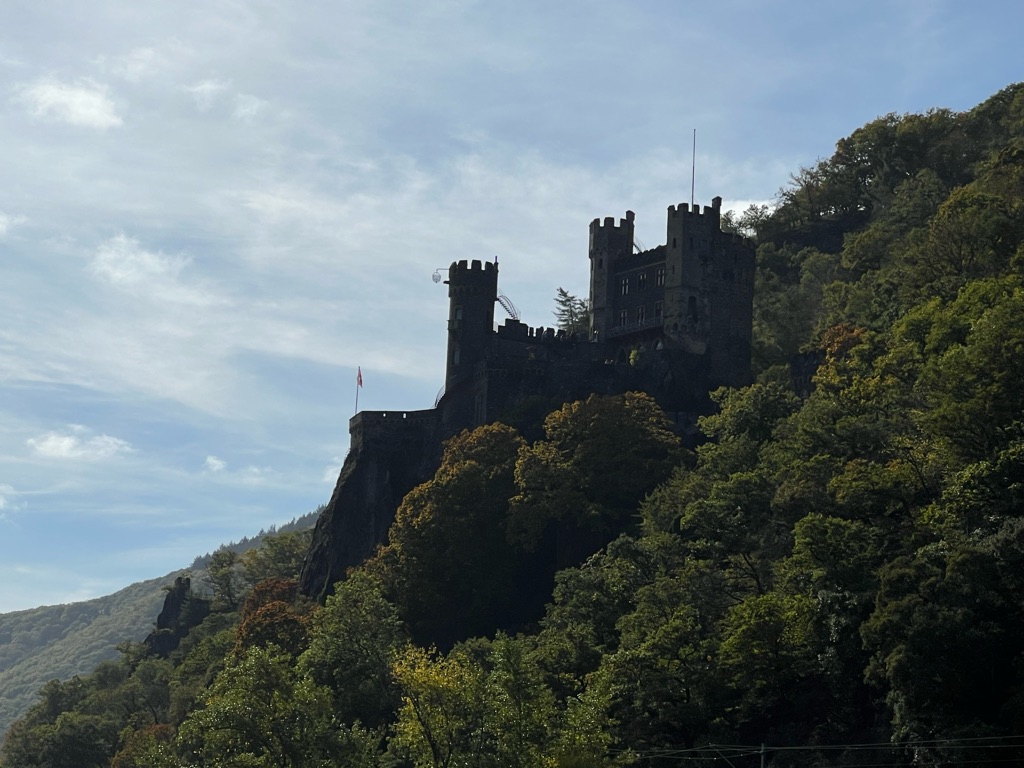
Rheinstein Castle, a little younger than the others we’ve seen, was constructed in about 1316/1317. It was important for its strategic location. But by 1344, the castle was in decline. By the time of the Palatine War of Succession, the castle was very dilapidated. During the romantic period in the 19th century, Prince Frederick of Prussia (1794–1863) bought the castle and it was rebuilt.

We were passed throughout the day by other river boats and barges headed downriver. But you had to be fast to catch them on film!

Rudesheim, Germany
We made it to Rudesheim in the early afternoon and made our way off the Avalon Panorama to explore the city!
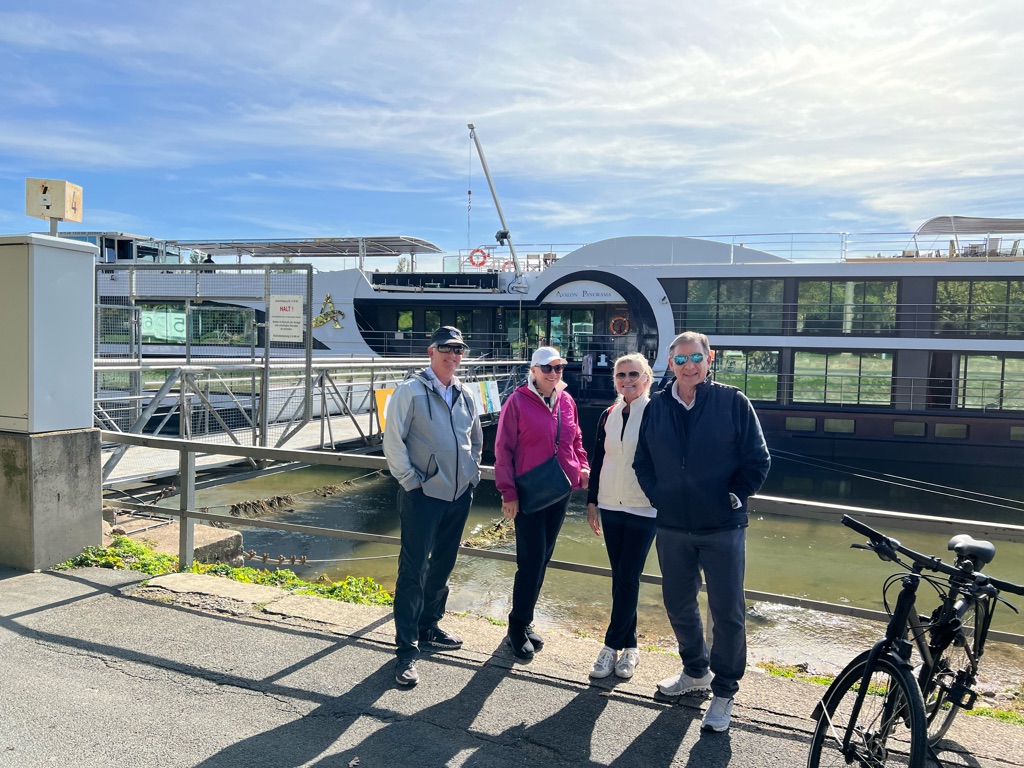
We started at the Siegfried Mechanical Musical Instrument Museum and it was a quite the symphonic experience!
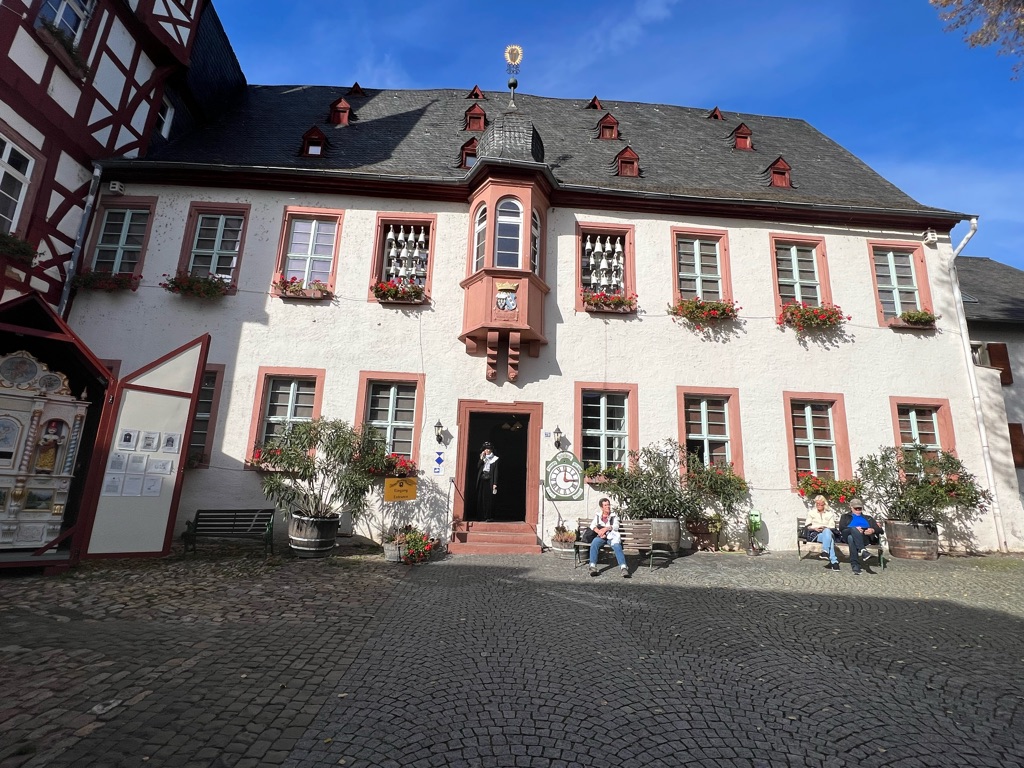

The building that houses the museum is one of the oldest in town and the murals on the walls are from the 1500s. The tiles on the floor of the next room, which has been a chapel, were from the 1200s. The player piano is a much younger addition, though.
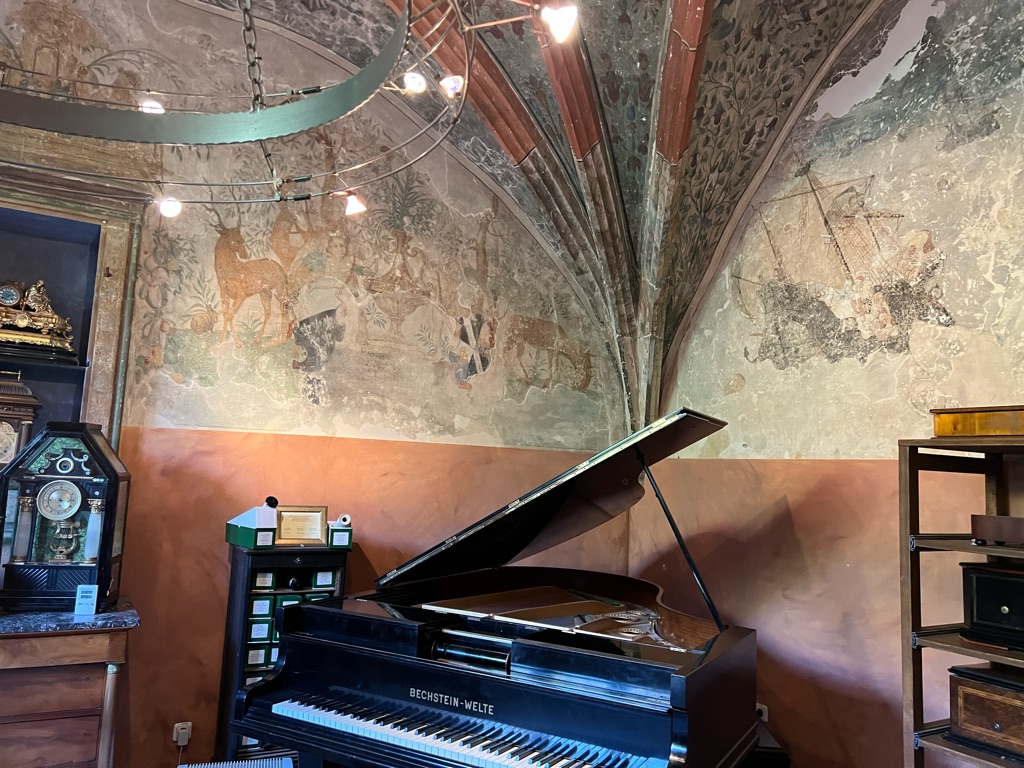
The musical bird box was invented in the 14th century. There are almost extinct, but they are still made at the Siegfried Musical Instrument Museum! They are a bit pricey though, selling for $1800 -$6000 each.
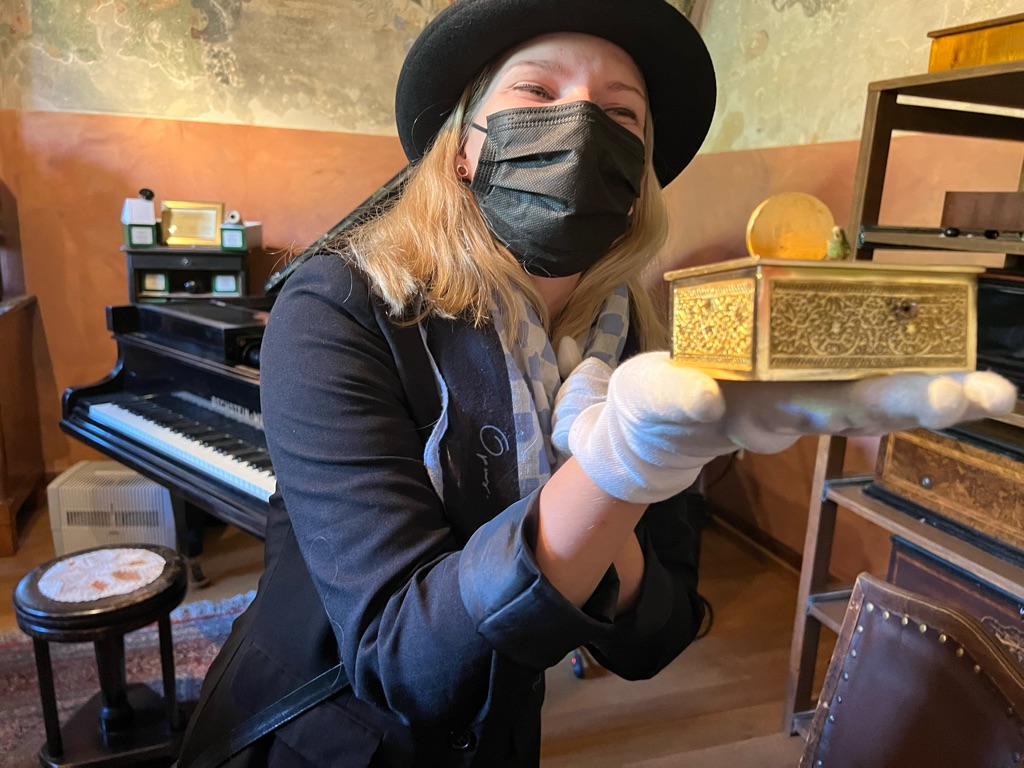
This violin and piano cabinet is one of only 6 left on existence. Five of them are in the museum. This one has 6 violins, each one with a single string. Queen that note is needed, the violin is pushed forward into the rotating bow. Most of the machines in the museum are played using paper that is punched with holes that drives the different mechanical instruments.
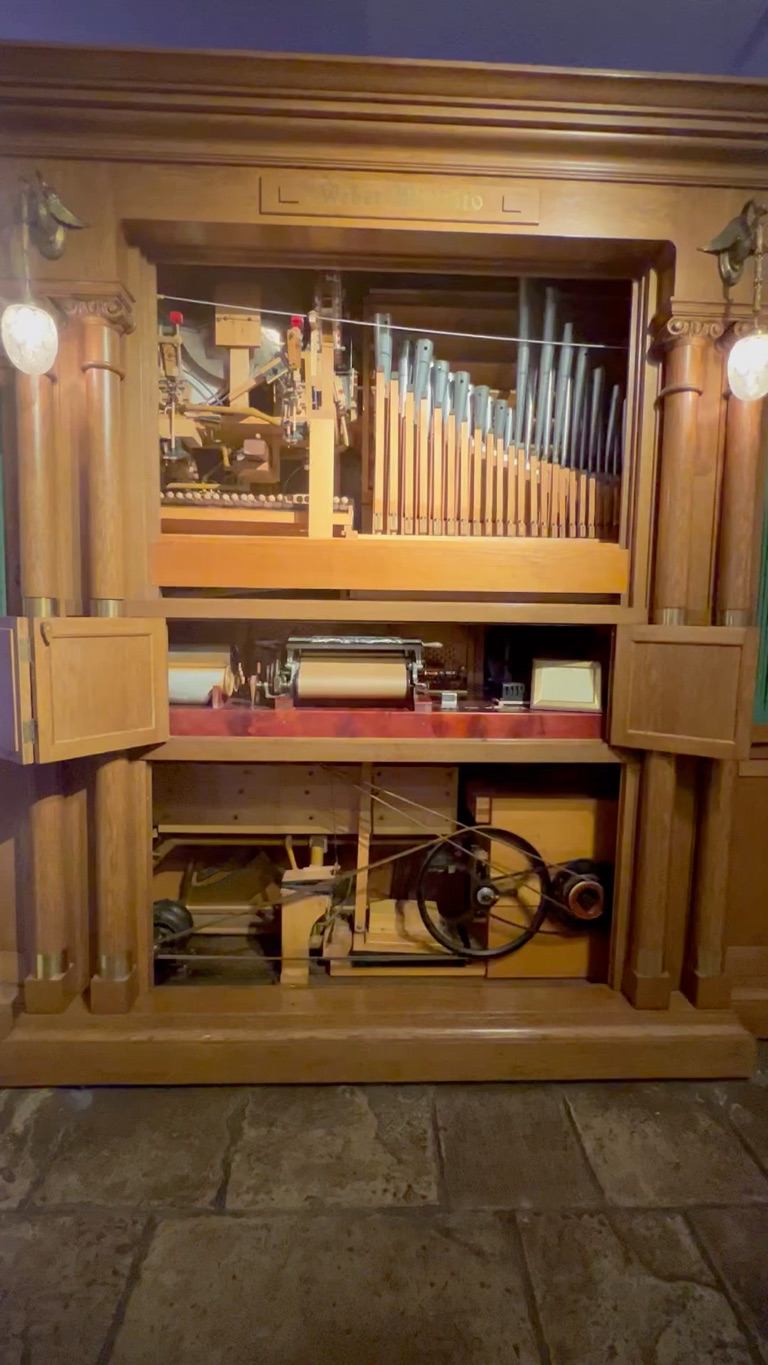
This calliope was found in disrepair in a barn in Romania. It had originally been used on a Merry-Go-Round. It plays be feeding a paper ‘book’ through the reader that tells the mechanical instruments easy and when to play!

It took hundreds of pages to play one song. Each book plays only 23 seconds of music!

Joe’s alter ego as an organ grinder!! But seriously, the founders of the museum, started their collection by purchasing a broken organ grinder and fixing it and then using the proceeds to purchase another broken organ grinder. The rest… as they say… is history.
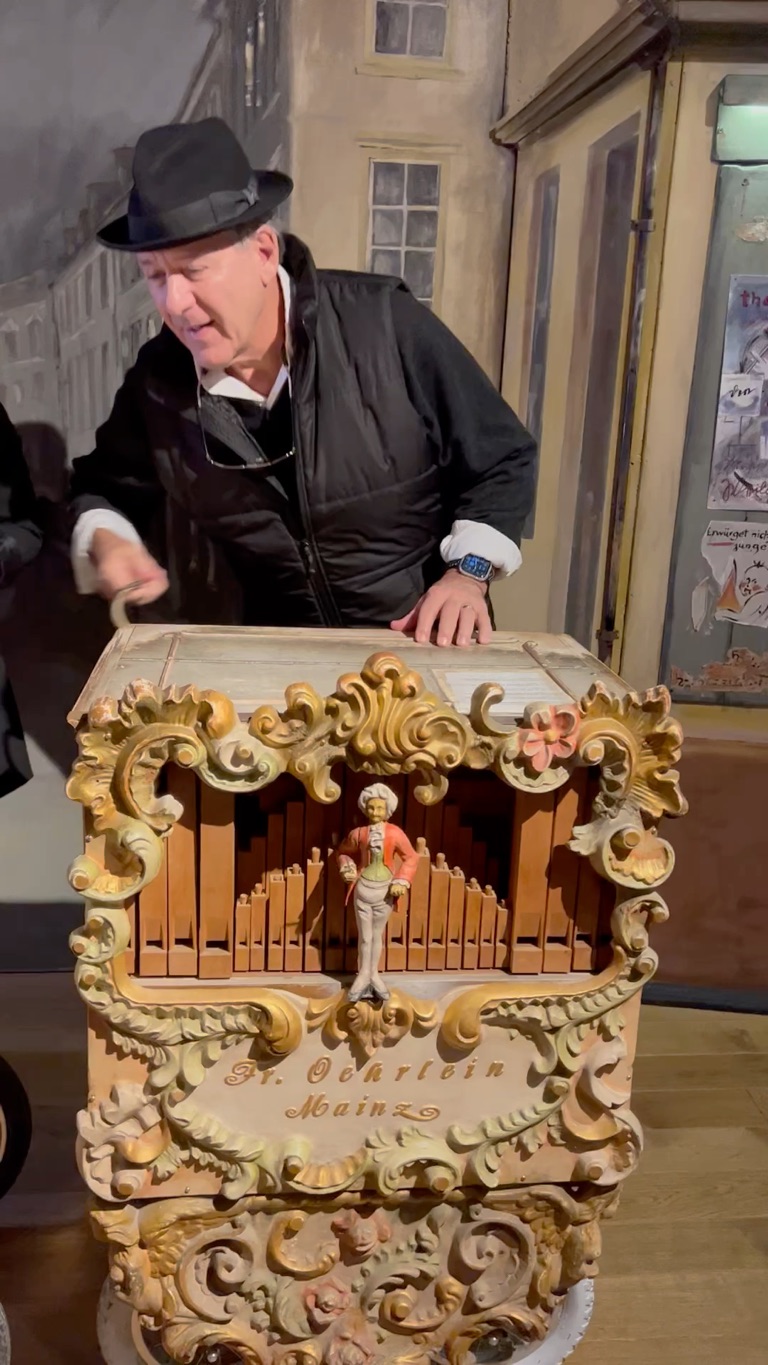
Harriet is queen of the castle today!
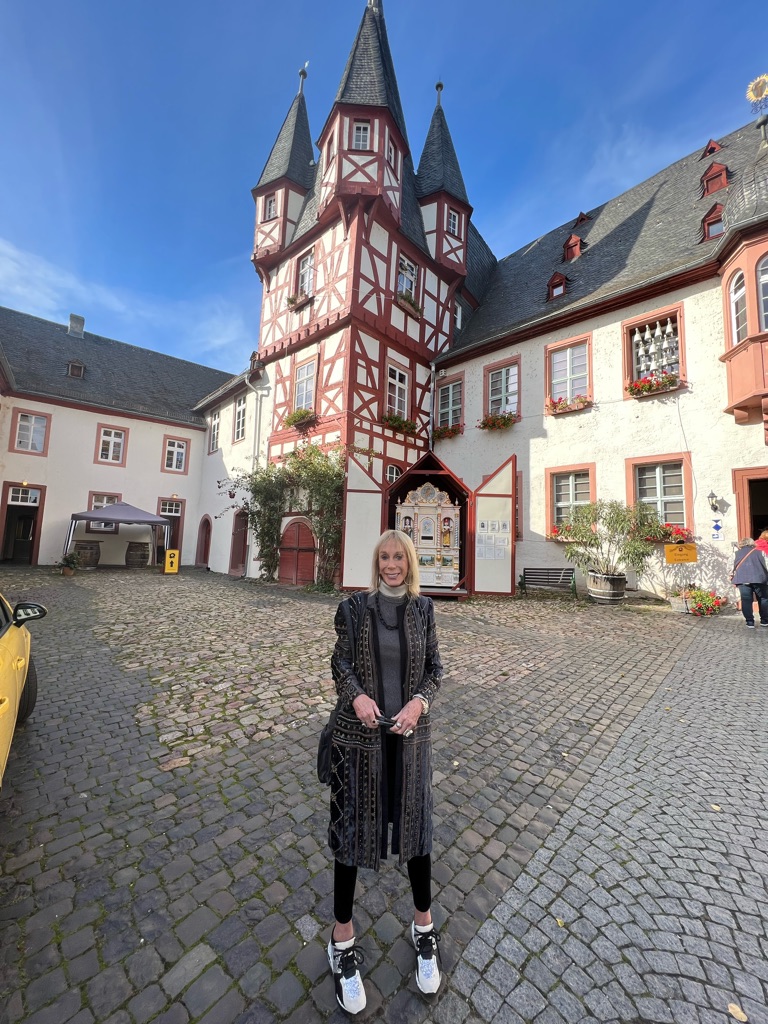
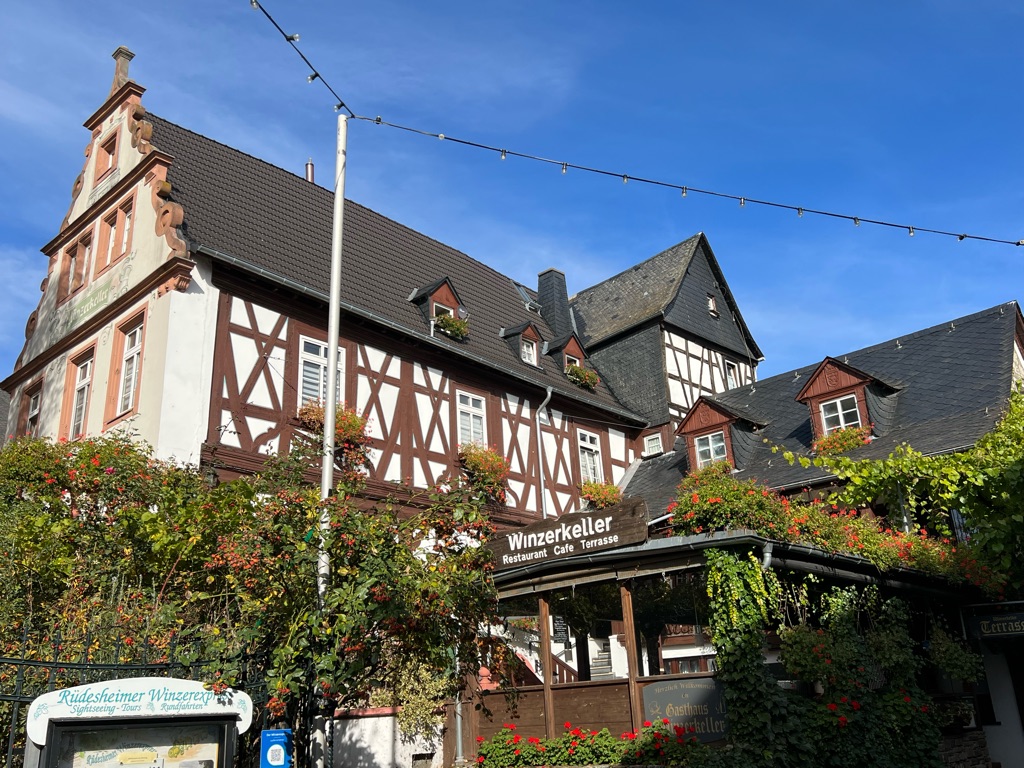
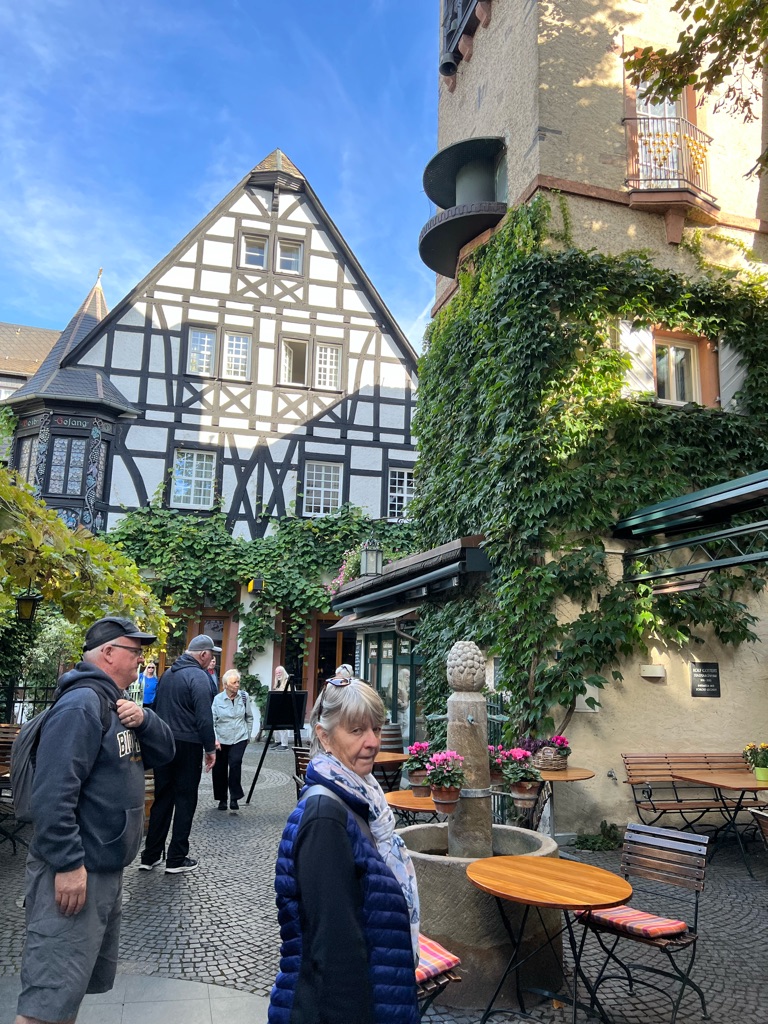
Rudesheim coffee is a local speciality. They start with a cube of sugar and cover it with flaming brandy. Then they put out the flames with coffee, followed by whip cream covered with chocolate powder.

And we all had some!
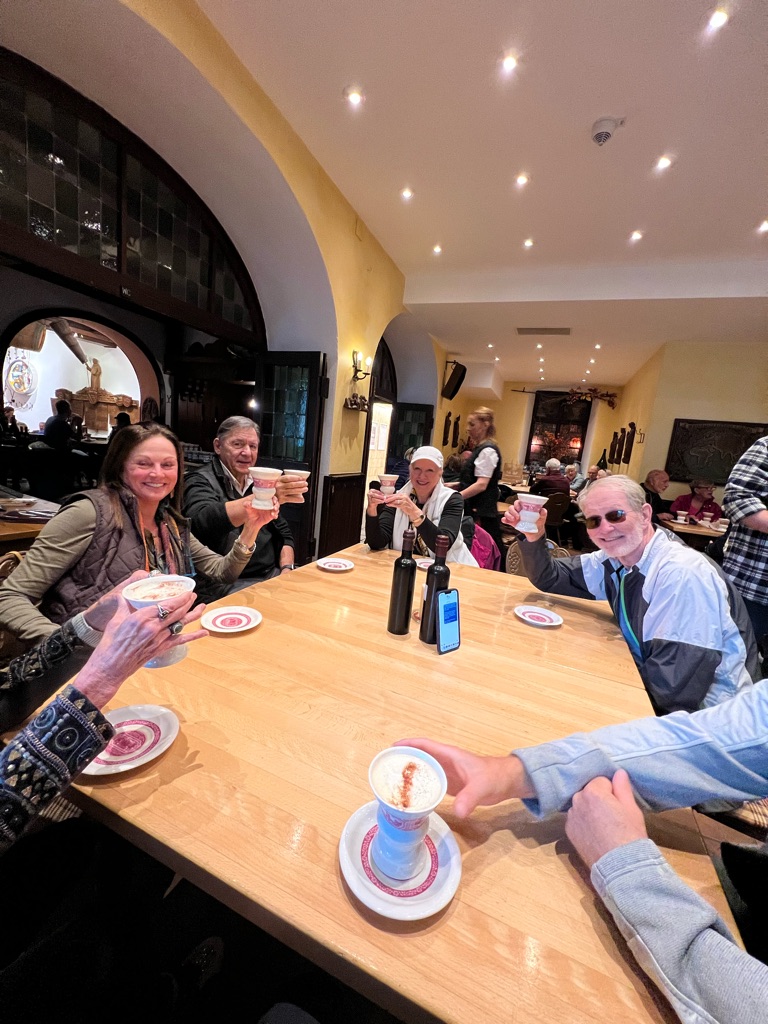
We made new friends on the riverboat, Chris and Julie! They are from the UK and for right in with our group!
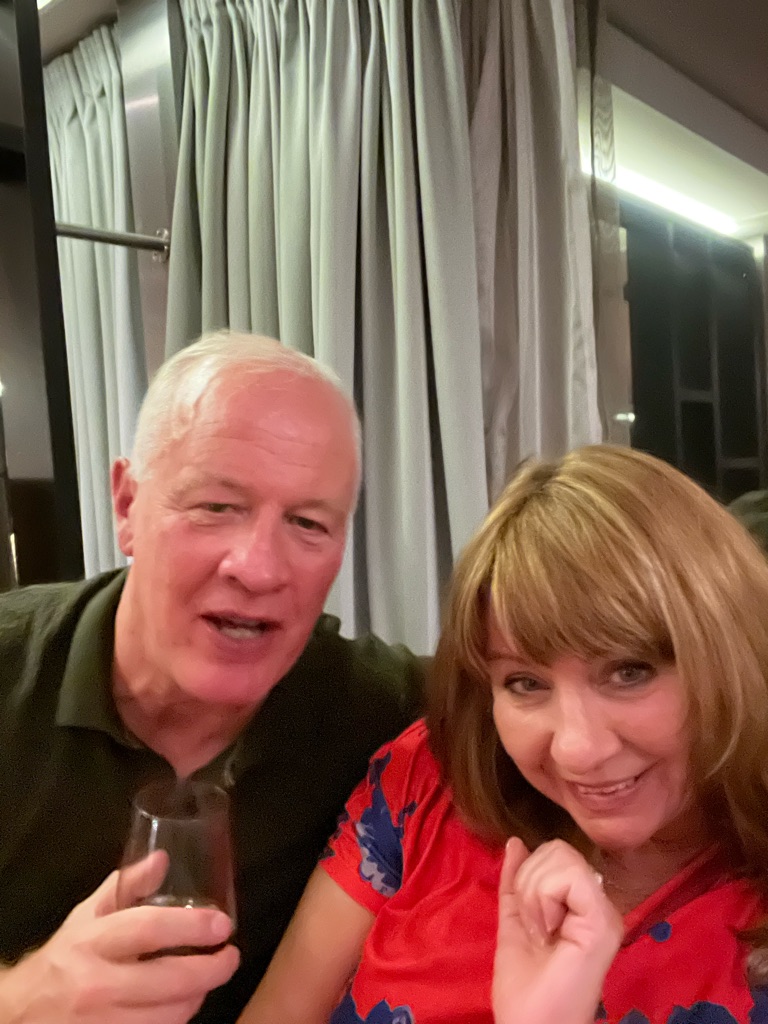
And we listened to a wonderful classical group!
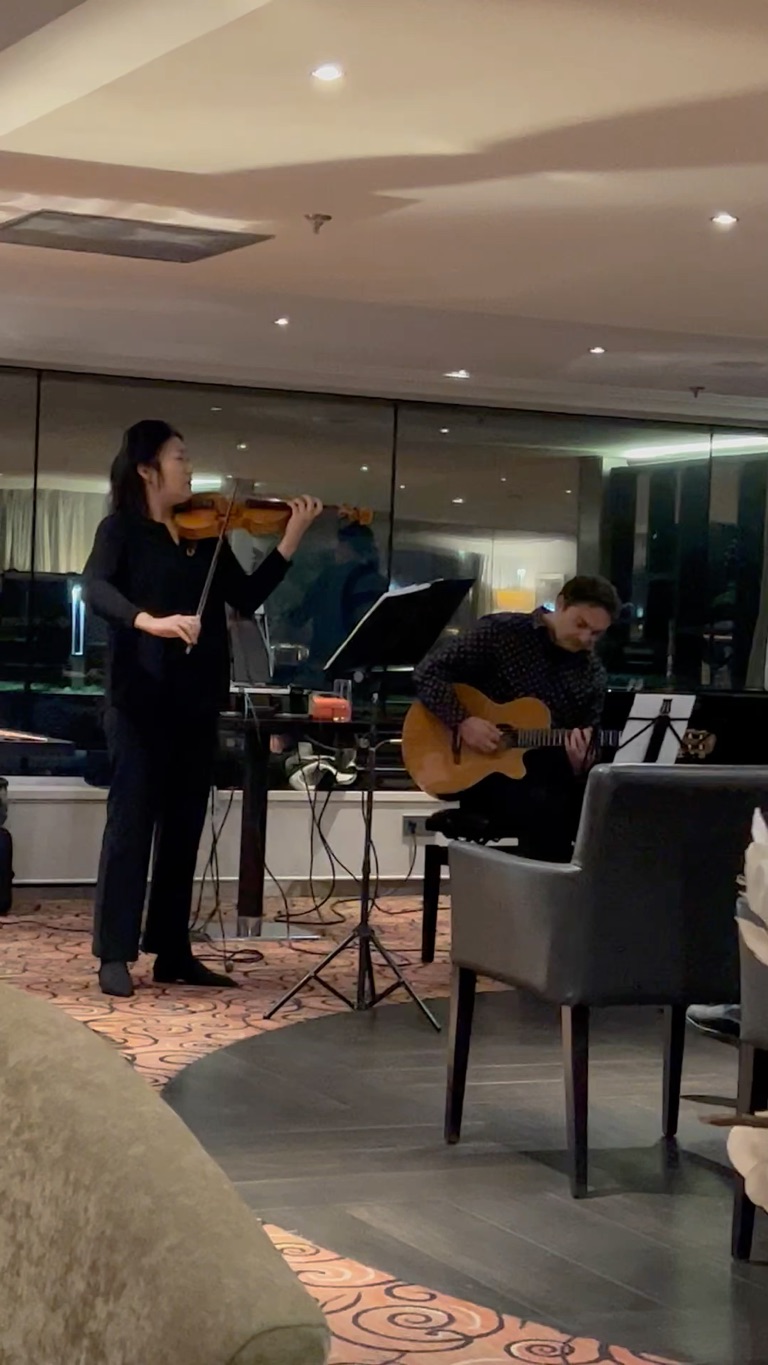
Gutenberg Museum
We walked a short distance from the ship to the into the main market of Mainz. Along the way we passed a monument commemorating the separation of Germany after WWII.
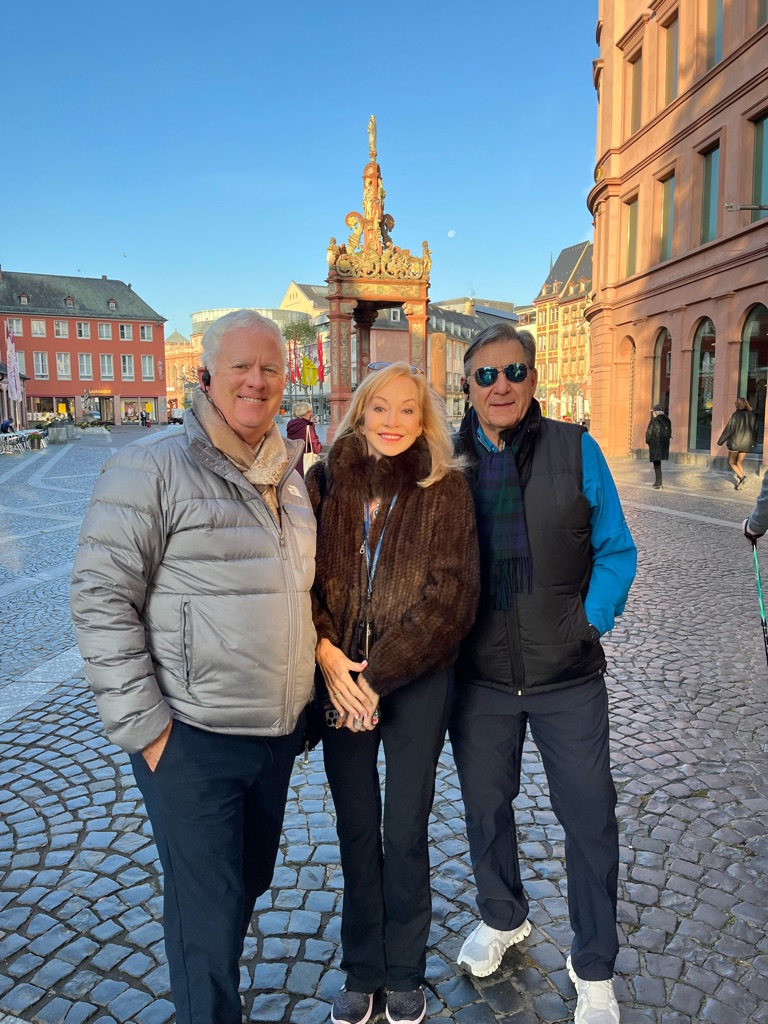
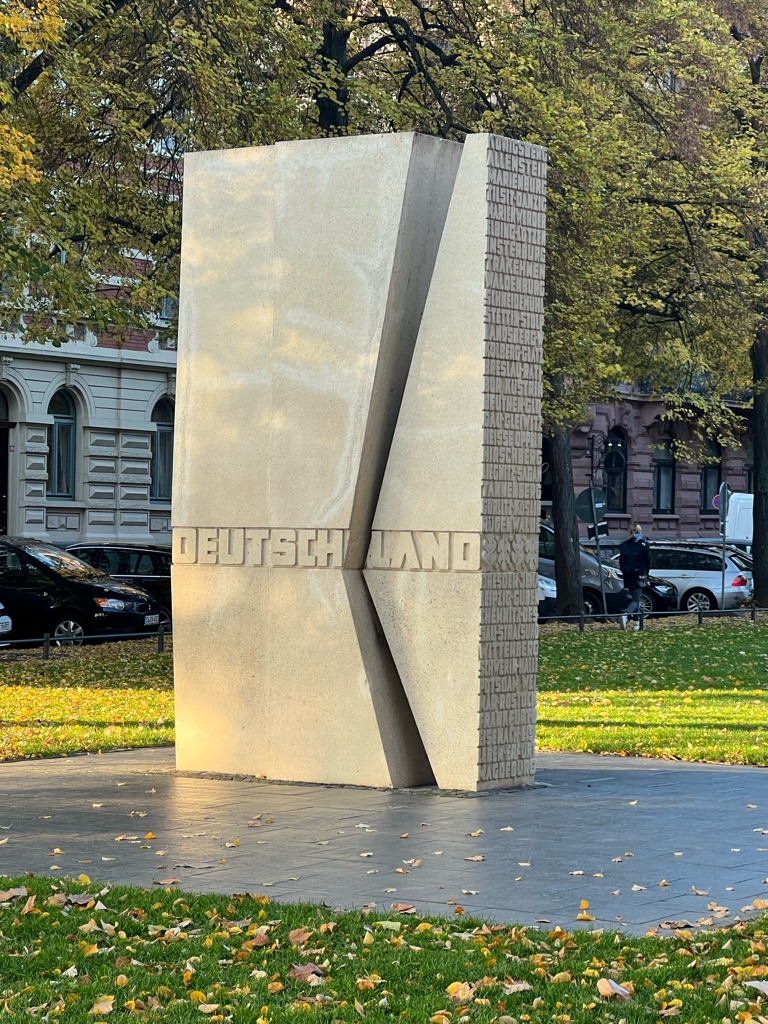
Next we toured the famous cathedral. The cathedral was consecrated in 1036, and although heavily damaged during WWII, it has been restored to its former glory … except for the stained glass windows.
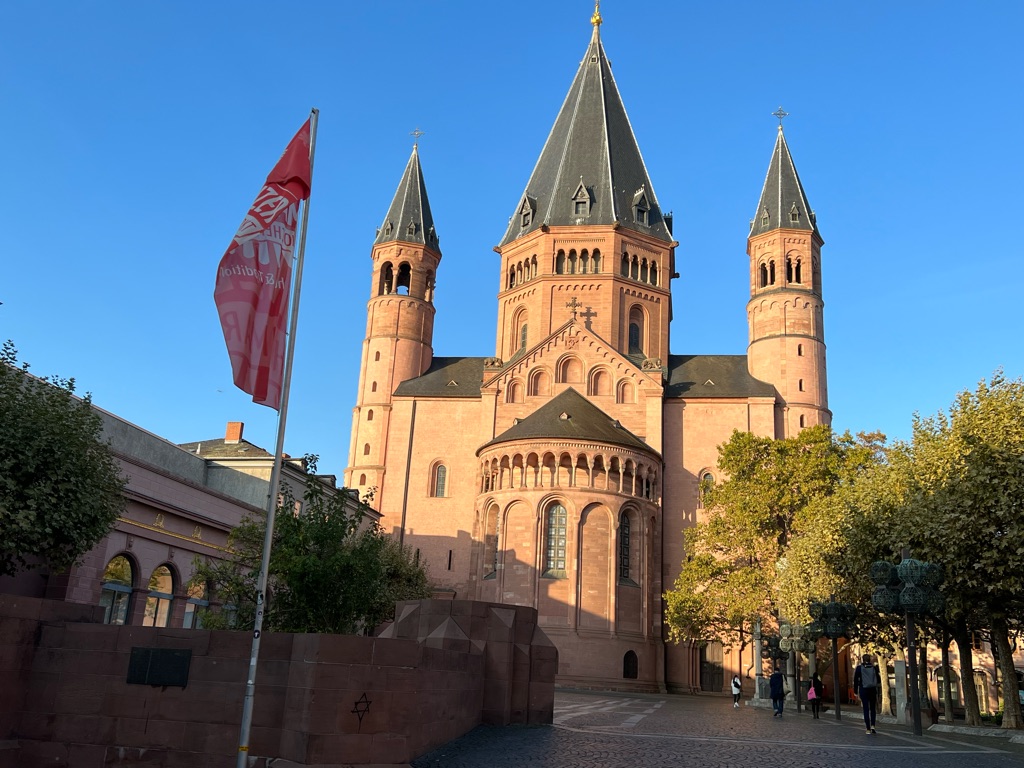
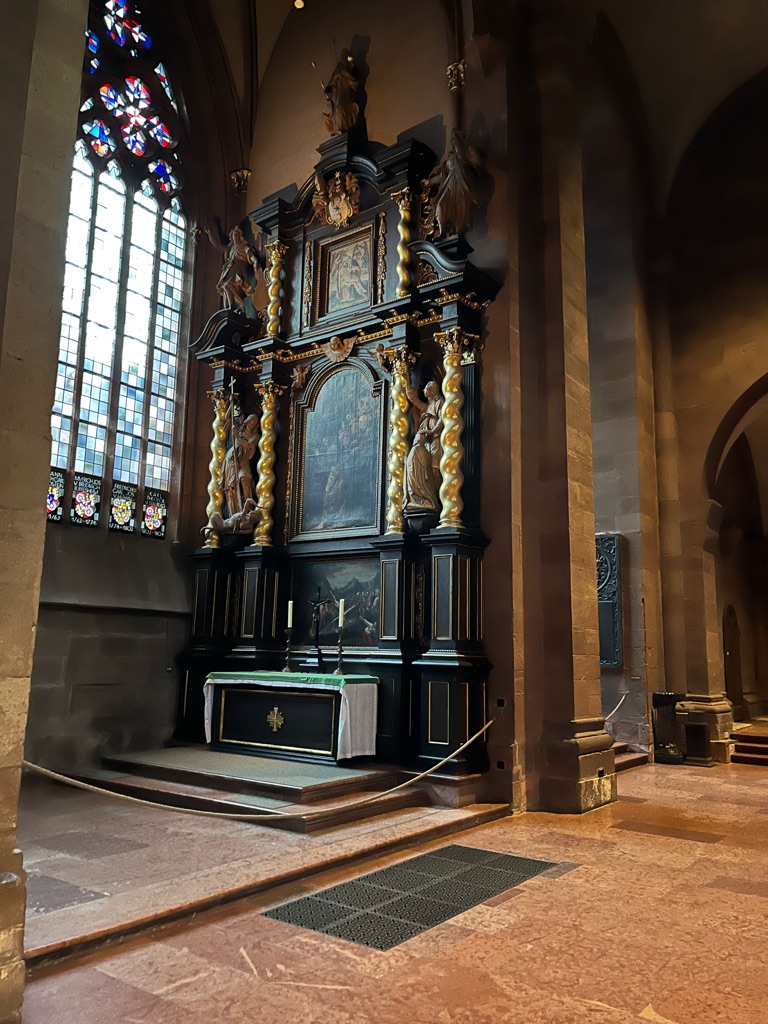
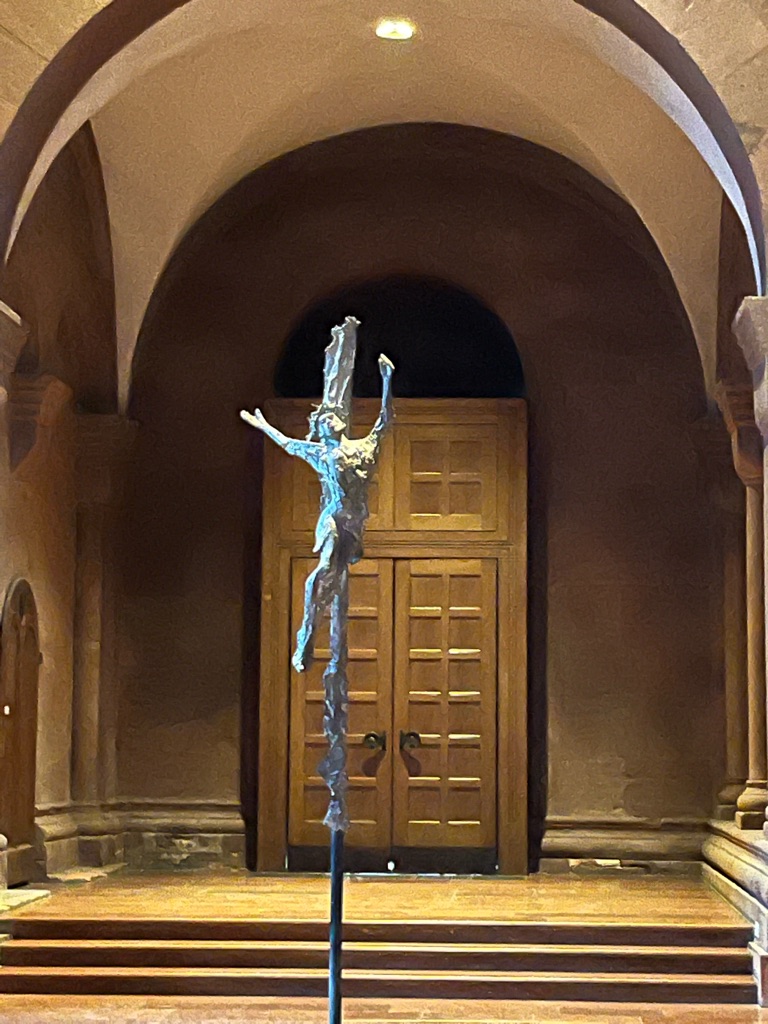
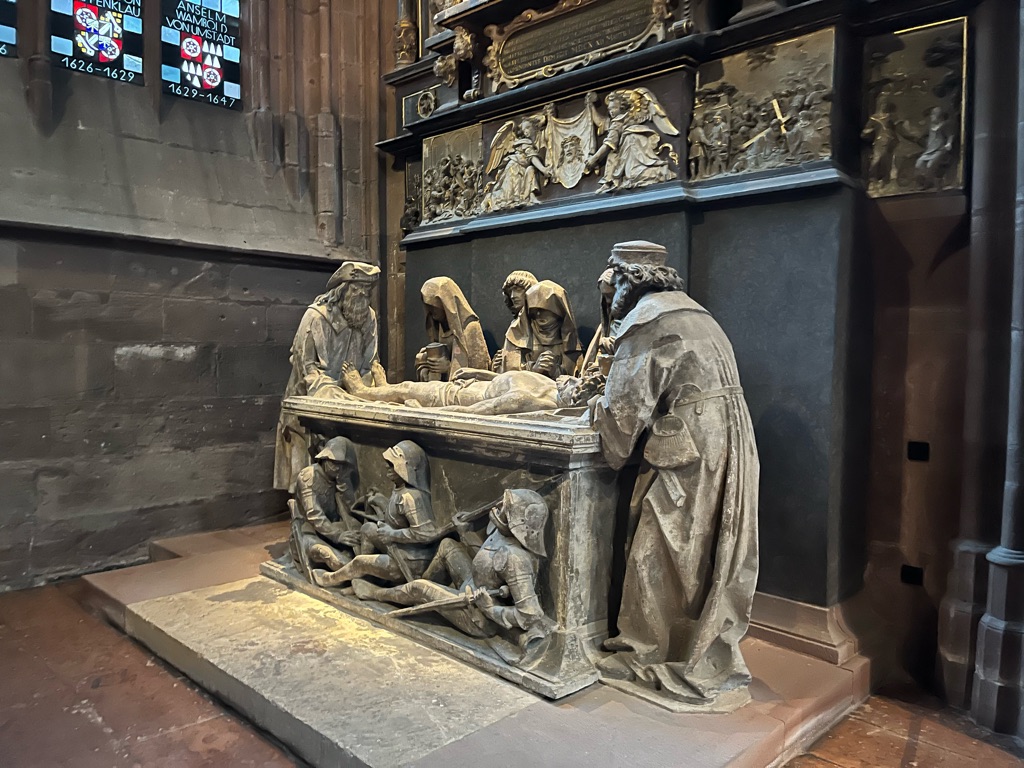
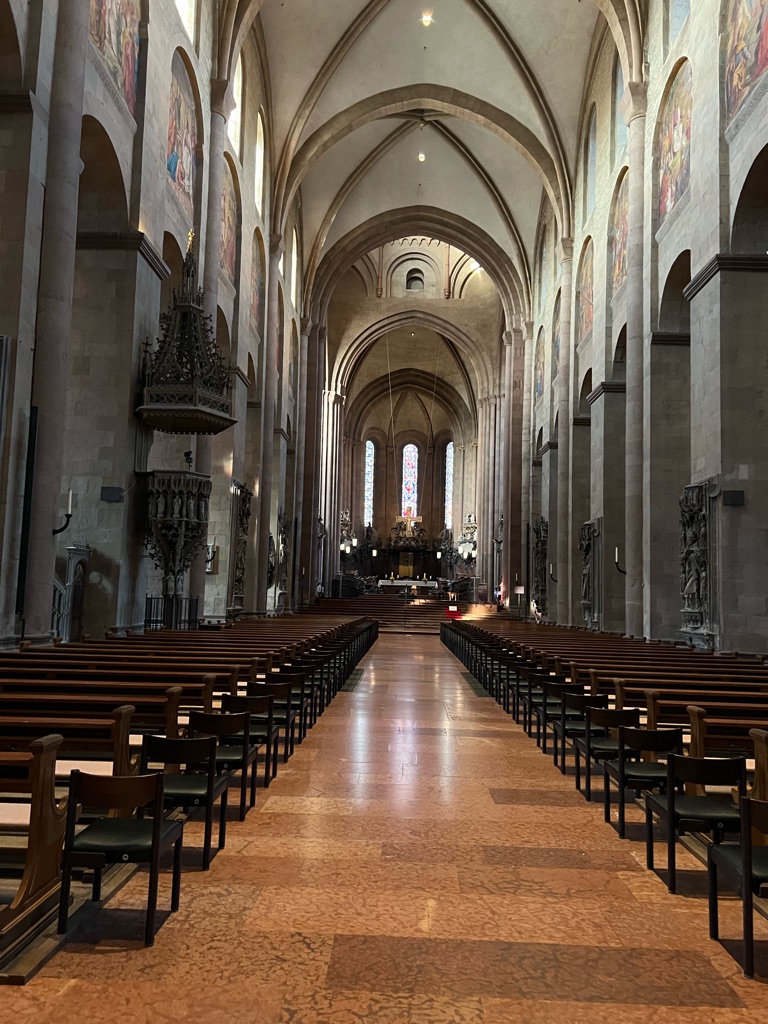
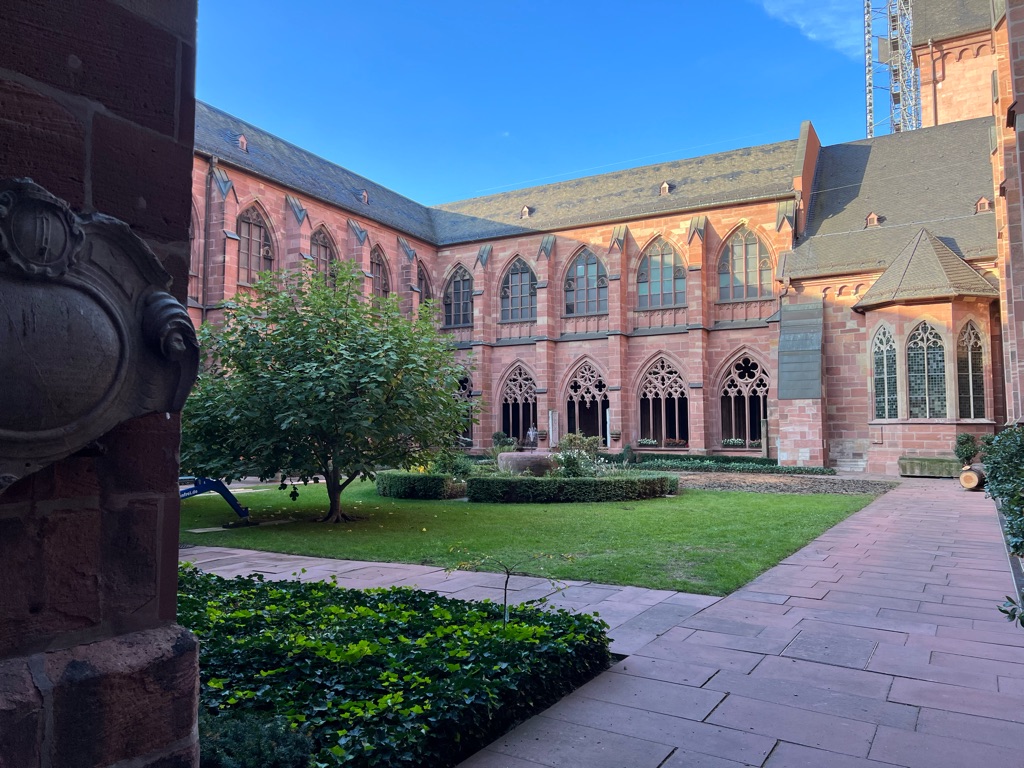


Our final stop was the Gutenberg Museum located across from the cathedral. It is one of the places where Gutenberg printed his 180 copies of the Bible. It revolutionized religion and learning to make bubbles more available to the masses since Proper to that time it tools monks nearly a year to copy a Bible by hand.

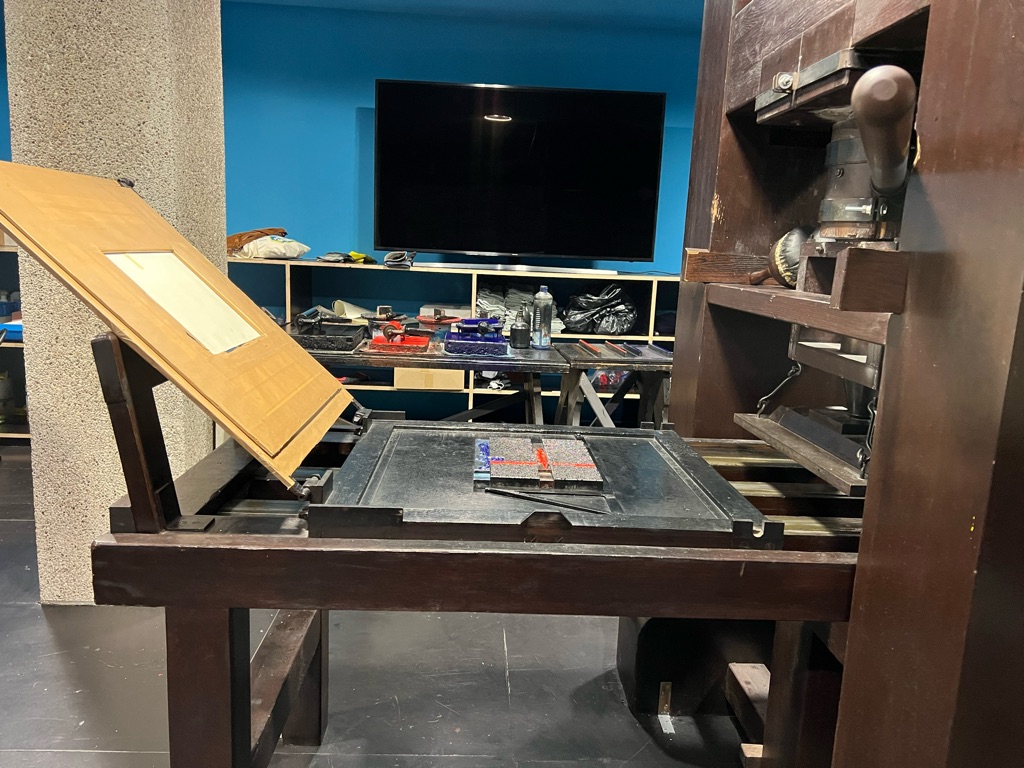

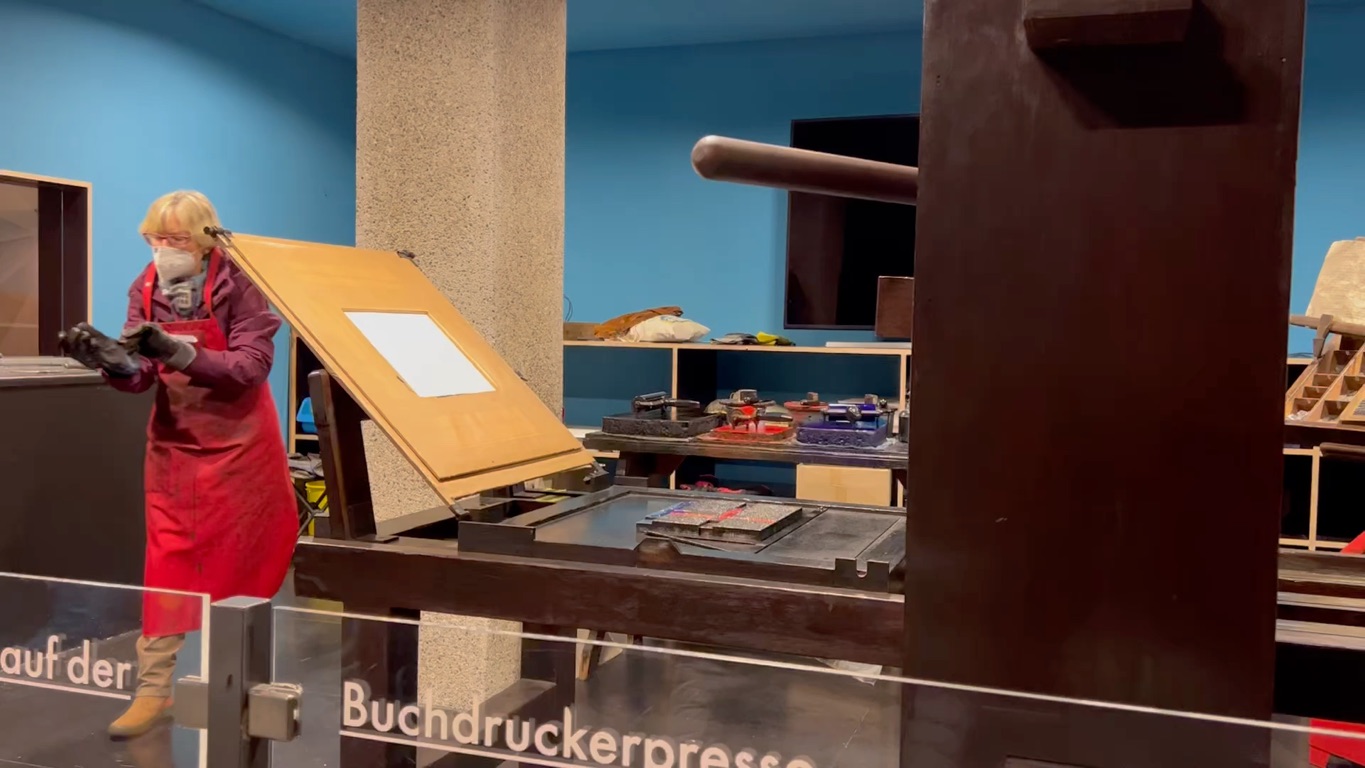
We headed into the old city of Strasbourg. Our guide, in the plaid coat, handed Tom the flag and he was instantly transformed into the group leader!
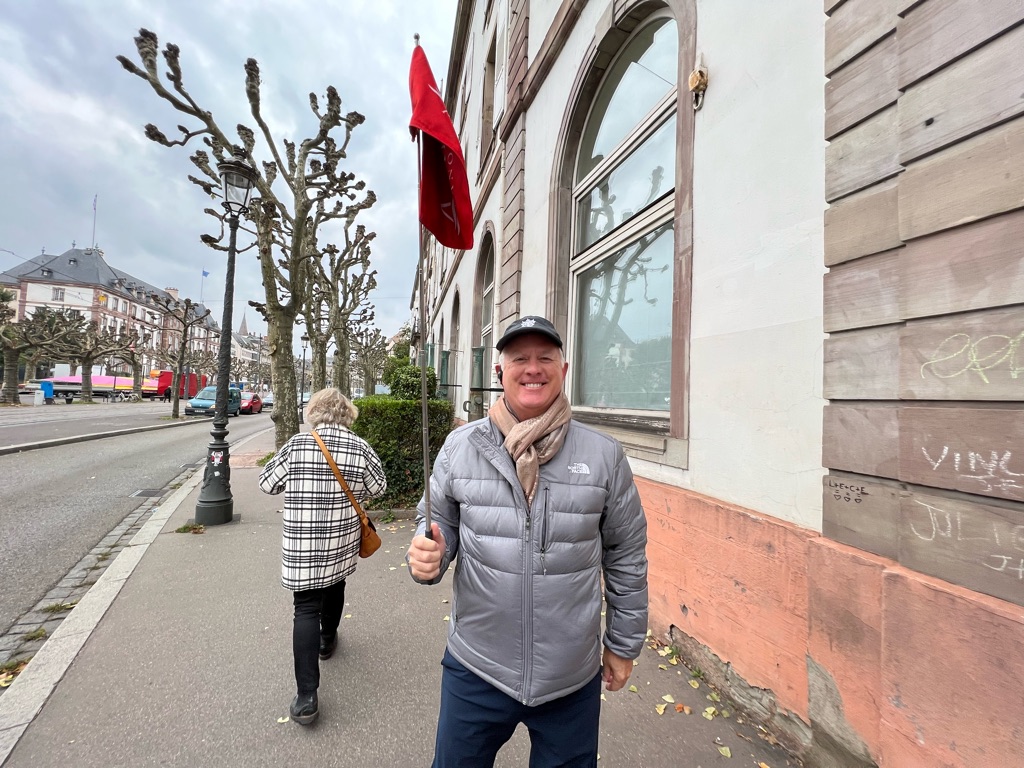
We passed delightful shops selling pastries …

…. And meats …
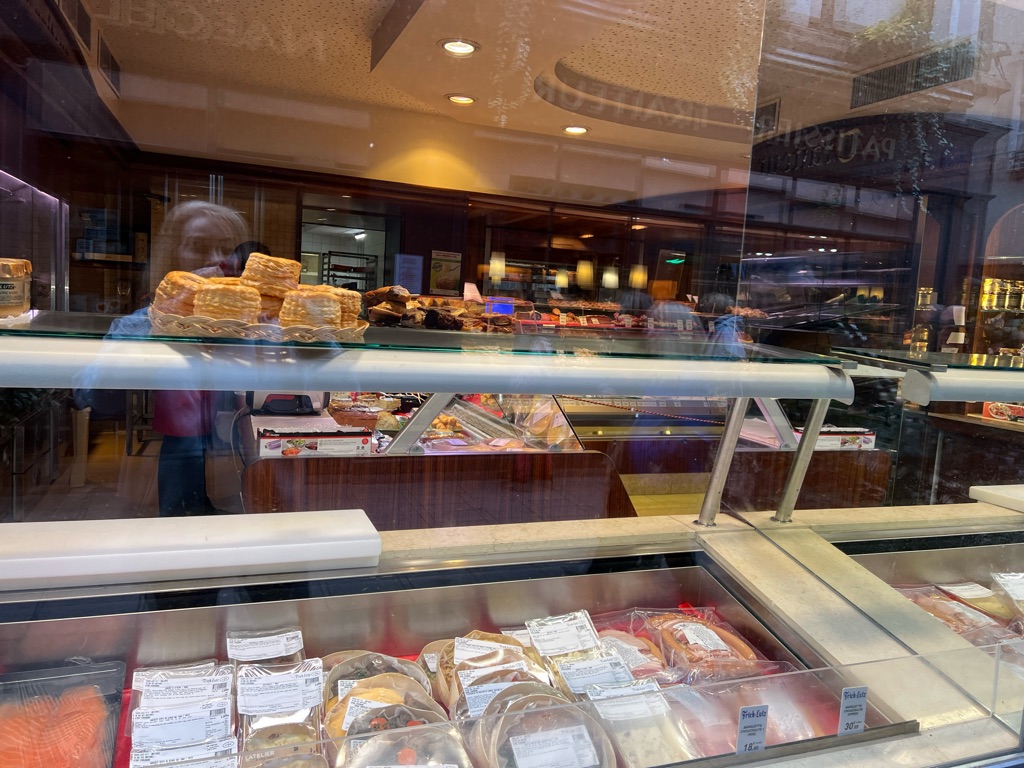
And everything you could want!

We made our way to the Cathedral Notre Dame of Strasbourg! Although considerable parts of it are still in Romanesque architecture, it is widely considered to be among the finest examples of Rayonnant Gothic architecture. Architect Erwin von Steinbach is credited for major contributions from 1277 to his death in 1318, and beyond through his son Johannes von Steinbach, and his grandson Gerlach von Steinbach, who succeeded him as chief architects. The Steinbachs's plans for the completion of the cathedral were not followed through by the chief architects who took over after them, and instead of the originally planned two spires, a single, octagonal tower with an elongated, octagonal crowning was built on the northern side of the west facade by master Ulrich von Ensingen and his successor, Johannes Hültz. The construction of the cathedral, which had started in the year 1015 and had been relaunched in 1190, was finished in 1439.
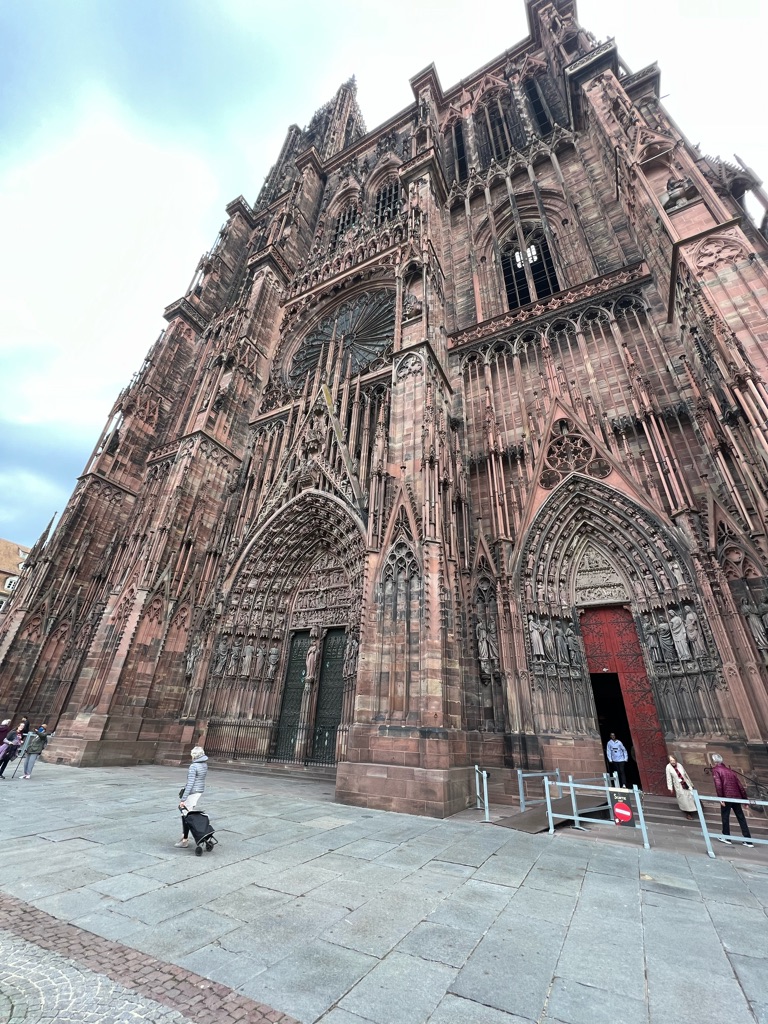
But perhaps the most interesting feature of the Cathedral is the astronomical clock that it houses. It is the third clock on that spot and dates from the time of the first French possession of the city (1681–1870). The first clock had been built in the 14th century, the second in the 16th century, when Strasbourg was a Free imperial city of the Holy Roman Empire.
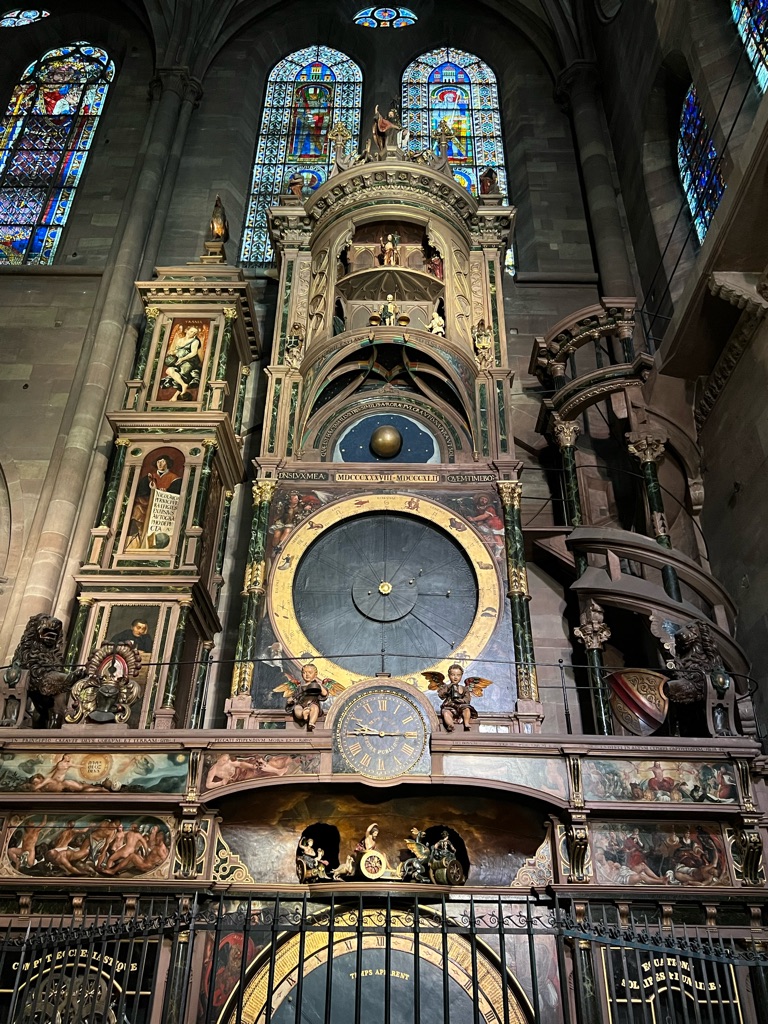
The current, third clock dates from 1843. Its main features, besides the automata, \240The main attraction is the procession of the 18 inch high figures of Christ and the Apostles at the top \240 which occurs every day at solar noon, while the life-size cock crows thrice.

There is an Orrery (planetary dial), a display of the real position of the Sun and the Moon, and solar and lunar eclipse.

And the days of the week, displaying the Roman mythical figures respnsiblr for their names (in French) circled slowly such that the figure (in the case Jupiter for Juedi [Thursday in French] was display.

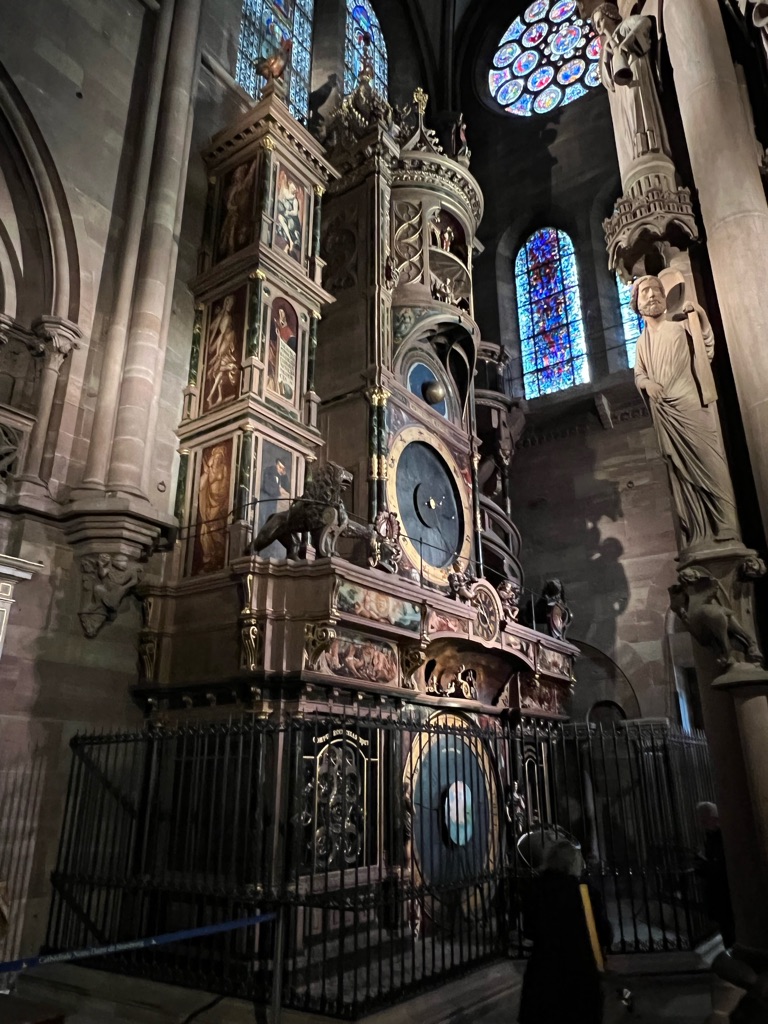
At 142 metres (466 feet), Strasbourg Cathedral was the world's tallest building from 1647 to 1874 and remains the 6th largest church today.

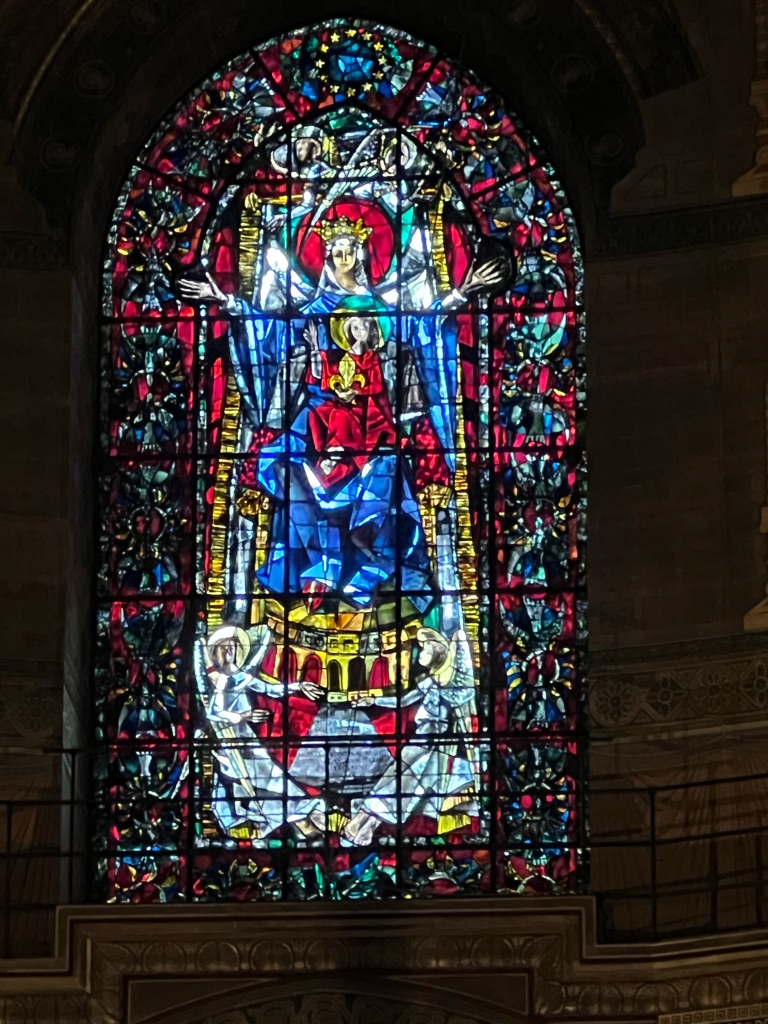
At the start of WWII, the beautiful stained glass windows were removed from the cathedral and stored far away. But towards the end of WWII, the Germans found them and they were taken to be started in the salt mines along with many other precious works of art.
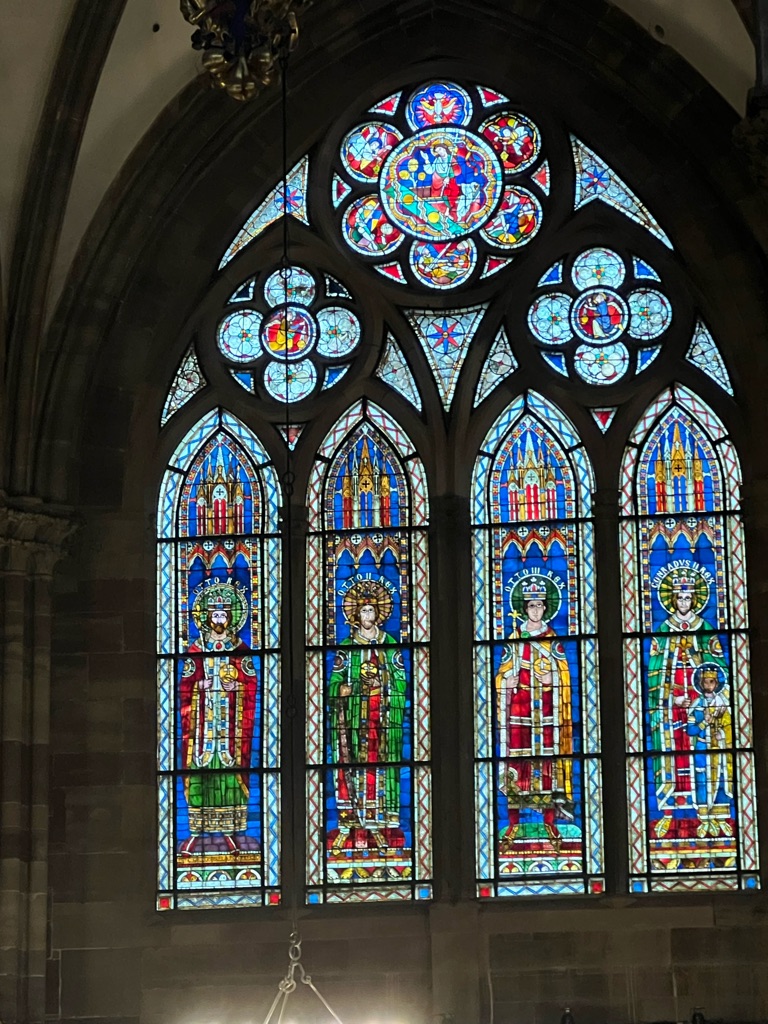
They were later found and returned! The rose window in the narthex is large enough to drive a tour bus through it!
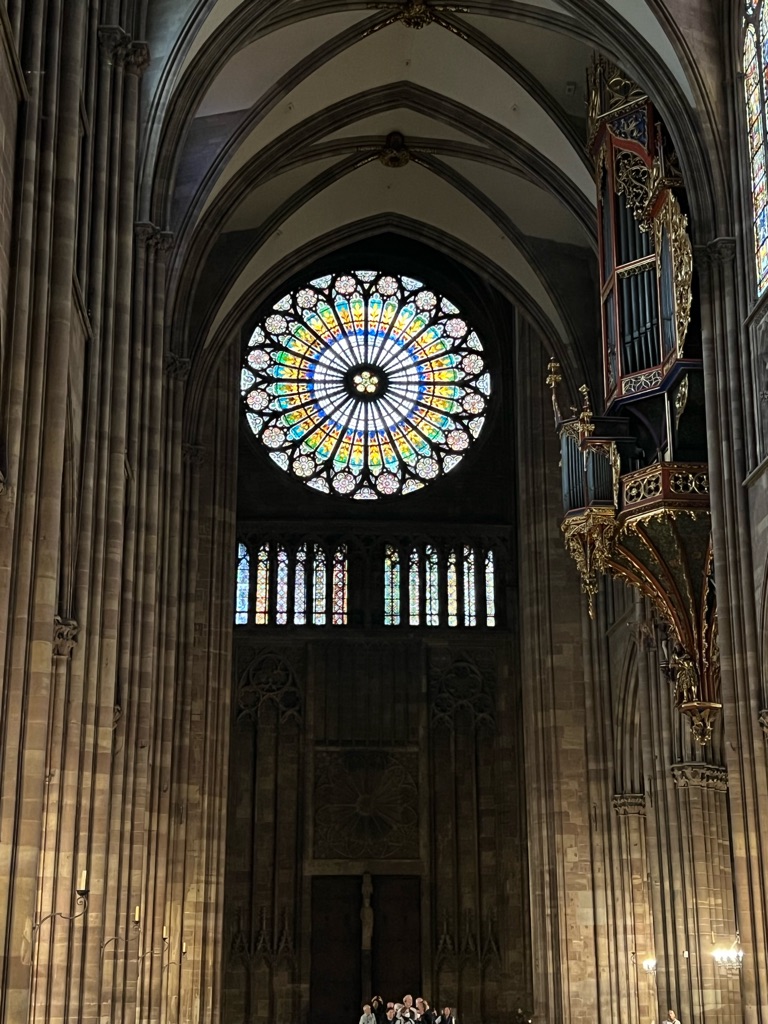
Just down from the Cathedral square on our way \240to the \240La Petite France area, we happened upon this double-decker merry-go- round! Built in the late 1800s it was designed for adult entertainment! Children were not welcome.
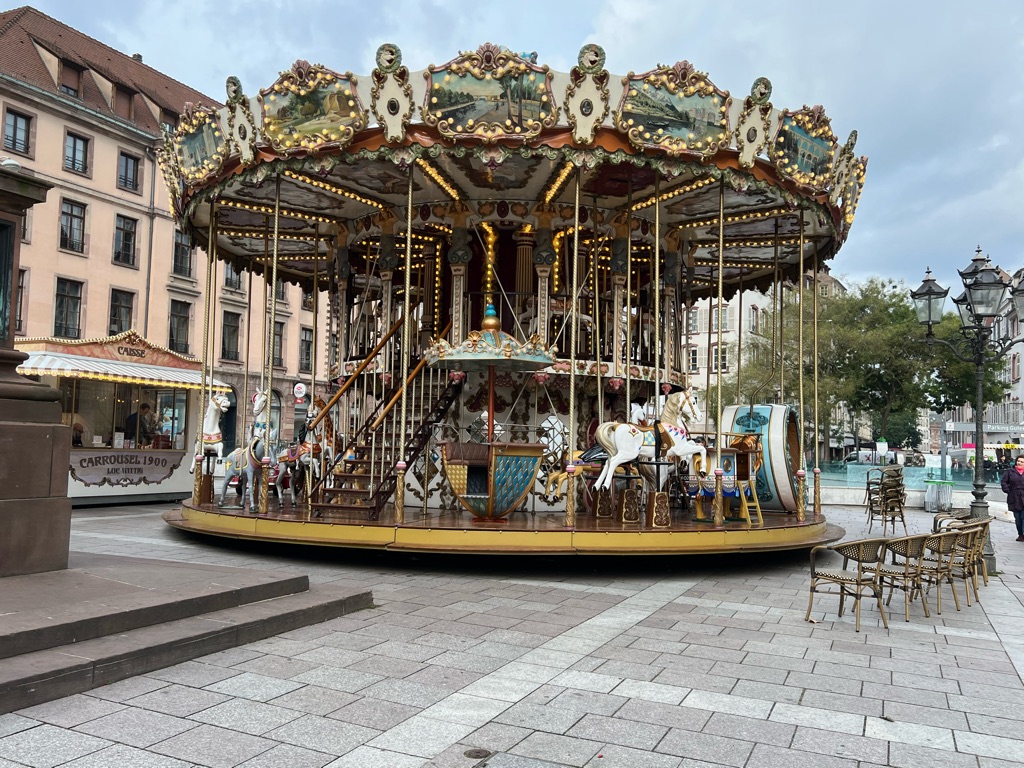
We made our way to La Petite France, all are with original timber houses from the 1500s are still lived in today.
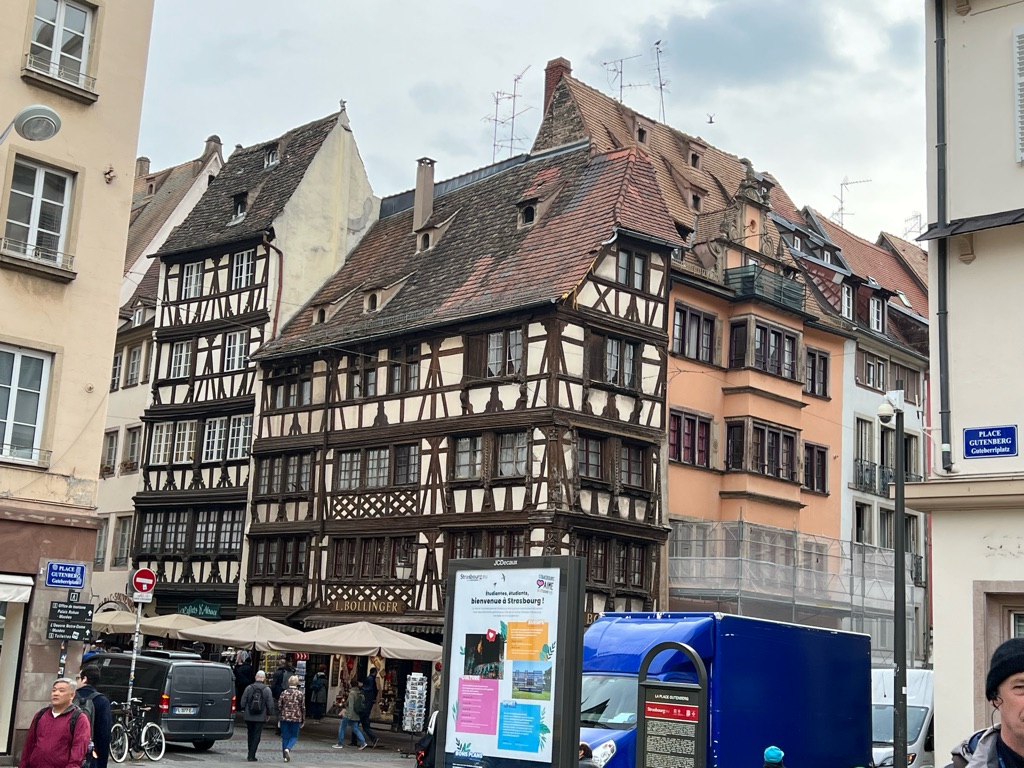
These homes contained shops in the ground level that needed the swift waters of the river such as millers, laundries, clothing dyes, and leather makers. The shops no longer exist, but it is easy to imagine.
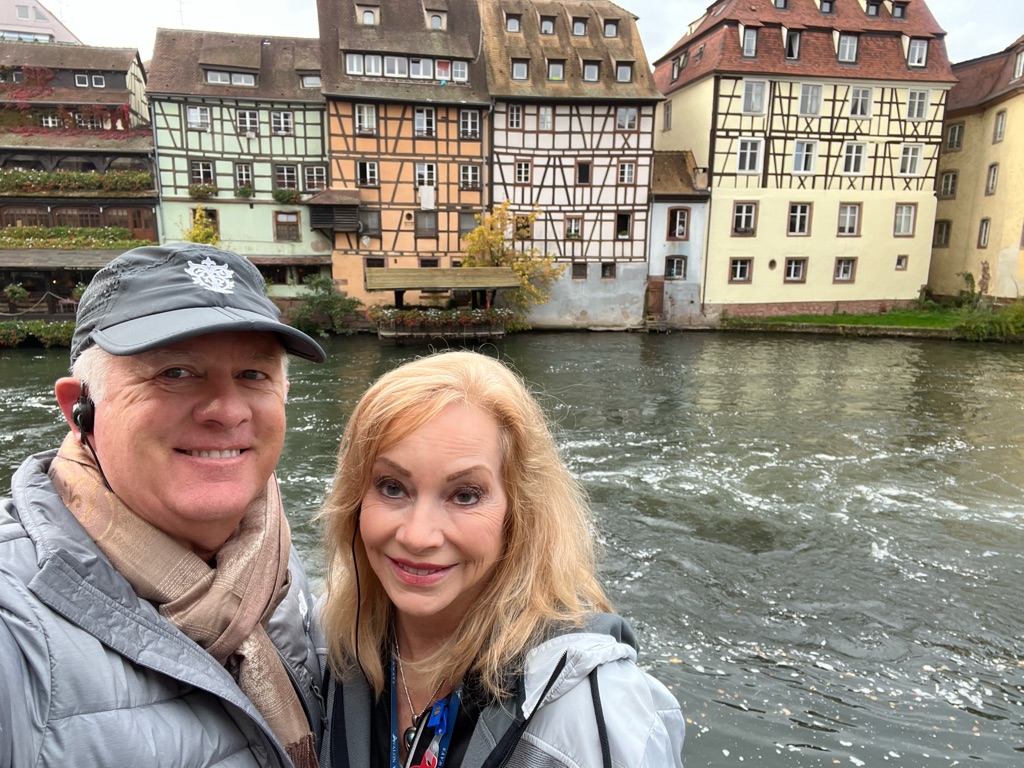

The swift river actually drops over a 6 foot waterfall, but the river is also a navigable waterway. So there is an old wooden lock that is still used.
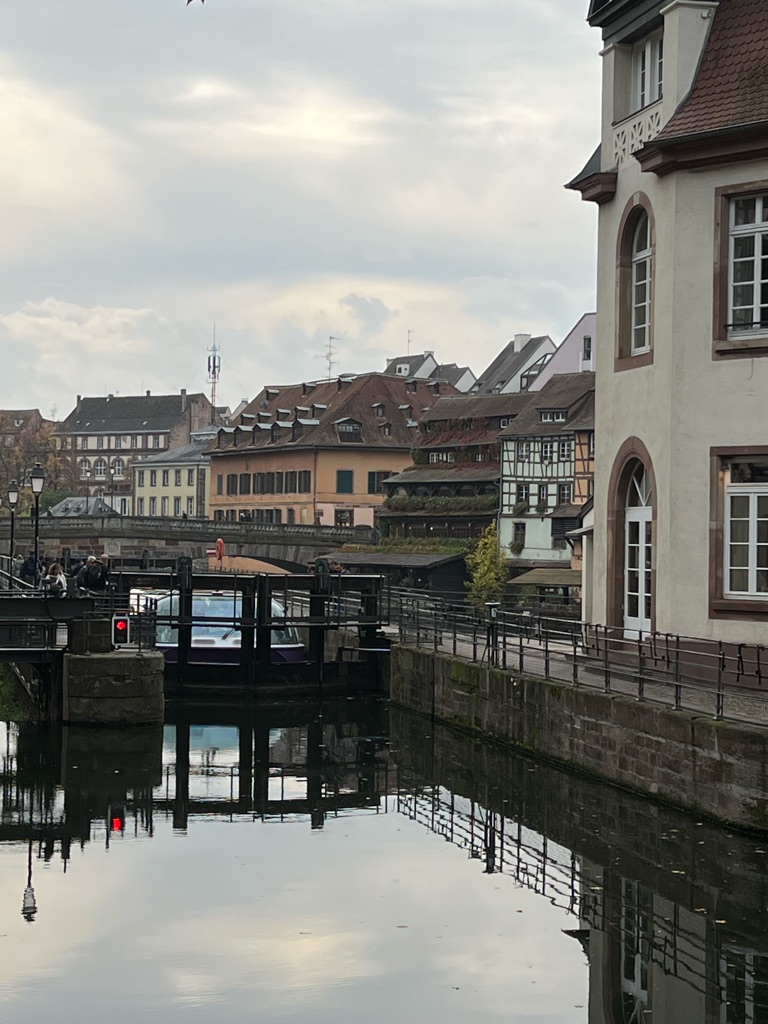
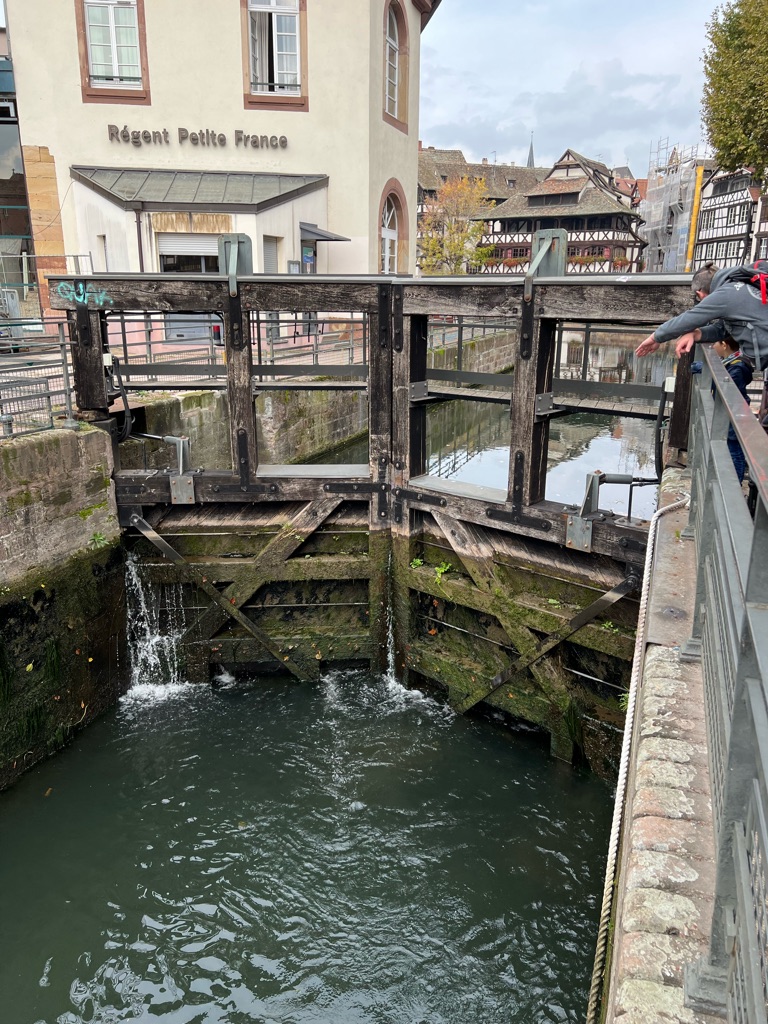
The Maginot Line
Avalon Riverboat line is the only line offering tours of this post WWI memorial. The Maginot Line, \240named after the French Minister of War André Maginot, is a line of concrete fortifications, obstacles and weapon installations built by France in the 1930s to deter invasion by Germany and force them to move around the fortifications.
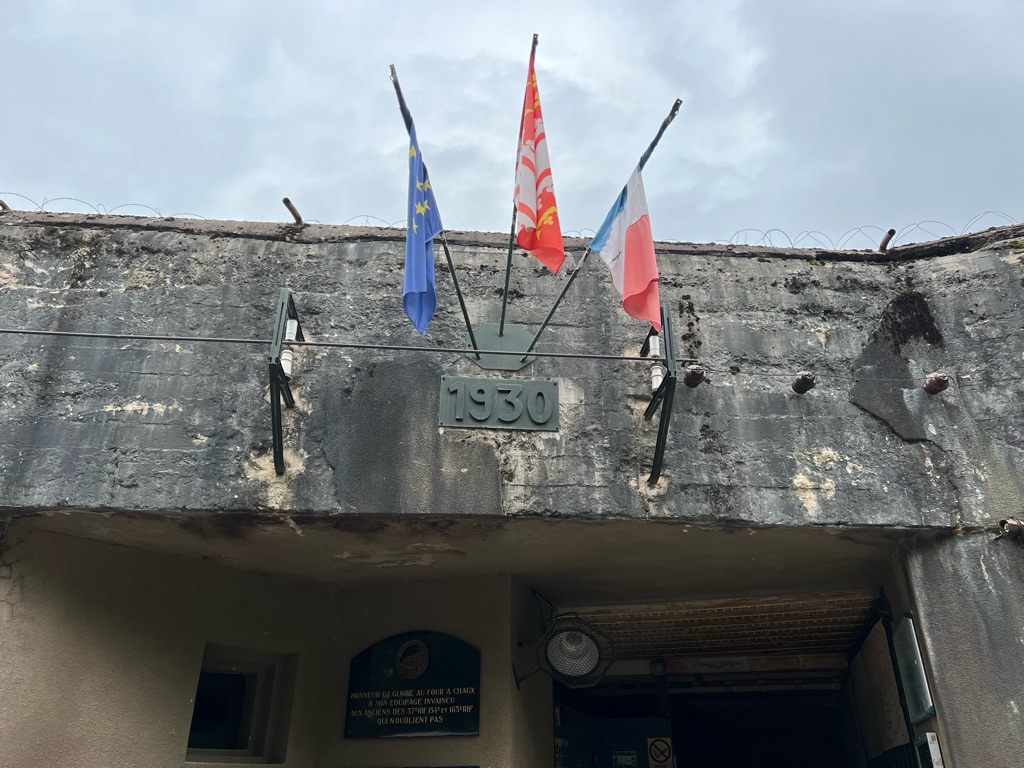
The Maginot Line was designed to be \240 invulnerable to aerial bombings and tank fire; it featured underground railways as a backup.

It had state-of-the-art living conditions for garrisoned troops, supplying air conditioning and eating areas for their comfort. The kitchen was small, but totally modern for the time, using electricity for the stove, oven, and 80 gallon coffee pots when homes at the time still used wood and gas.
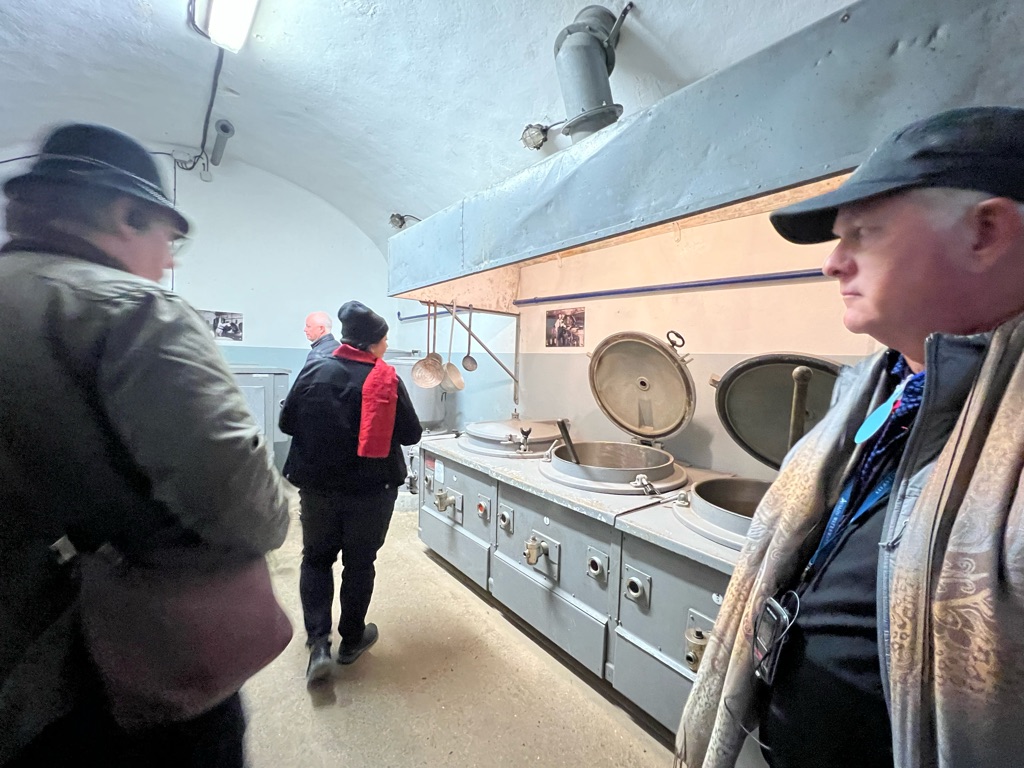
The fortress could store enough food, supplies, ammunition, and fuel to maintain a full battalion for 3 months.
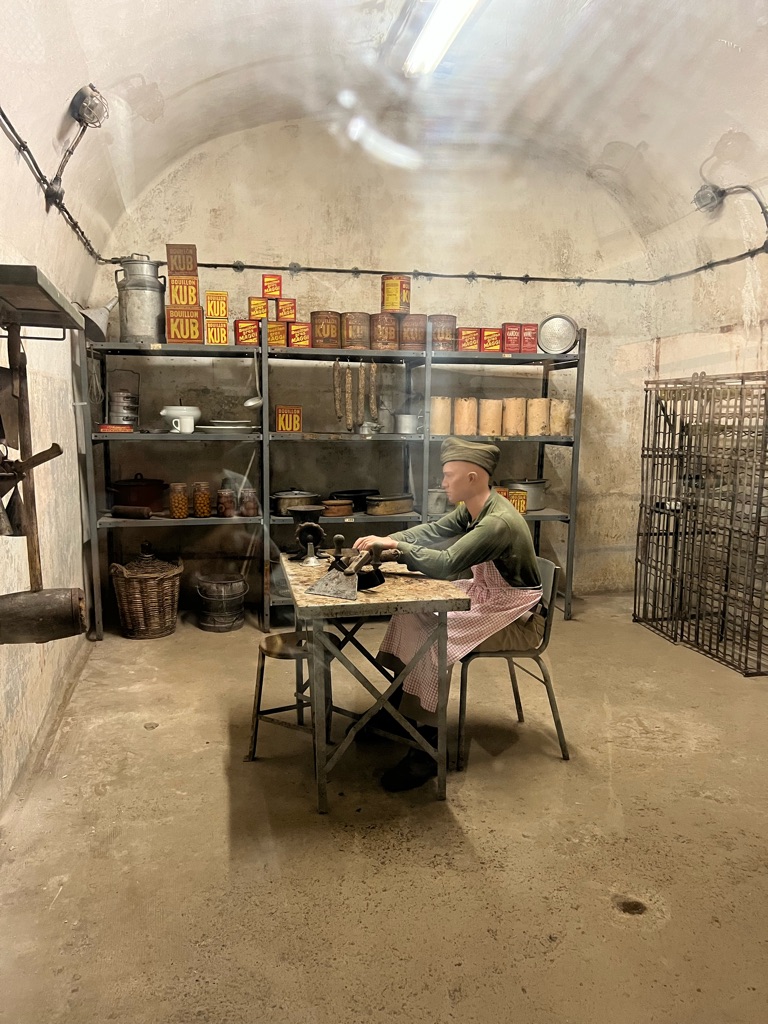
It had a hospital with a full time physician and a part time dentist. The medical suites contained x-ray machines and state of the art surgical facilities.
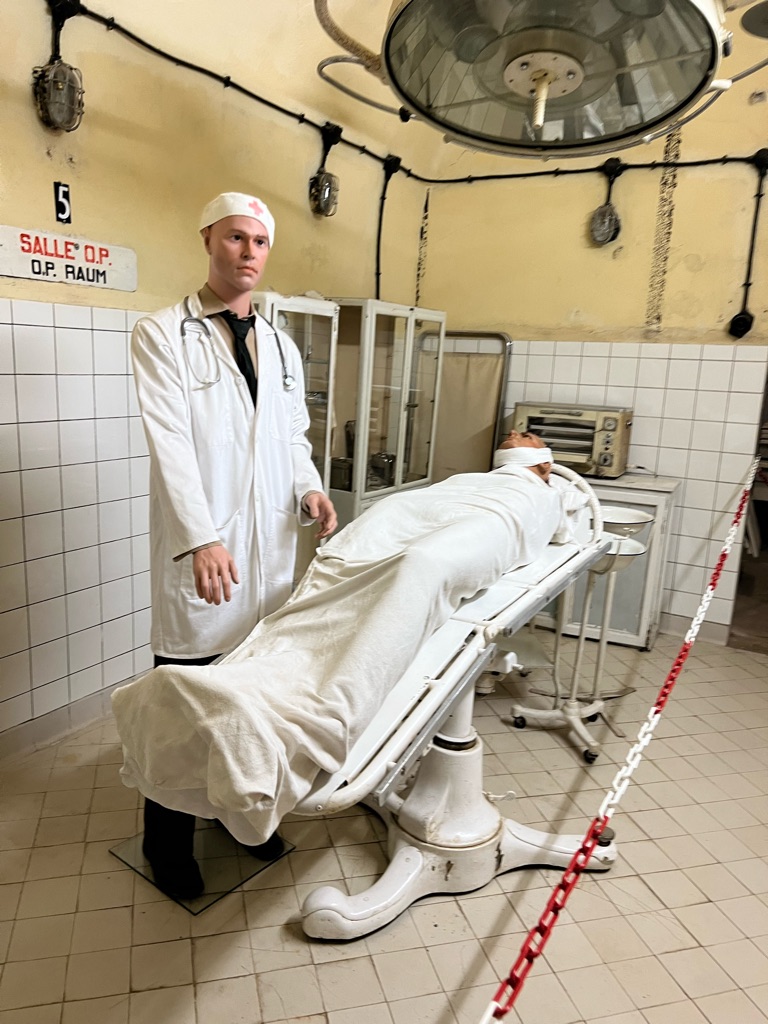
With the fortress completely underground, the commands content relied on communication with lookout towers on the surrounding hills. Cuttings were then telephoned or telegraphed to the commands center.

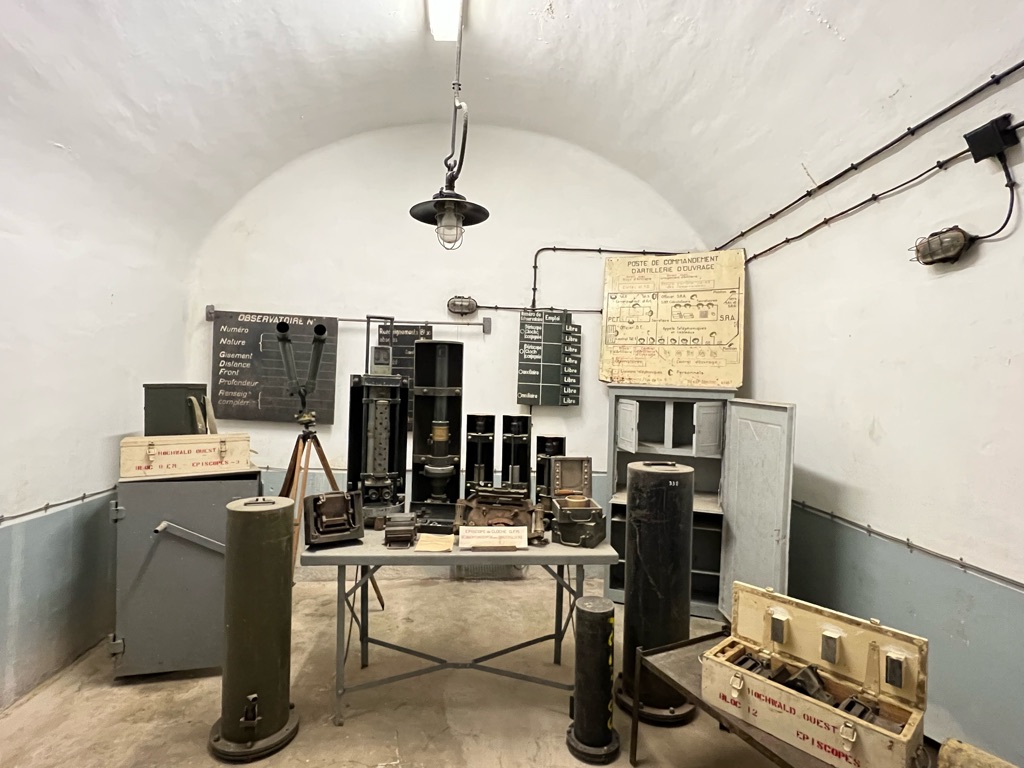
There were many networks of tunnels or galleries connecting battalions within the fortress, all of them with tracks to allow supplies to pass from one area to another.

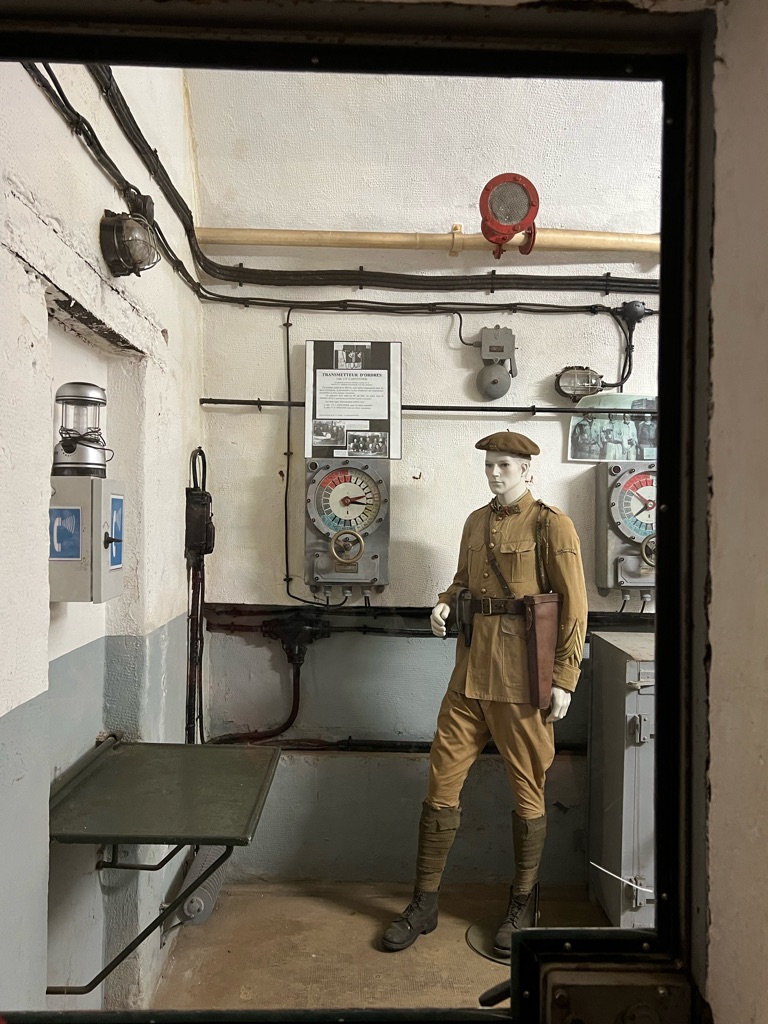
We climbed 100 steps to the gun turret which exists in a low dome on the top of the hill. When the turret is in ‘peacea’ position the dune is closed. But when the turret is in use, it raises up about 3 feet to allow the guns to fire.
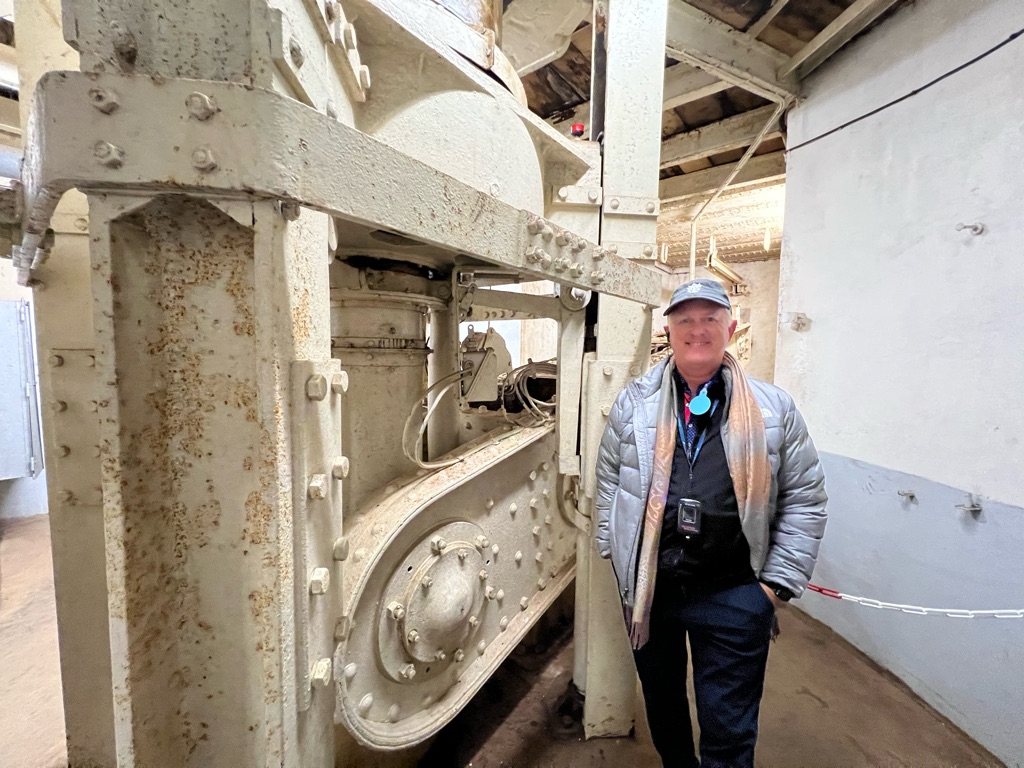
Here is the network of tunnels.

And here is our guide who is a volunteer and who is very knowledgeable about the history of WWI and WWII in the region. She talked us through the function of the Maginot Line, how it changed from French ownership to German ownership in WWII, and what happened to the French soldiers who were now living in German-controlled lands (they were eventually sent to the Russian front!)

Our group split up for our last day of touring.
Dana and Tom stayed aboard and enjoyed an empty ship and get some work done. (They had already visited the tour sites on their last trip!)
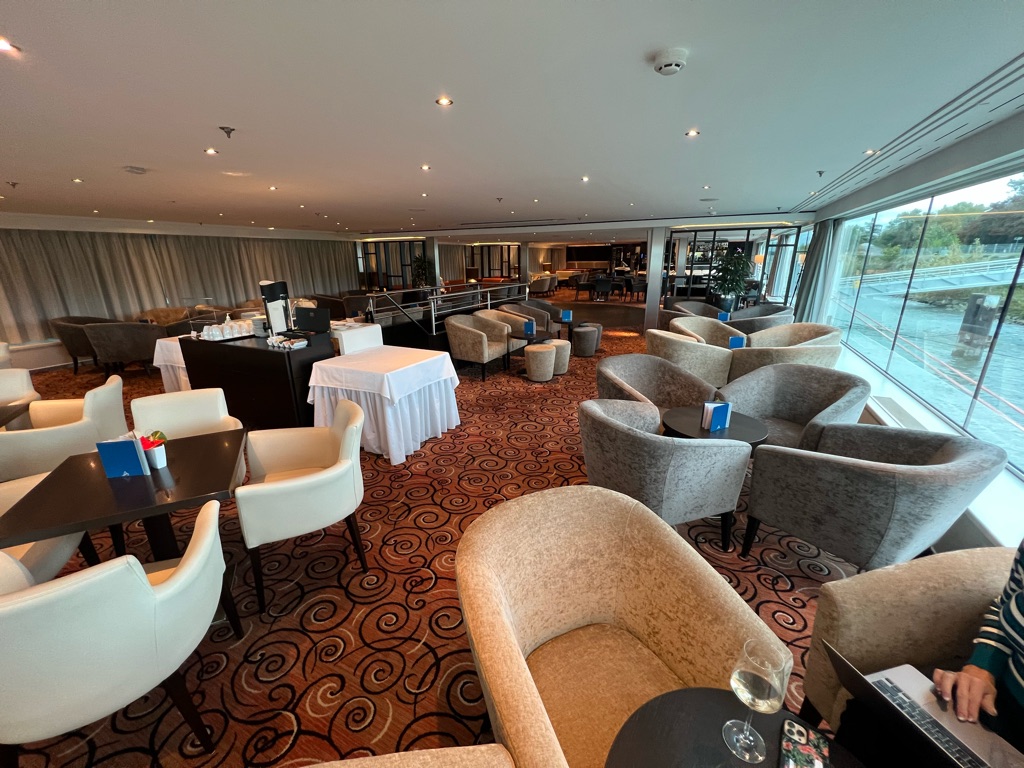
Linda and Joe toured the town of Colmer, France. The city is on the Alsace Wine Route, and local vineyards specialize in Riesling and Gewürztraminer wines

The old town has cobblestone streets lined with half-timbered medieval and early Renaissance buildings.
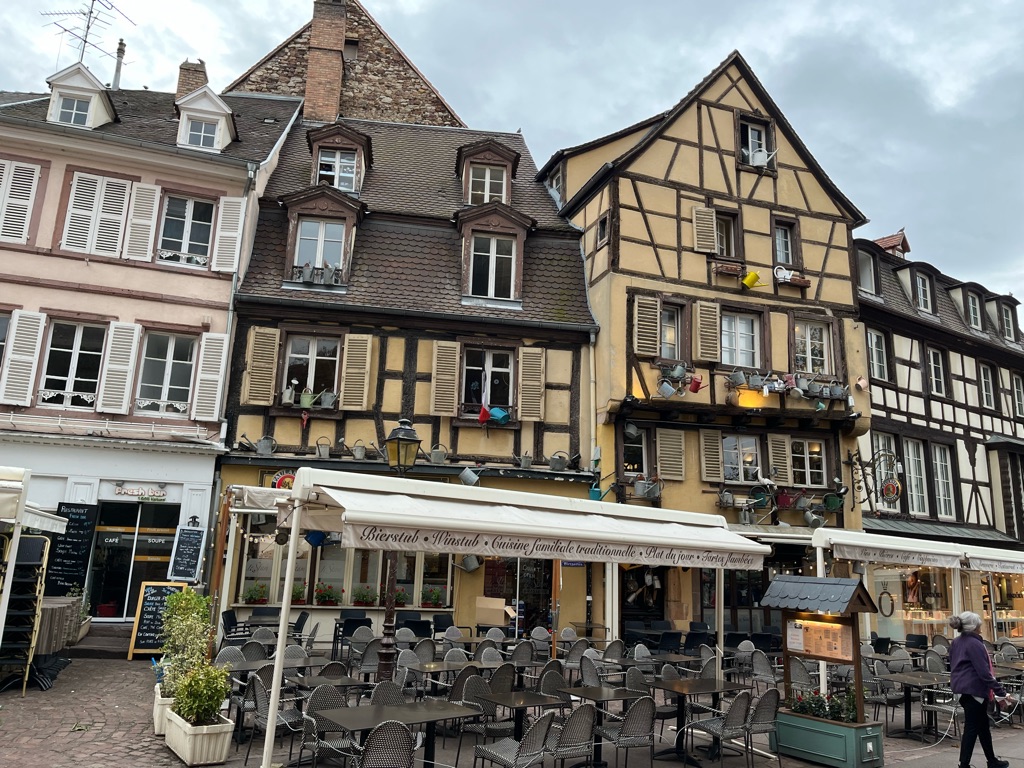
The Gothic 13th-century, Eglise Saint-Martin church stands on central Place de la Cathédrale.
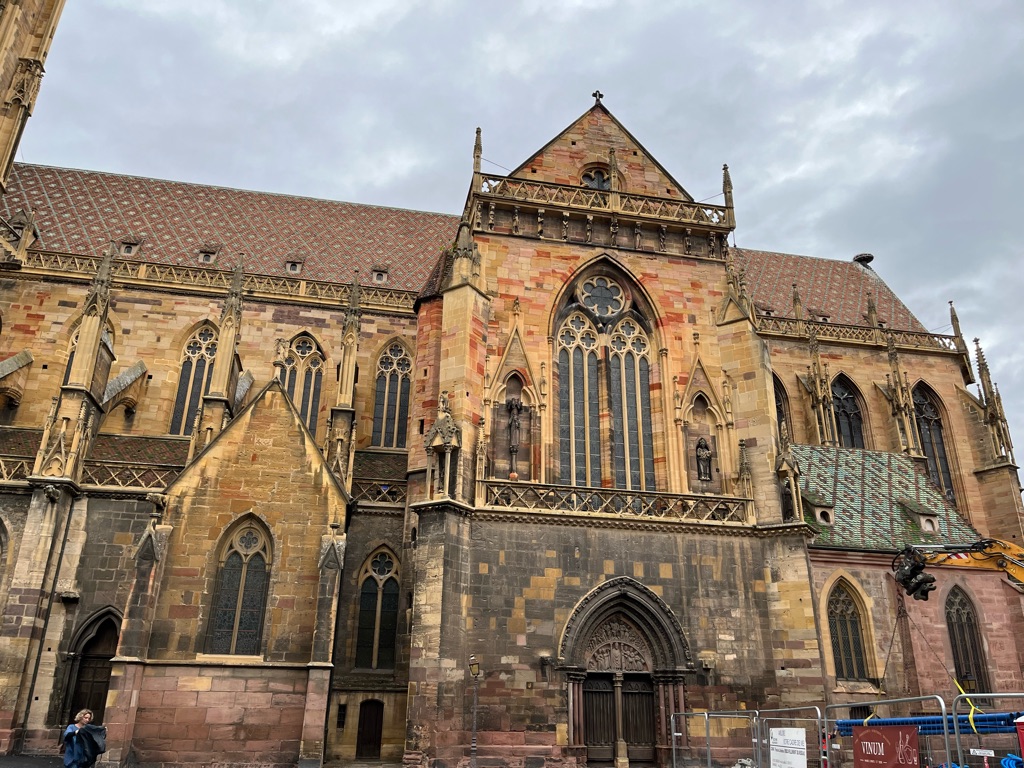
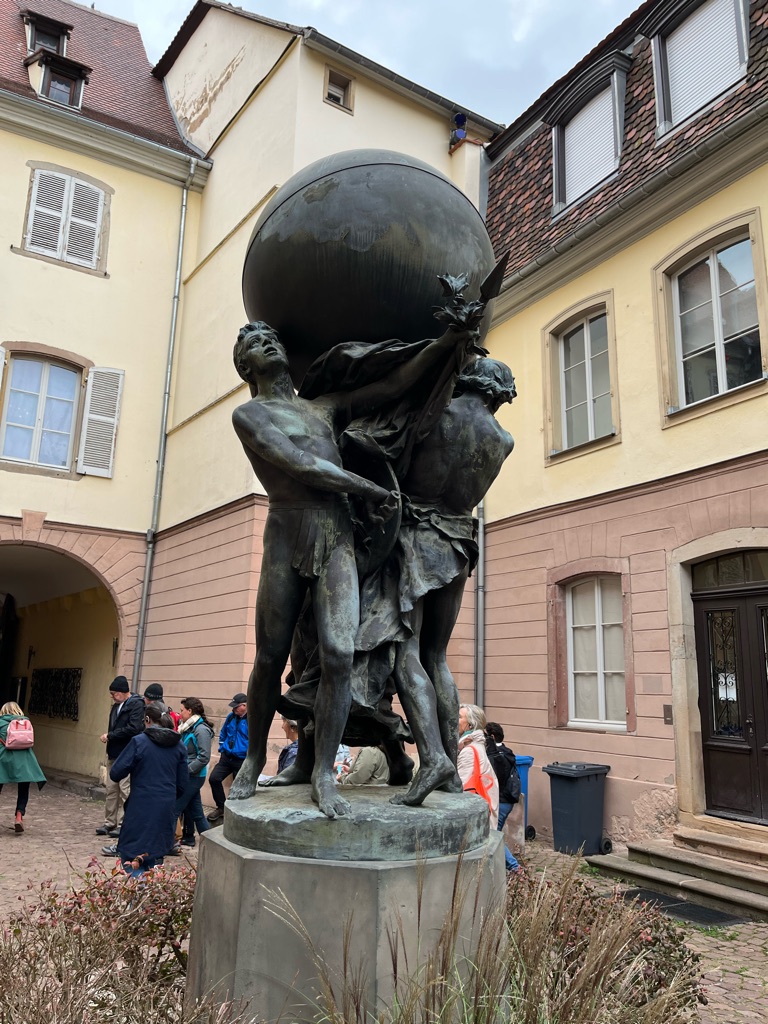
The season for Christmas Markets is approaching and the windows were dressed to entice visitors to enter and celebrate!
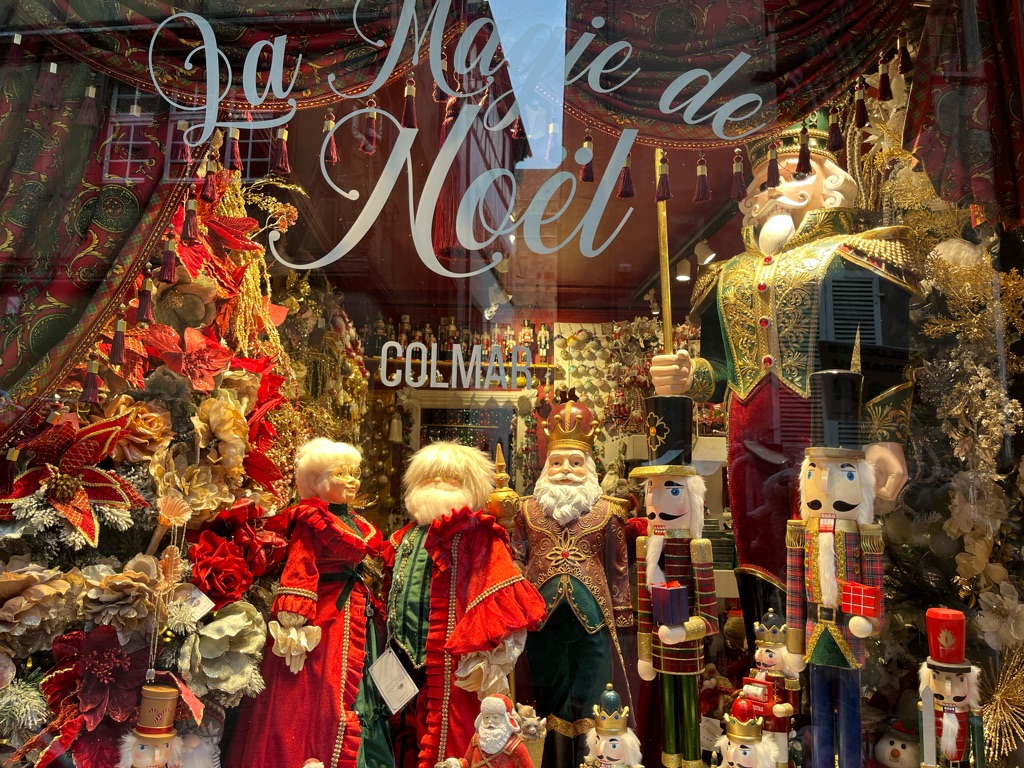
The Renaissance houses were distinctly different that those in other parts of France. Here is one that in heavily painted!
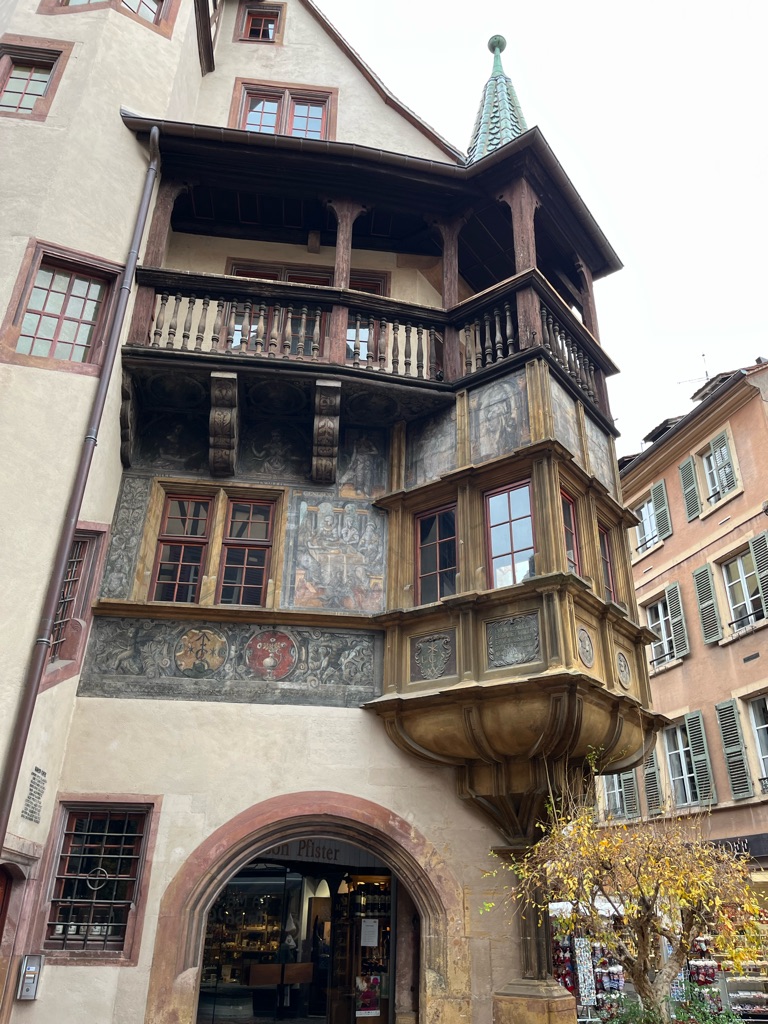
And this one is decorated with big plastic flowers!

But regardless of the decoration, the colors and creativity made for a perfect photo moment!

The people were decorated too! This lady is resplendent in \240pink, including pink purse, boots, and shopping bag!
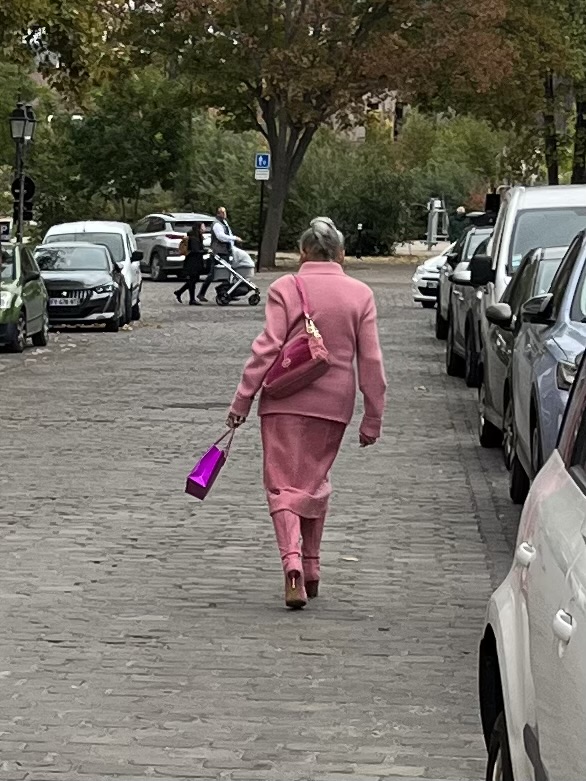
Meanwhile, Mary Ann and Willis braved the drizzle to venture into the Black Forest where they visited a working model of a farm that replicates there 1600s!
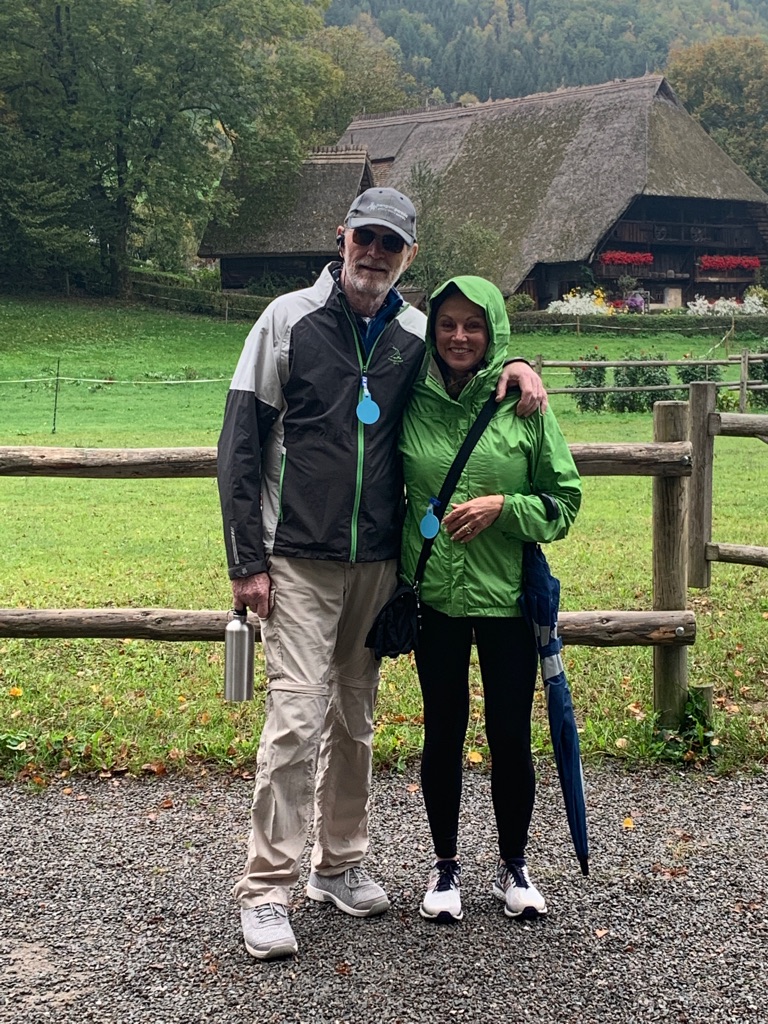
Houses are characterised externally by a long hipped or half-hipped roof that descends to the height of the ground floor. This type of dwelling is suited to the conditions of the Black Forest: hillside locations, broad tracks, high levels of snowfall and heavy wind loading
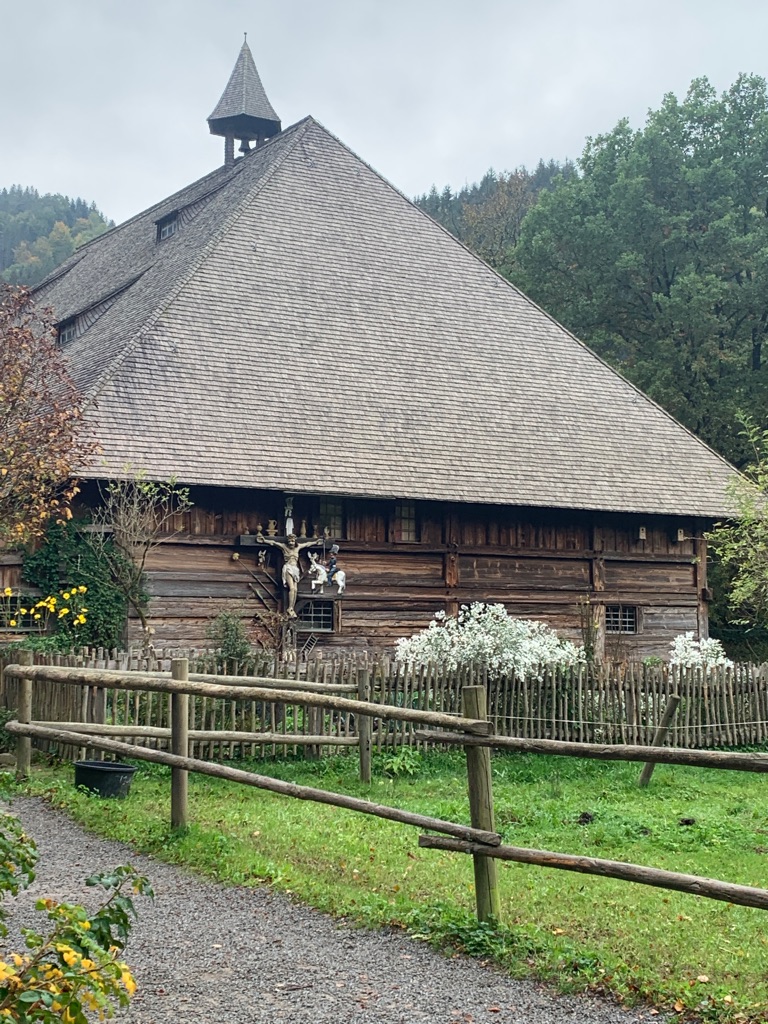
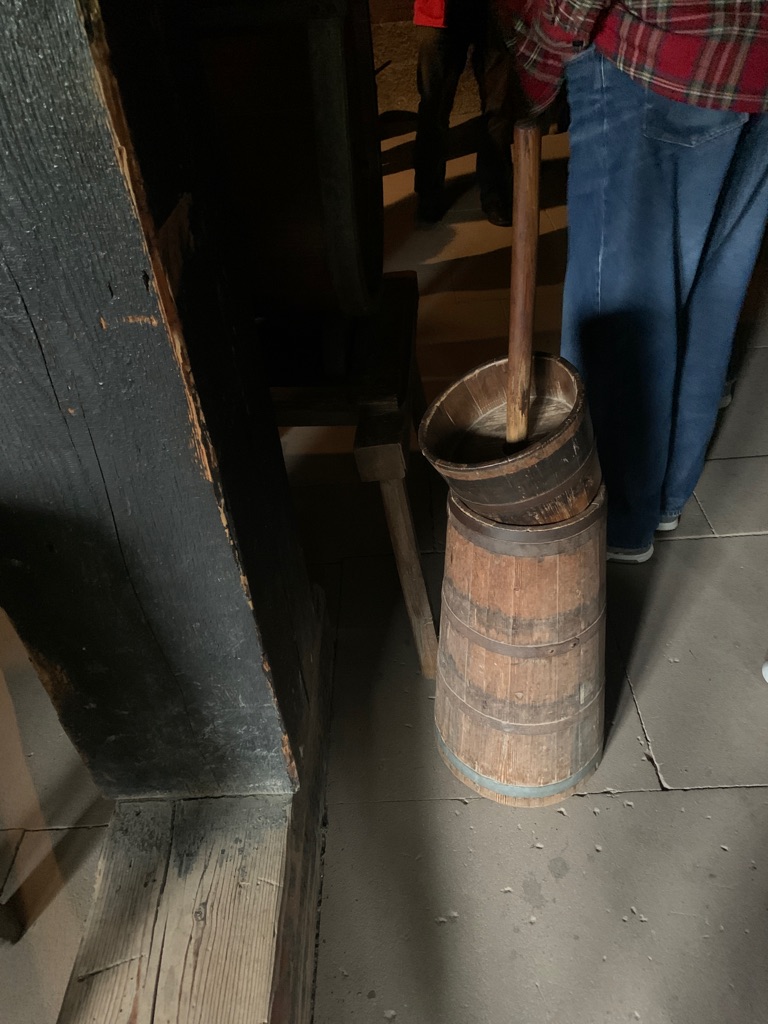
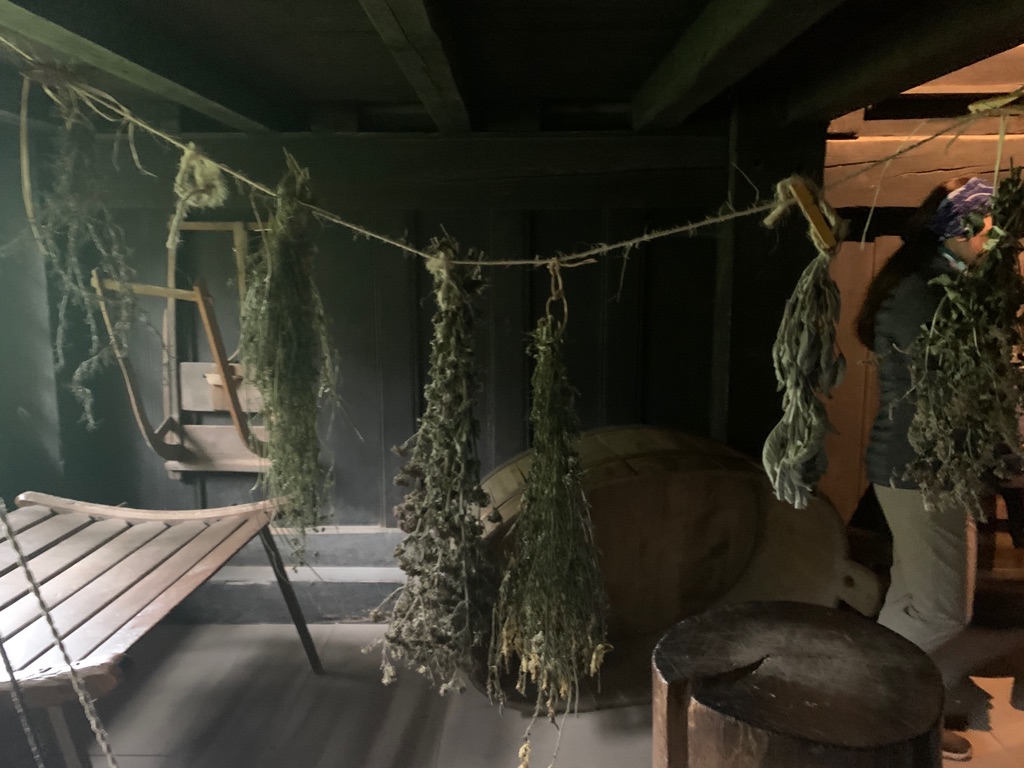
There are few windows to protect from the cold, but that also meant little little and poor ventilation. The average age that a woman love to was 30 years and died \240of lung disease. \240 Men, who worked in the open fields lived longer!

And there were plenty of COO-COO-clocks to be found!

Here is Willis contemplating an engineering problem!
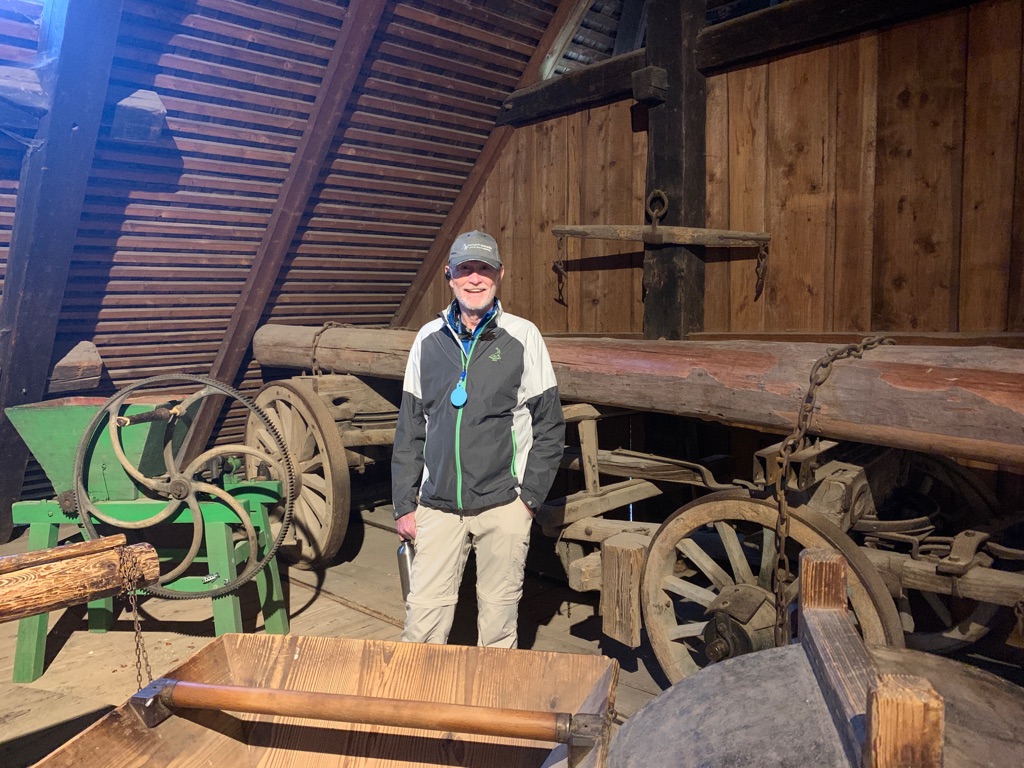
Here is a lady in typical costume of the times!

Everyone returned back to the shop to find Linda and Joe’s cabin decorated to celebrate their anniversary. We also found invitations in our rooms to join them for cocktails and dinner.
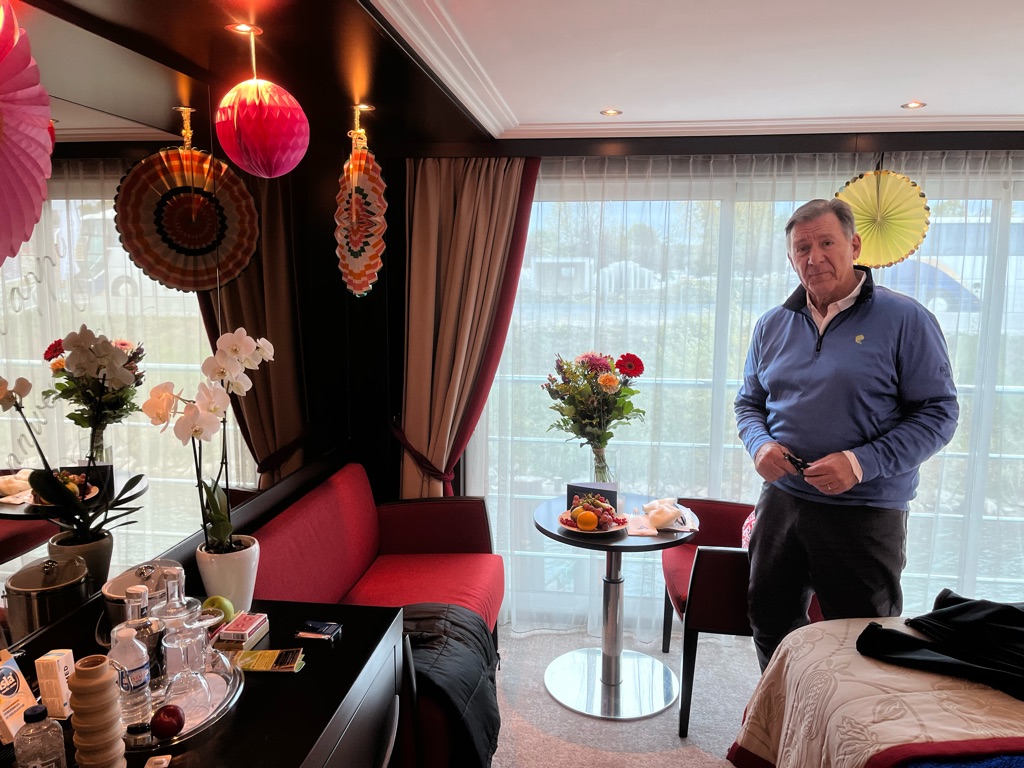
The ship’s kitchen staff has been working with Linda to accommodate her dietary restrictions … and they went all out with an anniversary cake that was not only lactose and gluten free … but delicious!!
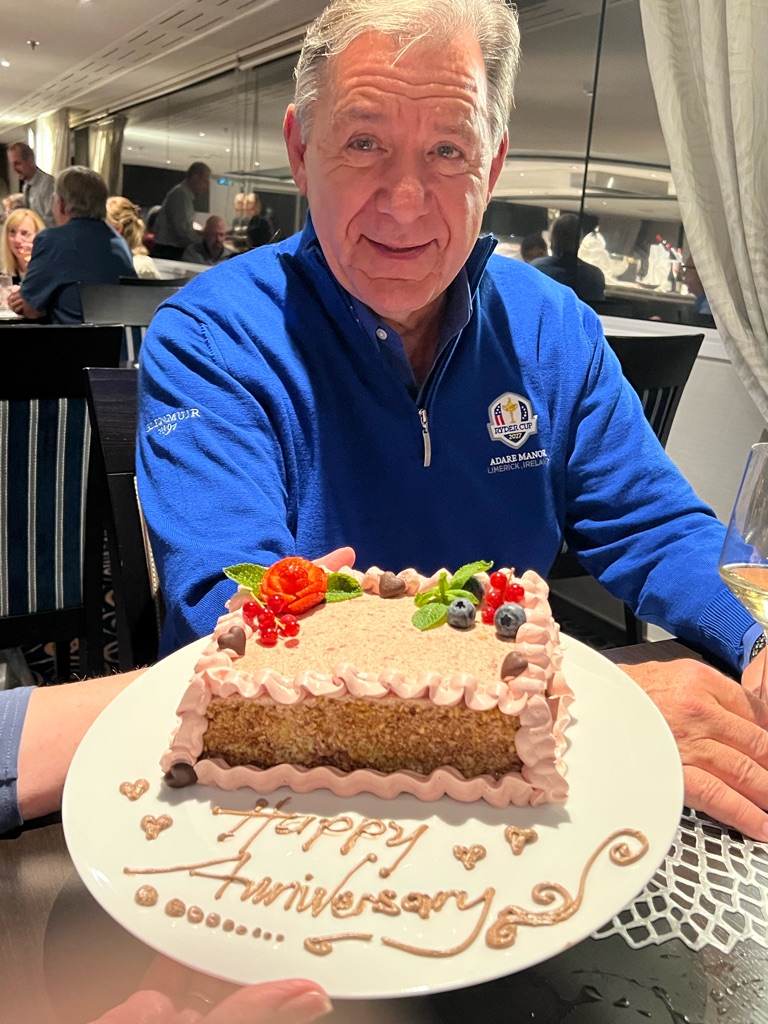

We all met for breakfast on our last day before heading out to our individual adventures. We’ll all meet back on 30A to share stories and relive \240our journey up the Rhine River!
